Architizer’s Tech Directory is a database of tech tools for architects — from the latest generative design and AI to rendering and visualization, 3D modeling, project management and many more. Explore the complete library of categories here.
Planning to upgrade your workstation for the new year? Looking to invest in a quality device that will assist in all your real-time visualizations, renderings and photo editing? We are back with our annual catalog of laptops and mobile workstations best suited for architects and designers. With work from home continuing to triumph, the necessity for a well-performing laptop remains true. But even more so for architects, who require ample storage, great processors and advanced graphic cards for their dynamic types of work. Luckily, there’s a great lineup of newly released devices to pick from, and there’s something for everyone.
Without further ado, here are the best picks from this past year:
Architizer Journal is reader-supported. When you buy a laptop or any other product through Amazon links on our site, we may earn an affiliate commission. Learn more.
Premium Laptops for Architects
Best High-End Upgradeable Laptop for Architects
 What sets the MSI Titan 18 apart in the premium laptop category is its exceptional upgradability. Designed with future-proofing in mind, it supports up to 192GB of DDR5 RAM and additional PCIe Gen 5 storage, giving architects the flexibility to scale their hardware as project demands grow. This makes the Titan 18 not just a high-end laptop, but an investment in long-term performance.
What sets the MSI Titan 18 apart in the premium laptop category is its exceptional upgradability. Designed with future-proofing in mind, it supports up to 192GB of DDR5 RAM and additional PCIe Gen 5 storage, giving architects the flexibility to scale their hardware as project demands grow. This makes the Titan 18 not just a high-end laptop, but an investment in long-term performance.
At its core, the Intel Core i9-14900HX processor and NVIDIA RTX 4090 GPU deliver unparalleled power for demanding architectural workflows, such as rendering lifelike visuals, running complex BIM simulations or handling resource-intensive software like Revit, Rhino and 3ds Max.
Its 18-inch 4K mini LED display offers outstanding color accuracy and sharpness, making it ideal for detailed modeling and photo-realistic renderings. The 128GB DDR5 RAM and 4TB SSD in its base configuration ensure smooth multitasking and ample storage, even for massive project files. The Titan 18 also features an advanced cooling system, keeping performance consistent during long work sessions without disruptive fan noise.
See more info and buy >
Best Extreme Power Laptop for Architects
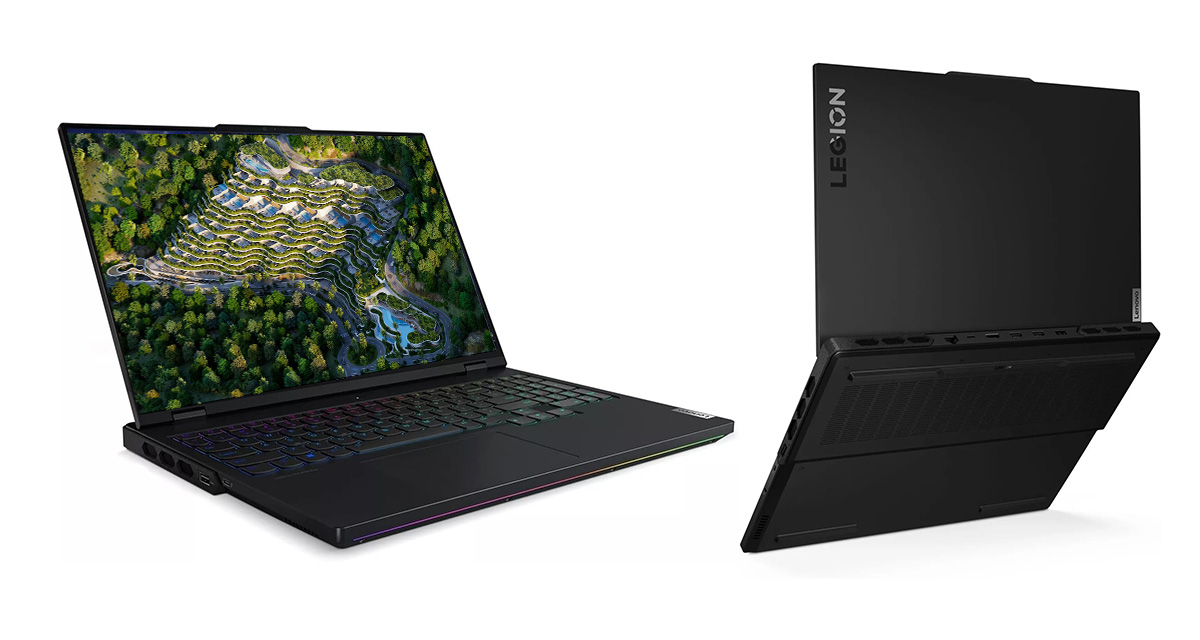 The Lenovo Legion Pro 7i is a premium choice for architects needing professional-grade performance with a focus on raw power. Equipped with an Intel i9-14900HX processor and NVIDIA RTX 4080 GPU, it excels in demanding workflows, such as rendering, 3D modeling and BIM applications, making it a reliable powerhouse for intensive architectural tasks.
The Lenovo Legion Pro 7i is a premium choice for architects needing professional-grade performance with a focus on raw power. Equipped with an Intel i9-14900HX processor and NVIDIA RTX 4080 GPU, it excels in demanding workflows, such as rendering, 3D modeling and BIM applications, making it a reliable powerhouse for intensive architectural tasks.
Its 16-inch QHD+ display with a 240Hz refresh rate delivers sharp, fluid visuals, ideal for managing intricate designs or presenting projects with clarity. Starting with 64GB DDR5 RAM and 4TB of SSD storage, the Legion Pro 7i offers the capacity and speed to handle large-scale projects effortlessly, while its advanced cooling system ensures consistent performance during extended sessions.
For architects balancing high demands with practicality, the Legion Pro 7i is one of the most versatile premium options in Lenovo’s lineup. However, those seeking even greater power and cutting-edge features may consider the Legion 9i — a premium option tailored for elite users handling the most demanding workflows.
See more info and buy >
Best Large Screen Laptop for Architects
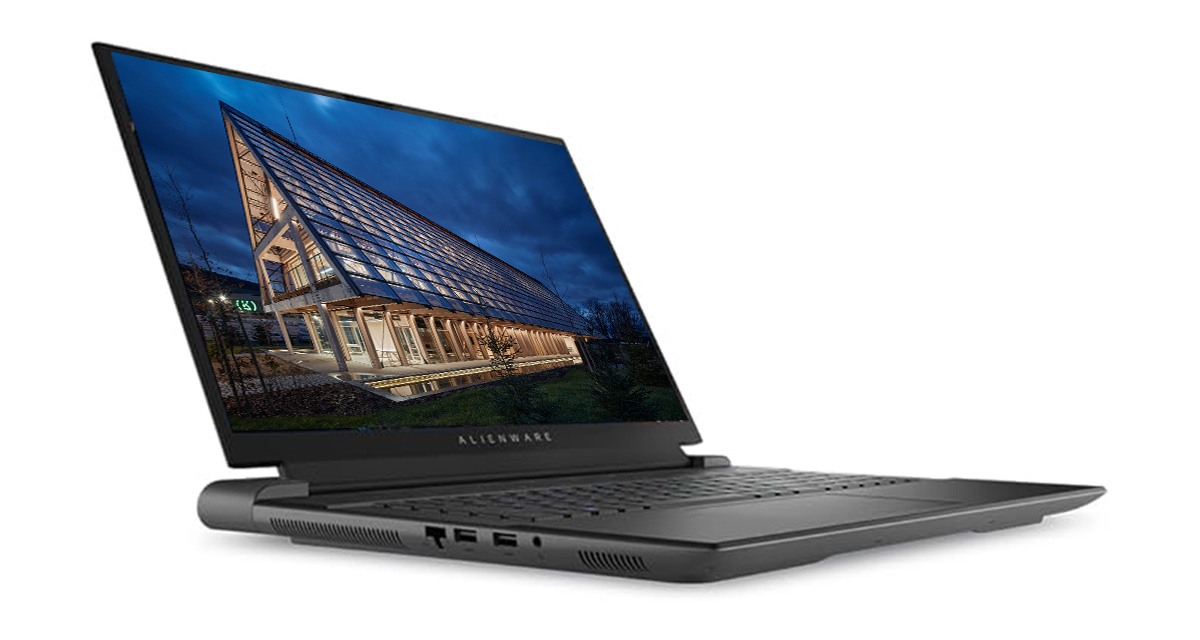 For architects who prioritize a vast, detailed display, the Alienware M18 R2 sets a new standard. Its 18-inch QHD+ screen offers 2560 x 1600 resolution and a 165Hz refresh rate, making it ideal for reviewing detailed drawings, refining renderings or multi-tasking across software windows without any issue.
For architects who prioritize a vast, detailed display, the Alienware M18 R2 sets a new standard. Its 18-inch QHD+ screen offers 2560 x 1600 resolution and a 165Hz refresh rate, making it ideal for reviewing detailed drawings, refining renderings or multi-tasking across software windows without any issue.
Beneath the hood, the Intel i9-14900HX processor and NVIDIA RTX 4090 GPU provide exceptional computational and graphical power, tackling tasks like large-scale BIM modeling, high-resolution rendering and real-time simulations effortlessly. With 64GB of DDR5 RAM and a 2TB SSD, this laptop ensures smooth performance and storage capacity for even the most complex projects.
Its build includes a comprehensive suite of ports—such as Thunderbolt 4 and HDMI 2.1—enabling integration with external monitors and peripherals. Designed for demanding workflows and extended use, the Alienware M18 R2 is the ultimate choice for architects seeking a screen-focused workstation that delivers both power and precision.
See more info and buy >
Best High-End Gaming Laptop for Architects
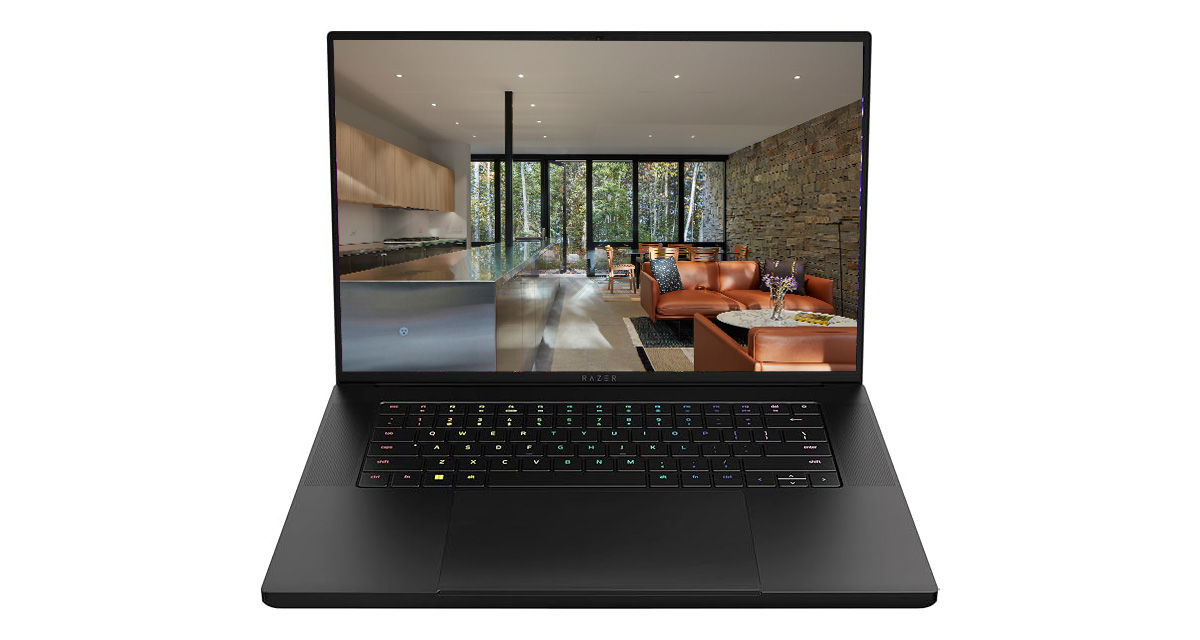 The Razer Blade 16 stands out among high-end gaming laptops for its balance of power and efficiency, delivering top-tier performance in a more streamlined form. Powered by a 14th Gen Intel Core i9-14900HX processor and NVIDIA RTX 4080 GPU, it’s built to handle demanding tasks like 3D modeling, rendering and complex simulations with precision and speed.
The Razer Blade 16 stands out among high-end gaming laptops for its balance of power and efficiency, delivering top-tier performance in a more streamlined form. Powered by a 14th Gen Intel Core i9-14900HX processor and NVIDIA RTX 4080 GPU, it’s built to handle demanding tasks like 3D modeling, rendering and complex simulations with precision and speed.
Its 16-inch OLED QHD+ 240Hz display offers breathtaking visuals, combining vibrant colors with fluid performance, making it ideal for architects perfecting their complex designs or presenting detailed projects. With 32GB of DDR5 RAM and a 1TB SSD, it’s well-prepared for intensive workflows and large file management.
The Blade 16 also incorporates advanced vapor chamber cooling to sustain peak performance during extended work sessions. For architects seeking premium power with a more refined and professional edge, the Razer Blade 16 is definitely a compelling choice.
See more info and buy >
Best High-End Portable Laptop for Architects
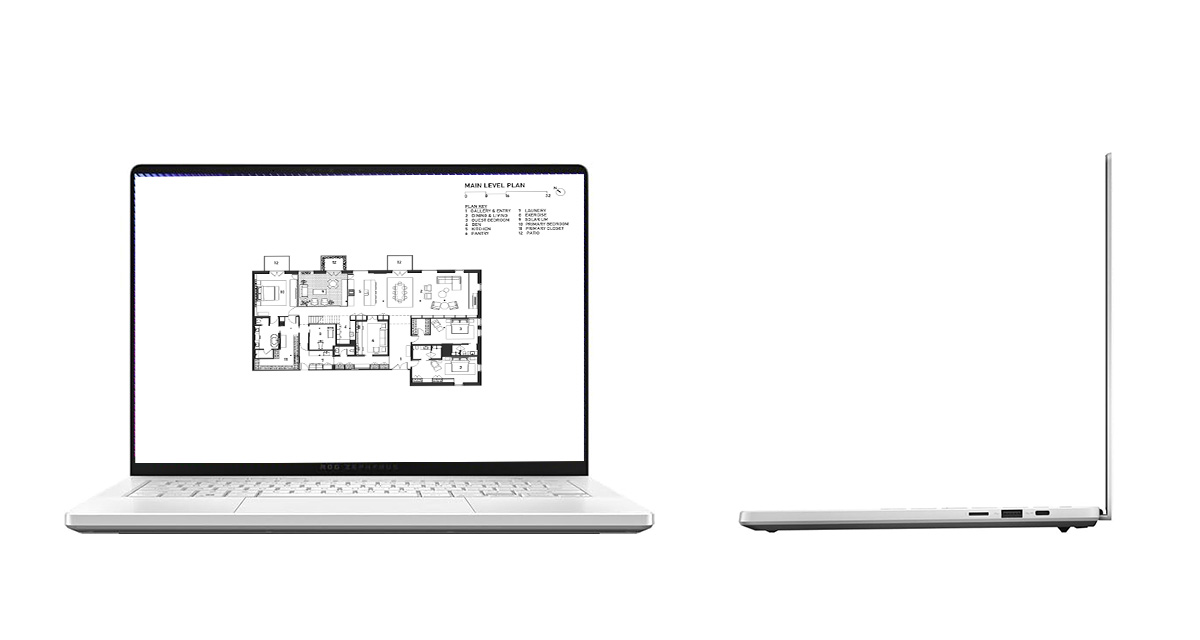 The ASUS Zephyrus G14 is a great choice for architects seeking both high-end performance and a portable, lightweight design. Powered by the AMD Ryzen 9 8945HS processor and NVIDIA RTX 4070 GPU, it delivers exceptional speed and graphical capability, perfect for 3D modeling, rendering and multitasking in software like Revit, SketchUp or Rhino.
The ASUS Zephyrus G14 is a great choice for architects seeking both high-end performance and a portable, lightweight design. Powered by the AMD Ryzen 9 8945HS processor and NVIDIA RTX 4070 GPU, it delivers exceptional speed and graphical capability, perfect for 3D modeling, rendering and multitasking in software like Revit, SketchUp or Rhino.
Its 14-inch OLED 2.8K 120Hz display provides sharp visuals and vivid colors, ensuring precision when working on detailed designs or reviewing projects. Despite its premium hardware, the G14 is remarkably compact and weighs significantly less than most high-performance laptops, making it easy to carry between meetings or job sites.
With 32GB of LPDDR5X RAM and a 1TB SSD, it’s equipped to handle complex workflows and large files. The Zephyrus G14 combines power, portability and premium features, offering architects a small but mighty workstation that’s perfect for those always on the move.
See more info and buy >
Best Laptop for Architects by Brand
Best Lenovo Legion Series Laptop for Architects
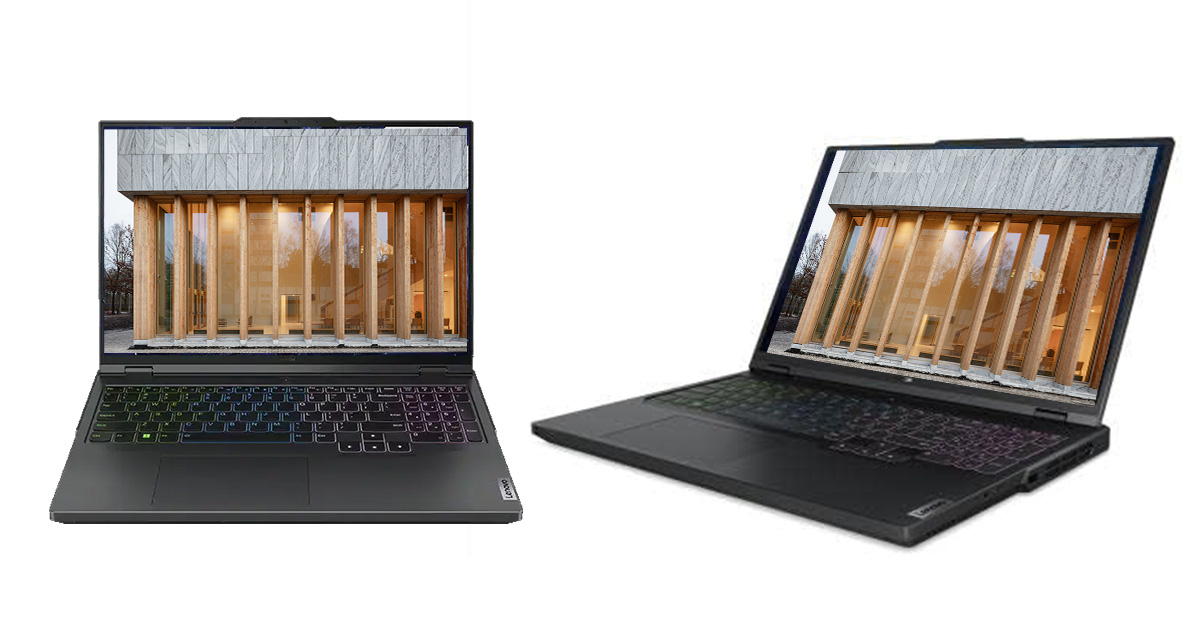 The Lenovo Legion Pro 5i is a Lenovo Legion model likely to appeal to a broader range of architects, both price-wise and performance-wise. Powered by a 14th Gen Intel Core i9-14900HX processor and NVIDIA GeForce RTX 4070 GPU, it delivers reliable capabilities for 3D modeling, rendering and BIM workflows.
The Lenovo Legion Pro 5i is a Lenovo Legion model likely to appeal to a broader range of architects, both price-wise and performance-wise. Powered by a 14th Gen Intel Core i9-14900HX processor and NVIDIA GeForce RTX 4070 GPU, it delivers reliable capabilities for 3D modeling, rendering and BIM workflows.
Its 16″ WQXGA display (2560 x 1600, 165Hz) provides sharp visuals and ample workspace for detailed design projects. Configurations start at 16GB DDR5 RAM and 512GB SSD, with upgrades available up to 64GB RAM and 4TB SSD, accommodating both moderate and intensive workloads. Features like Lenovo AI Engine+ for performance optimization and Coldfront 5.0 cooling for consistent operation make it a dependable choice.
With Windows 11 Pro, a numeric keypad and an included lifetime Office Pro license, the Legion Pro 5i offers high-end functionality at a price point suited to a wide audience of architects.
See more info and buy >
Best Lenovo Thinkpad Series Laptop for Architects
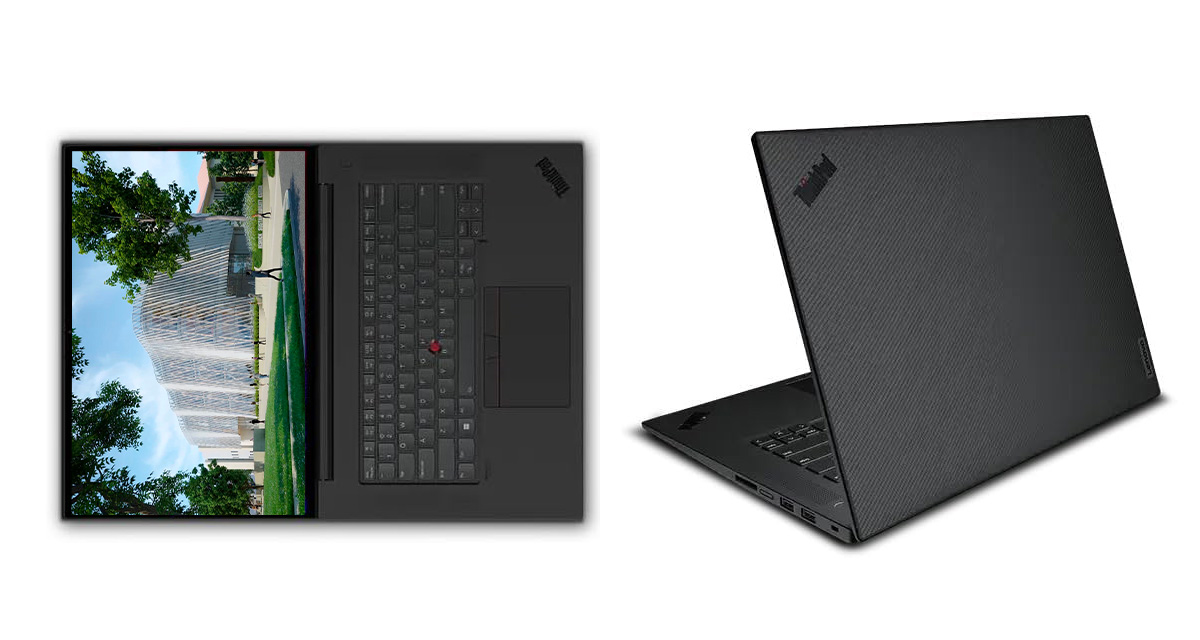 For architects who value reliability and professional-grade performance over gaming features, the Lenovo ThinkPad P1 Gen 6 is a standout choice. Designed with professionals in mind, this workstation is equipped to handle intensive tasks like CAD modeling, rendering and large-scale BIM workflows efficiently.
For architects who value reliability and professional-grade performance over gaming features, the Lenovo ThinkPad P1 Gen 6 is a standout choice. Designed with professionals in mind, this workstation is equipped to handle intensive tasks like CAD modeling, rendering and large-scale BIM workflows efficiently.
Powered by Intel’s 13th Gen processors and starting at 32GB of RAM (upgradeable for heavier workloads), the ThinkPad P1 Gen 6 offers ample power for resource-intensive applications such as AutoCAD, Revit or Rhino. Its NVIDIA RTX A-series GPUs are specifically built for professional use, ensuring accurate visual performance and optimized compatibility with architectural software.
The 16-inch display, available in multiple configurations including UHD+ and OLED options, provides excellent clarity and color fidelity—critical for precise design work. Despite its high-performance specs, the P1 maintains the durability and portability ThinkPad users expect, making it an excellent choice for architects frequently working on the go or between meetings.
See more info and buy >
Best ASUS Laptop for Architects
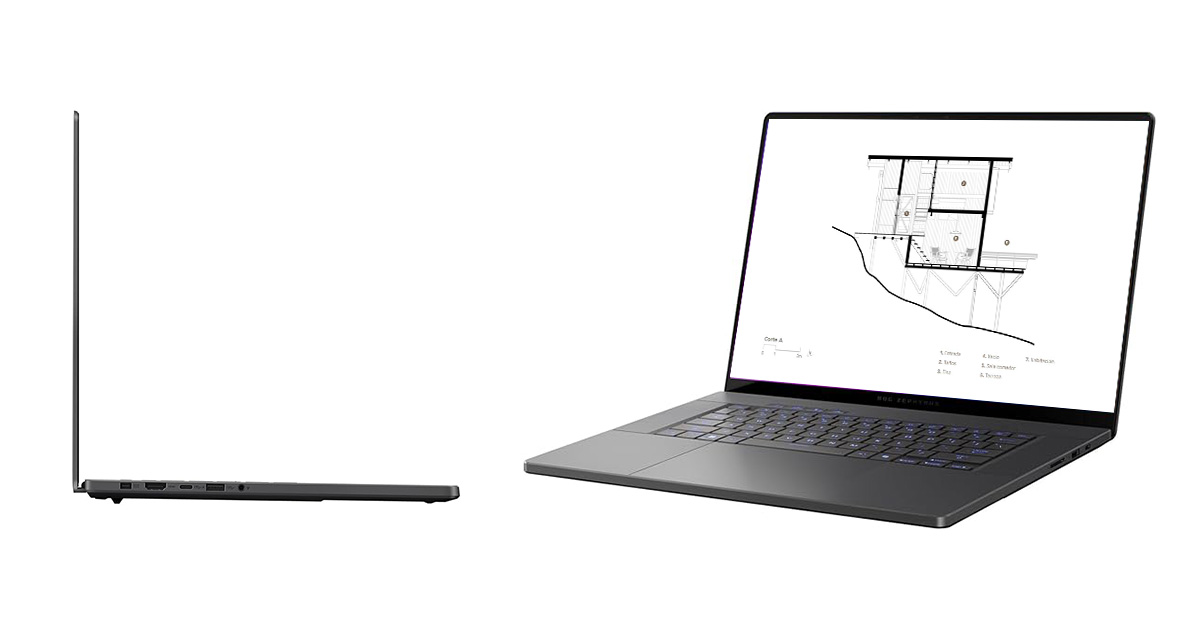 From the same series as the Zephyrus G14, the ASUS Zephyrus G16 offers a larger 16-inch OLED display, providing more screen real estate for architects who need precision and clarity for their designs. Its WQXGA 240Hz display is perfect for reviewing detailed drawings, rendering complex 3D models and managing large-scale projects with sharp visuals and excellent color fidelity.
From the same series as the Zephyrus G14, the ASUS Zephyrus G16 offers a larger 16-inch OLED display, providing more screen real estate for architects who need precision and clarity for their designs. Its WQXGA 240Hz display is perfect for reviewing detailed drawings, rendering complex 3D models and managing large-scale projects with sharp visuals and excellent color fidelity.
This version of the Zephyrus G16 features an AMD Ryzen AI 9 HX 370 processor, known for its efficiency and multitasking capabilities, making it an excellent choice for architects running intensive workflows in software like Revit or AutoCAD. For those who prefer Intel, the G16 is also available with Intel processors, giving professionals the flexibility to choose based on their specific performance needs or software optimization preferences.
Starting at 32GB of RAM and configurable up to 4TB SSD storage, this laptop handles resource-heavy tasks and large project files effortlessly. Its aluminum build keeps it lightweight (just 4 lbs) and the increased screen size compared to the G14 offers a more comfortable workspace for multitasking without sacrificing portability too much.
See more info and buy >
Best Apple Laptop (Macbook) for Architects

For architects who favor Apple’s ecosystem, the 2024 MacBook Pro with the M4 Pro chip delivers professional-grade performance. The M4 Pro’s 14-core CPU and 20-core GPU handle demanding tasks like 3D rendering, large-scale project compilation and intensive workflows with ease. For more advanced needs, the M4 Max chip offers even greater power.
Its 16.2-inch Liquid Retina XDR display provides high brightness (up to 1600 nits) and excellent color accuracy, making it well-suited for precise design work and presentations. Starting with 24GB of unified memory and 512GB SSD storage, it offers configurations for more extensive project requirements. A 14-inch option is also available, offering similar power in a more compact design for those who prioritize portability.
Optimized for macOS, this laptop integrates efficiently with design tools like Adobe Creative Cloud and Microsoft 365, while Apple Intelligence features improve productivity across devices. With all-day battery life and durable construction, the 2024 MacBook Pro is a reliable choice for architects who value performance and a connected ecosystem.
See more info and buy >
Best Dell Workstation for Architects
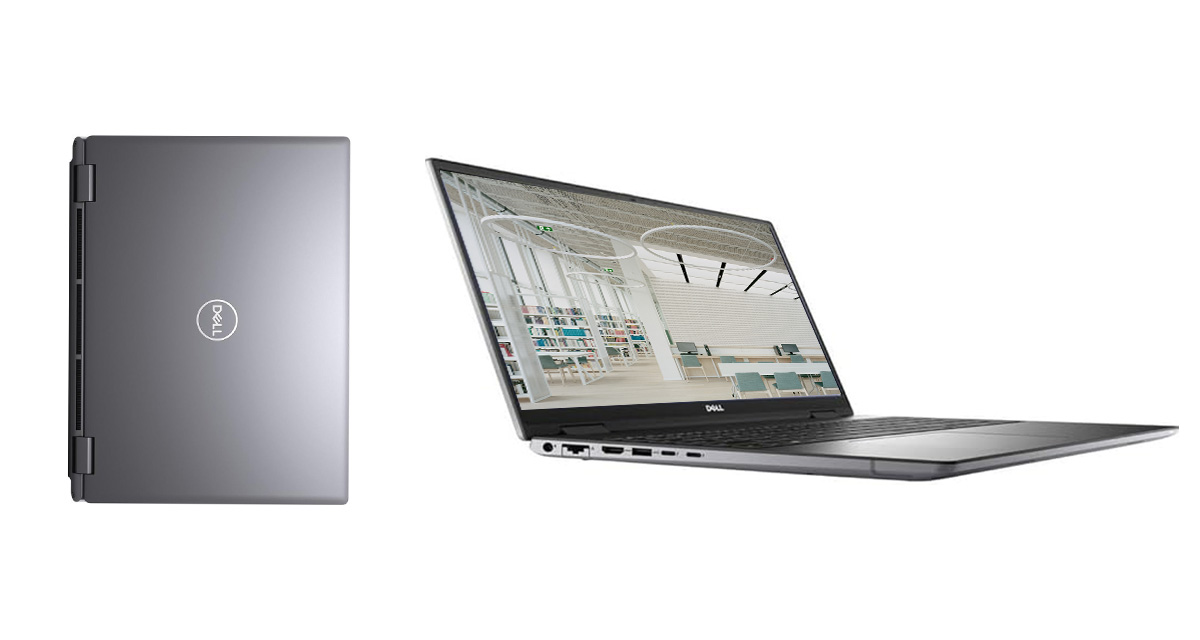 The Dell Precision 7680 stands apart as a workstation rather than a gaming laptop, catering specifically to architects who rely on professional-grade hardware for demanding workflows. Designed with stability and precision in mind, it’s a reliable choice for running applications like AutoCAD, Revit and Rhino that benefit from certified hardware and consistent performance.
The Dell Precision 7680 stands apart as a workstation rather than a gaming laptop, catering specifically to architects who rely on professional-grade hardware for demanding workflows. Designed with stability and precision in mind, it’s a reliable choice for running applications like AutoCAD, Revit and Rhino that benefit from certified hardware and consistent performance.
Powered by a 13th Gen Intel Core i7-13850HX processor with 20 cores, this workstation is built for heavy multitasking and computationally intensive tasks. Its NVIDIA RTX A2000 GPU (8GB) provides the graphical fidelity and optimization required for accurate rendering and simulation, ensuring smooth operation across professional software.
The 16-inch Full HD+ display (1920 x 1200) delivers sharp visuals, offering architects clarity for detailed design work. With 32GB DDR5 RAM and a 512GB SSD, the Precision 7680 is well-equipped for handling large files and resource-intensive applications.
See more info and buy >
Best Dell Gaming Laptop for Architects
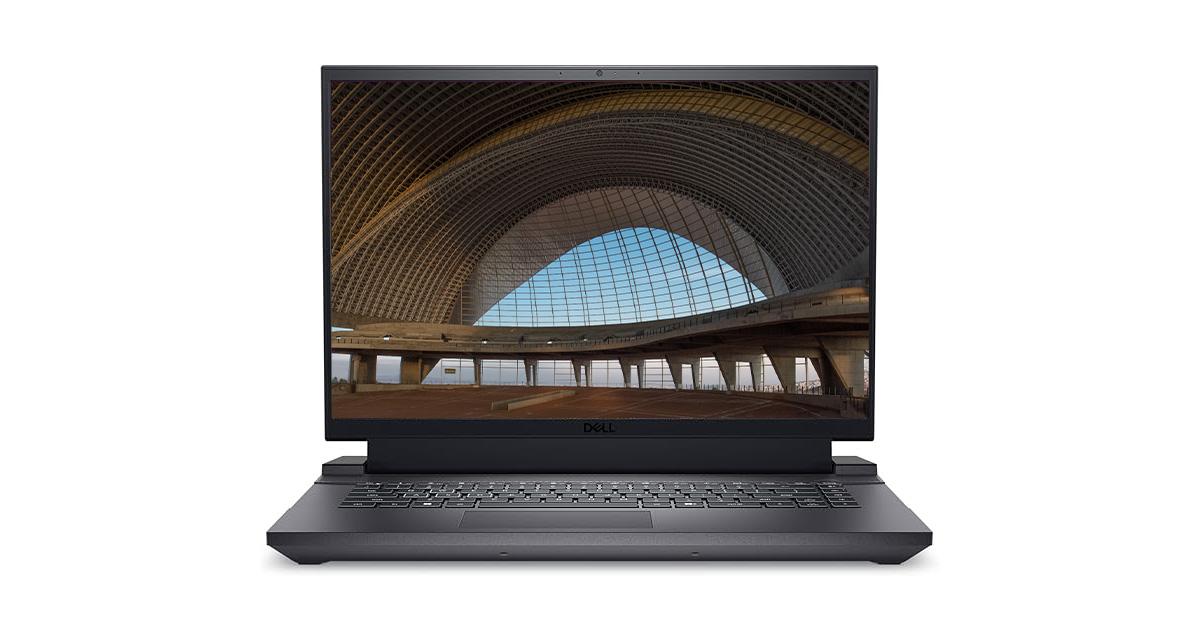 The Dell G16 strikes a balance between affordability and performance, making it an excellent choice for architects who need a capable workstation without the premium price tag. Powered by the 13th Gen Intel Core i9-13900HX processor and NVIDIA GeForce RTX 4070 GPU, it delivers solid performance for 3D modeling, rendering and architectural simulations in tools like Revit and Rhino.
The Dell G16 strikes a balance between affordability and performance, making it an excellent choice for architects who need a capable workstation without the premium price tag. Powered by the 13th Gen Intel Core i9-13900HX processor and NVIDIA GeForce RTX 4070 GPU, it delivers solid performance for 3D modeling, rendering and architectural simulations in tools like Revit and Rhino.
Its 16-inch QHD+ display offers a 240Hz refresh rate and sharp resolution, providing smooth visuals and precise clarity, whether you’re navigating detailed BIM models or showcasing your work. Starting with 16GB of DDR5 RAM and a 1TB SSD, the G16 is equipped to handle moderate workloads, with options to expand for more demanding projects.
Inspired by Alienware’s thermal design, the laptop includes advanced cooling features to maintain stable performance during extended sessions. With its Metallic Nightshade finish, the Dell G16 combines practical functionality with a modern design, making it an accessible yet powerful tool for architects on a mid-range budget.
See more info and buy >
Best HP Laptop for Architects
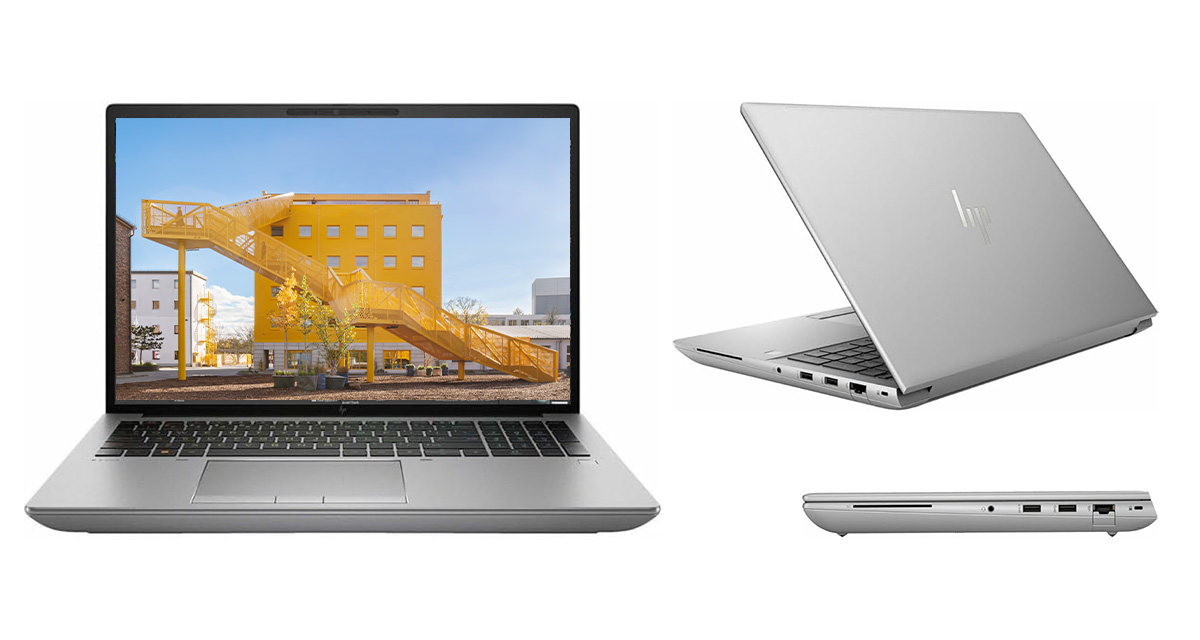 The HP ZBook Fury 16 G10 Mobile Workstation stands out as HP’s most powerful mobile workstation, designed for architects who require maximum performance. Its Intel Core i9 processor and NVIDIA RTX graphics deliver the computational and graphical power needed for demanding workflows, such as complex 3D modeling, rendering and large-scale BIM projects.
The HP ZBook Fury 16 G10 Mobile Workstation stands out as HP’s most powerful mobile workstation, designed for architects who require maximum performance. Its Intel Core i9 processor and NVIDIA RTX graphics deliver the computational and graphical power needed for demanding workflows, such as complex 3D modeling, rendering and large-scale BIM projects.
With a 16-inch WUXGA display, this workstation ensures sharp visuals and precise color accuracy, ideal for detailed design work. Starting with up to 64GB of DDR5 RAM and 1TB SSD storage, it provides the capacity and speed necessary for multitasking and managing extensive project files.
While its robust design prioritizes performance over portability, the ZBook Fury 16 G10 is equipped with enterprise-grade security features and comprehensive connectivity options, making it a reliable choice for serious professionals seeking desktop-class performance in a mobile form.
See more info and buy >
Best Budget Laptops for Architects
Best Laptop for Architects under $1000
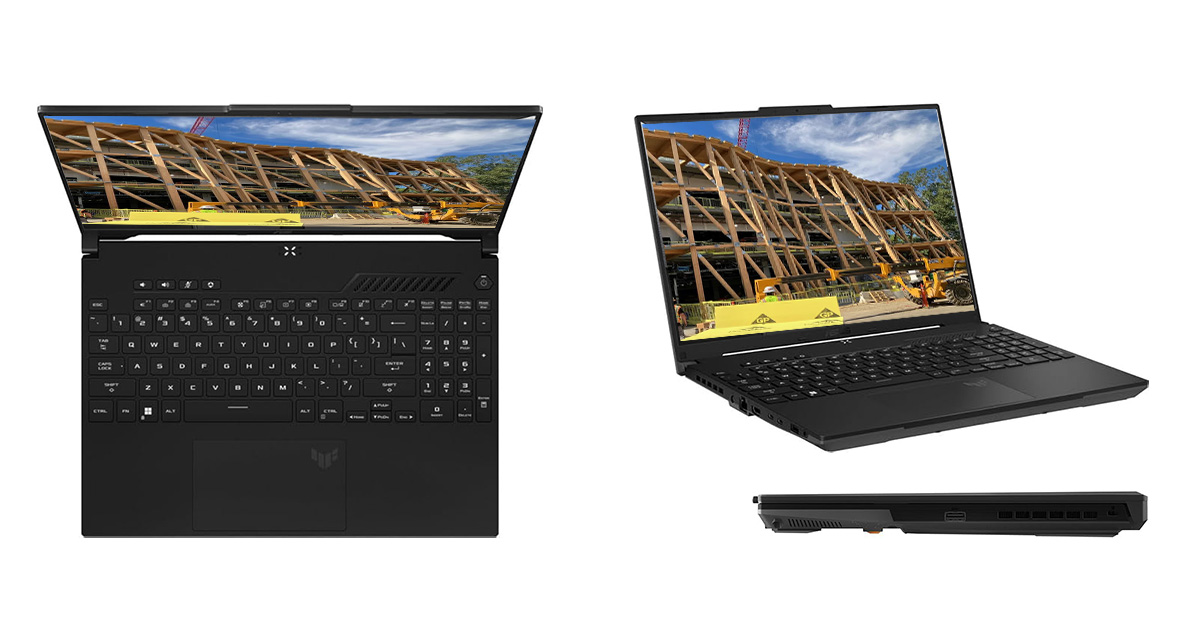 The ASUS TUF A16 delivers exceptional value for its price, offering an AMD Ryzen 7 7735HS processor and Radeon RX 7700S GPU, making it a reliable option for architects working with 3D modeling and rendering. The 16-inch WUXGA display (1920 x 1200, 165Hz, 100% sRGB) provides sharp, accurate visuals, ideal for design work.
The ASUS TUF A16 delivers exceptional value for its price, offering an AMD Ryzen 7 7735HS processor and Radeon RX 7700S GPU, making it a reliable option for architects working with 3D modeling and rendering. The 16-inch WUXGA display (1920 x 1200, 165Hz, 100% sRGB) provides sharp, accurate visuals, ideal for design work.
What sets the TUF A16 apart is its generous base configuration of 32GB DDR5 RAM and 1TB SSD, offering multitasking power and ample storage. Higher configurations—up to 64GB RAM and 2TB SSD—make this laptop a versatile choice for growing project demands. Its downside lies in its build quality, which feels less refined than premium models. However, for under $1000, the TUF A16 is a strong contender for both students and professionals on a budget.
See more info and buy >
Best Laptop for Architects under $900
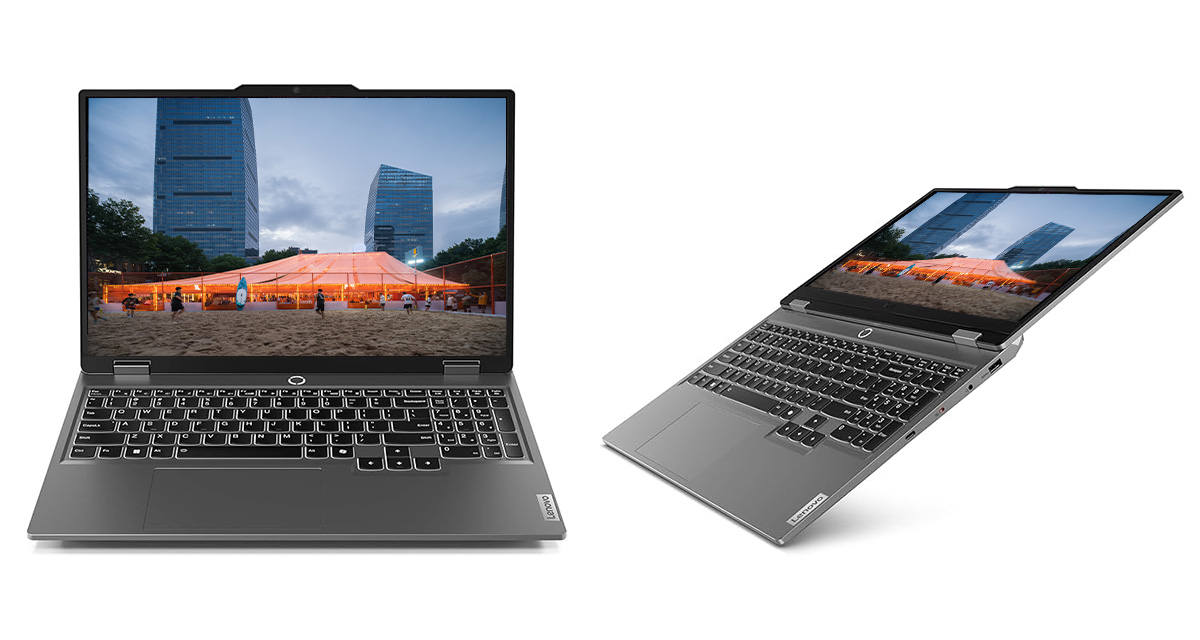 The Lenovo LOQ 15.6″ is a practical pick for architecture students or professionals seeking dependable performance without overspending. Its AMD Ryzen 7 7435HS processor and NVIDIA GeForce RTX 4050 GPU handle essential tasks like CAD, 3D modeling and rendering.
The Lenovo LOQ 15.6″ is a practical pick for architecture students or professionals seeking dependable performance without overspending. Its AMD Ryzen 7 7435HS processor and NVIDIA GeForce RTX 4050 GPU handle essential tasks like CAD, 3D modeling and rendering.
A standout feature is the 15.6-inch FHD display (1920 x 1080) with a 144Hz refresh rate, which delivers clear visuals and smooth performance for reviewing designs or creating presentations. With 16GB of RAM and 512GB SSD, it offers reliable multitasking, though it doesn’t match the ASUS TUF A16’s flexibility in higher configurations. While not as feature-rich as pricier options, the LOQ strikes a balance between affordability and capability, making it an excellent choice for students tackling medium-scale projects.
See more info and buy >
Best Laptop for Architects under $800
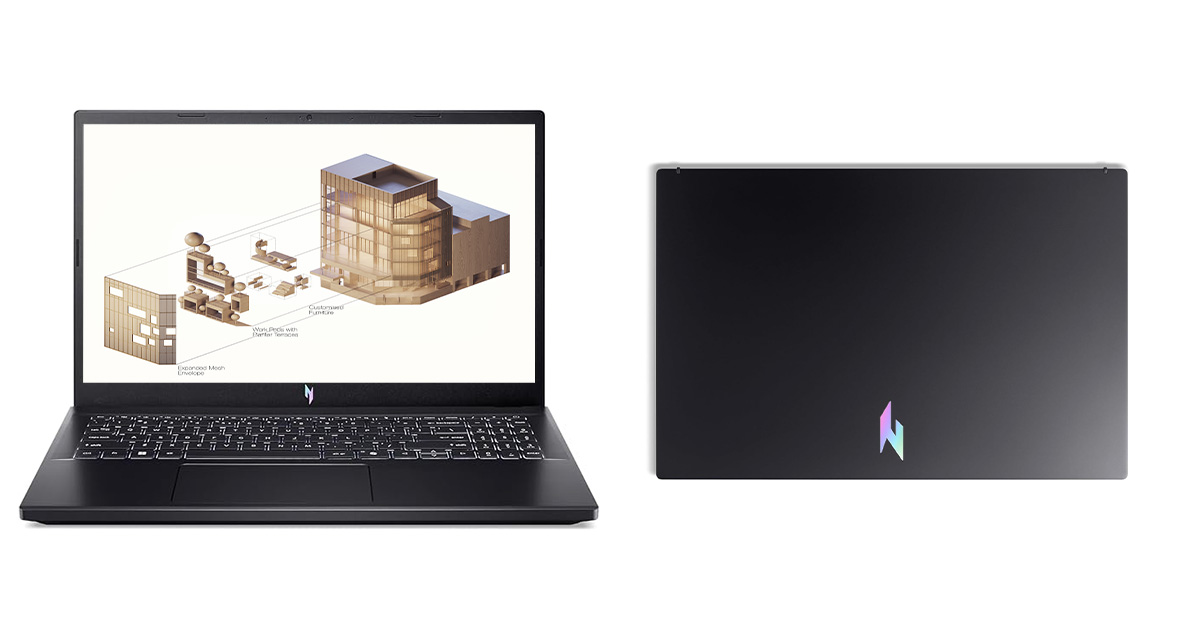 The Acer Nitro V stands out as the most budget-friendly choice, offering respectable performance for lighter architectural tasks. With an AMD Ryzen 5 7535HS processor and NVIDIA GeForce RTX 4050 GPU, it’s capable of running tools like AutoCAD and SketchUp.
The Acer Nitro V stands out as the most budget-friendly choice, offering respectable performance for lighter architectural tasks. With an AMD Ryzen 5 7535HS processor and NVIDIA GeForce RTX 4050 GPU, it’s capable of running tools like AutoCAD and SketchUp.
Its 15.6-inch Full HD display with a 144Hz refresh rate provides smooth visuals, though the base configuration of 8GB DDR5 RAM may require upgrades for multitasking or larger project files. The Nitro V’s dual-fan cooling system helps maintain stable performance during extended sessions and its Wi-Fi 6 support ensures reliable connectivity.
While the Nitro V lacks the RAM and storage flexibility of the ASUS TUF A16, its affordability makes it a great starting point for students or beginners with lighter workloads. Upgrades to 32GB RAM and larger storage options allow for incremental improvements as project demands increase.
See more info and buy >
Best Laptop for Architects under $700
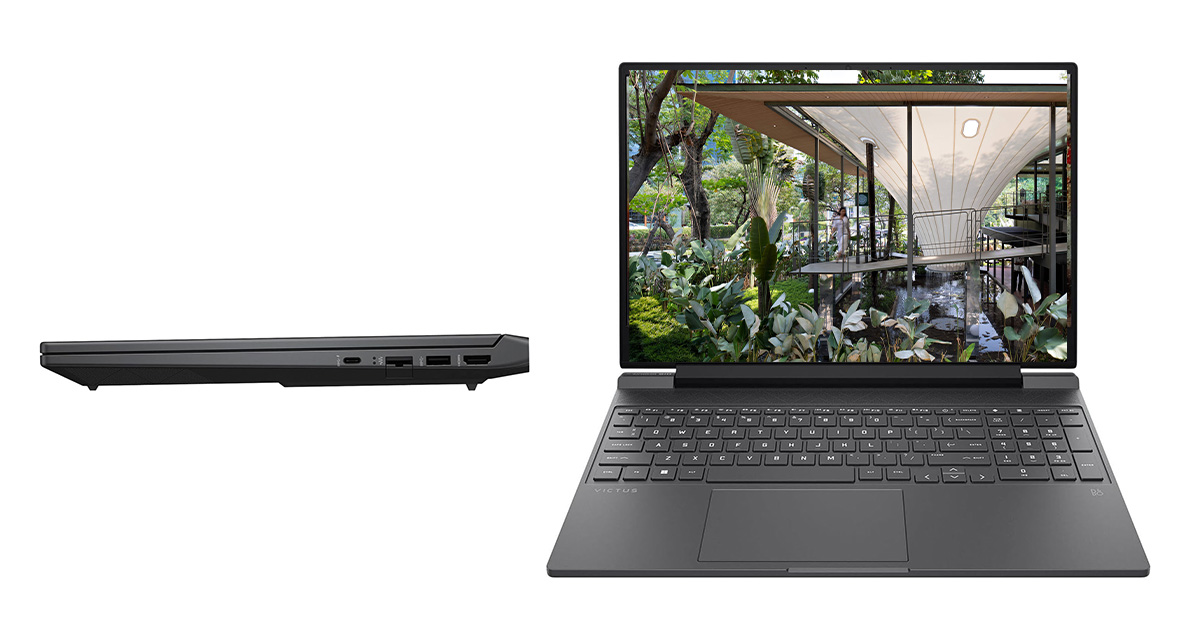 The HP Victus 15.6″ (2024) is a solid budget option, powered by a 13th Gen Intel Core i5-13420H processor and NVIDIA GeForce RTX 4050 GPU (6GB GDDR6). It handles essential architectural tasks, such as drafting in AutoCAD or working in SketchUp, with ease. Its 15.6-inch FHD display (144Hz) ensures smooth visuals, making it a good choice for design reviews or light rendering.
The HP Victus 15.6″ (2024) is a solid budget option, powered by a 13th Gen Intel Core i5-13420H processor and NVIDIA GeForce RTX 4050 GPU (6GB GDDR6). It handles essential architectural tasks, such as drafting in AutoCAD or working in SketchUp, with ease. Its 15.6-inch FHD display (144Hz) ensures smooth visuals, making it a good choice for design reviews or light rendering.
Where the Victus shines is its price-to-performance ratio. At under $700, it offers 16GB DDR4 RAM and a 512GB SSD, comparable to other budget options like the Lenovo LOQ, but at a lower price. However, its more limited RAM and storage configurations, along with its basic build quality, may be less appealing for those with growing project demands.
Compared to the ASUS TUF A16 or Lenovo LOQ 15, the HP Victus is a straightforward and affordable choice for architecture students or professionals with lighter workloads. While it may lack the expandability of the TUF A16 or the refined multitasking capability of the LOQ, its low price makes it the most accessible option for those on a tight budget.
See more info and buy >
Top Laptops for Architects and Designers in 2024
Premium Laptops for Architects:
Best Mobile Workstation for Architects: Lenovo ThinkPad P16 Gen 2
Best Gaming Laptops for Architects: MSI 2024 Newest Katana 17 Gaming Laptop
Best Thin / Portable Laptop for Architects: Lenovo Yoga 9i 2-in-1 Intel (14″)
Best Multi-Screen Laptop for Architects: ASUS ROG Zephyrus Duo 16
Best 2-in-1 Laptop for Architects: Microsoft Surface Laptop Studio 2
Best Laptop for Architects by Brand
Best ASUS Laptop for Architects: ASUS 2023 ProArt StudioBook 16 OLED Laptop
Best Dell Laptop for Architects: Dell XPS 17 (2023)
Best Lenovo Laptop for Architects: Lenovo Legion Pro 5i Gen 8
Best HP Laptop for Architects: HP ZBook Studio G10 16″ Mobile Workstation
Best Apple Laptop (MacBook) for Architects: MacBook Pro 16 M3
Best Budget Laptops for Architects
Best Laptop for Architects Under $1100: Lenovo LOQ Gaming Laptop, 15.6″
Best Laptop for Architects under $900: Dell Inspiron 14
Best Laptop for Architects under $800: HP Victus 15
Best Laptop for Architects under $700: Acer Nitro 5
Best Laptop for Architects under $600: Acer Swift 3
Top Laptops for Architects and Designers in 2023
Premium Laptops for Architects:
Best Mobile Workstation for Architects: HP ZBook Firefly G9 Mobile Workstation
Best Gaming Laptops for Architects: Dell Alienware m15 R7 Gaming Laptop
Best Touchscreen Laptop for Architects: Lenovo IdeaPad Slim 9i 14’’ Laptop
Best Multi-Screen Laptop for Architects: ASUS ROG Zephyrus Duo 16 Gaming Laptop
Best 2-in-1 Laptop for Architects: Microsoft Surface Pro 9
Best Laptops for Architects By Brand
Best HP Laptop for Architects: HP ZBook Fury G8 Mobile Workstation
Best Dell Laptop for Architects: Dell Inspiron 15.6’’ FHD Touchscreen Laptop
Best Lenovo Laptop for Architects: Lenovo ThinkPad P1 Gen 5 Laptop
Best MSI Laptop for Architects: MSI 2022 GE76 Raider 17.3″ 144 Hz FHD Gaming Laptop
Best Apple Laptop for Architects: Apple 2022 MacBook Pro Laptop with M2 chip
Budget Laptops for Architects and Designers:
Best Laptop for Architects Under $900: Lenovo IdeaPad Gaming 3 Laptop
Best Laptop for Architects Under $800: HP 2023 17.3″ FHD Laptop
Best Laptop for Architects Under $700: Acer 2022 Aspire 5 Slim Laptop 15.6″
Top Laptops for Architects and Designers in 2022
Premium Laptops for Architects
Best Mobile Workstation for Architects –HP ZBook Studio G8 15.6″ Mobile Workstation
Best Gaming Laptop for Architects – Razer Blade Pro 17
Best Touchscreen Laptop for Architects – Microsoft Surface Pro 8
Best Multi-Screen Laptop for Architects – ASUS ZenBook Pro Duo 15 Laptop
Best 2-in-1 Laptop for Architects – Samsung Galaxy Book Flex2 Alpha 2-in-1 Laptop
Best Laptops for Architects By Brand
Best HP Laptop for Architects – HP OMEN 15 Laptop
Best Dell Laptop for Architects – Dell Alienware 51M R2 Gaming Laptop
Best Lenovo Laptop for Architects – Lenovo ThinkPad X1 Extreme Gen 3 Business Laptop
Best MSI Laptop for Architects – MSI GE76 17.3″ 144Hz IPS FHD Premium Gaming Laptop
Best Apple Laptop for Architects – Apple MacBook Pro (16-inch)
Budget Laptops for Architects
Best Laptop for Architects Under $900 – HP Pavilion 17 Laptop
Best Laptop for Architects Under $800 – Lenovo IdeaPad 3
Best Laptop for Architects Under $700 – Dell Inspiron 3000 Laptop
Best Laptop for Architects Under $600 – ASUS VivoBook 14″ FHD Laptop
Best Laptop for Architects Under $500 – Apple Macbook Pro (13-inch)
Other Considerations
Mac vs. Windows: In terms of hardware and operating system, it all comes down to your personal preference. High-end Apple and PC laptops are well geared to handle the challenges offered by the job. Windows 10 is arguably more user friendly as it supports a wide array of software but is exposed to more viruses than Mac. The Macbook Pro in particular is well perceived by professionals as being great for graphic applications but is considered by many to be overpriced. That said, Apple makes our list this year, thanks to improvements to Parallels, which allows Windows software to be run on Mac. Andy Roehl, architect at Moonlight Design Studio, LLC, asserts that “running parallels on a current Apple laptop is no problem; [it works] much better now than 10+ years ago.”
Gaming laptops: A growing trend within the architecture and design professions is the adoption of gaming laptops, thanks to their powerful specifications. Built to handle incredibly detailed graphics and demanding streaming requirements, the processing power of gaming laptops make them ideal for BIM and architectural visualization tasks, and often cost less than top-of-the-range mobile workstations. Marsha McDonald, Principal Designer and CEO of Seacrest Designs and Decor, sums it up perfectly: “If my kids are fighting me for my system (they are gamers), then I know I am golden!”
Ports and peripherals: “For peripherals,” says Christiana Copper, Project Manager at TyE Bar, LLC, “my favorite mouse is the Logitech G602 – I program canned email responses on the programmable buttons, but you could probably do CAD macros as well. I also bought monitor arms this year, and I am really enjoying them.” Consider how many USB ports, ethernet ports and other specialist ports you might need; this will vary depending on your preference for wired or wireless peripheral such as computer mice, touch pads and external hard drives.
Useful Accessories:
Vertical / Ergonomic Mouse: Allow your hand to rest at a more natural angle on the mouse, easing your muscles.
External monitor: By displaying the screen closer to your eye level, this addition to your home office makes it easier to catch details while reducing neck and back pain.
Laptop Stand: A helpful way to keep your device from overheating, these stands also allow you to adjust your laptop screen to a comfortable height. To maximize the benefits, this stand is best when accompanied by an external keyboard that keep the keys at a convenient level for your wrists.
Portable External SSD: An external hard drive is a high power way to manage archives and keep your laptop storage neat and spacious.
Got your own view on which is the best laptop for architects and architecture students? Let us know at editorial@architizer.com.
Architizer Journal is reader-supported. When you buy through Amazon links on our site, we may earn an affiliate commission. Learn more
The post 16 Top Laptops for Architects and Designers (NEW for 2025) appeared first on Journal.
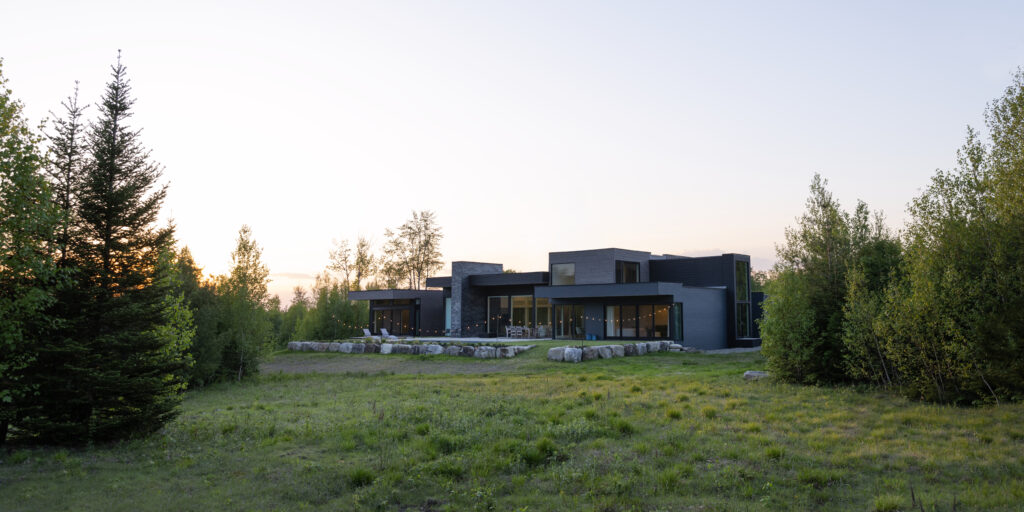
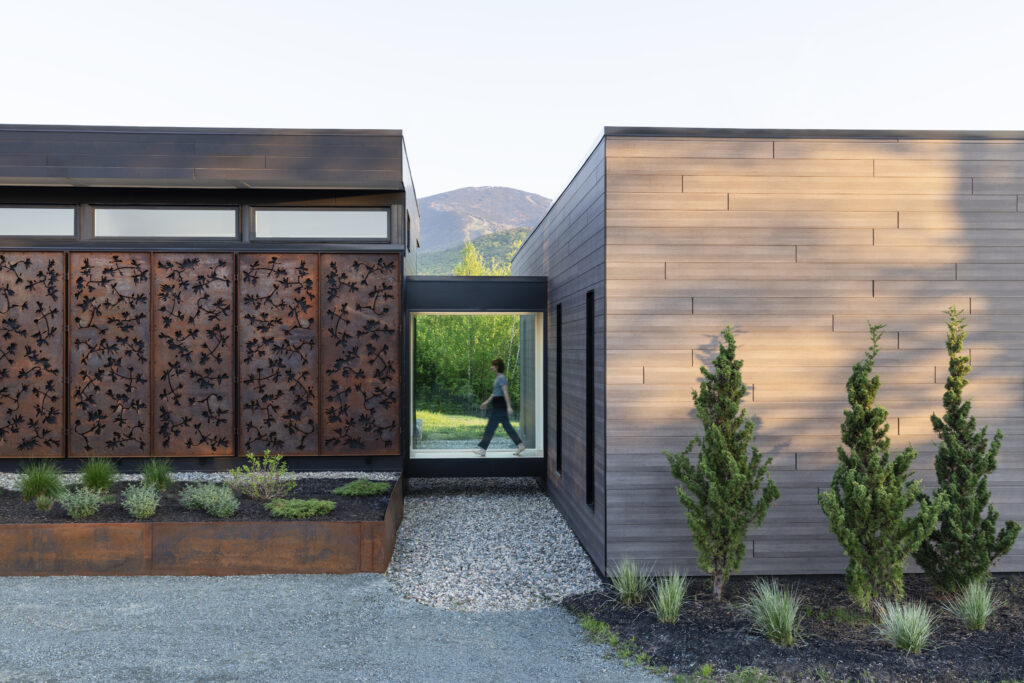
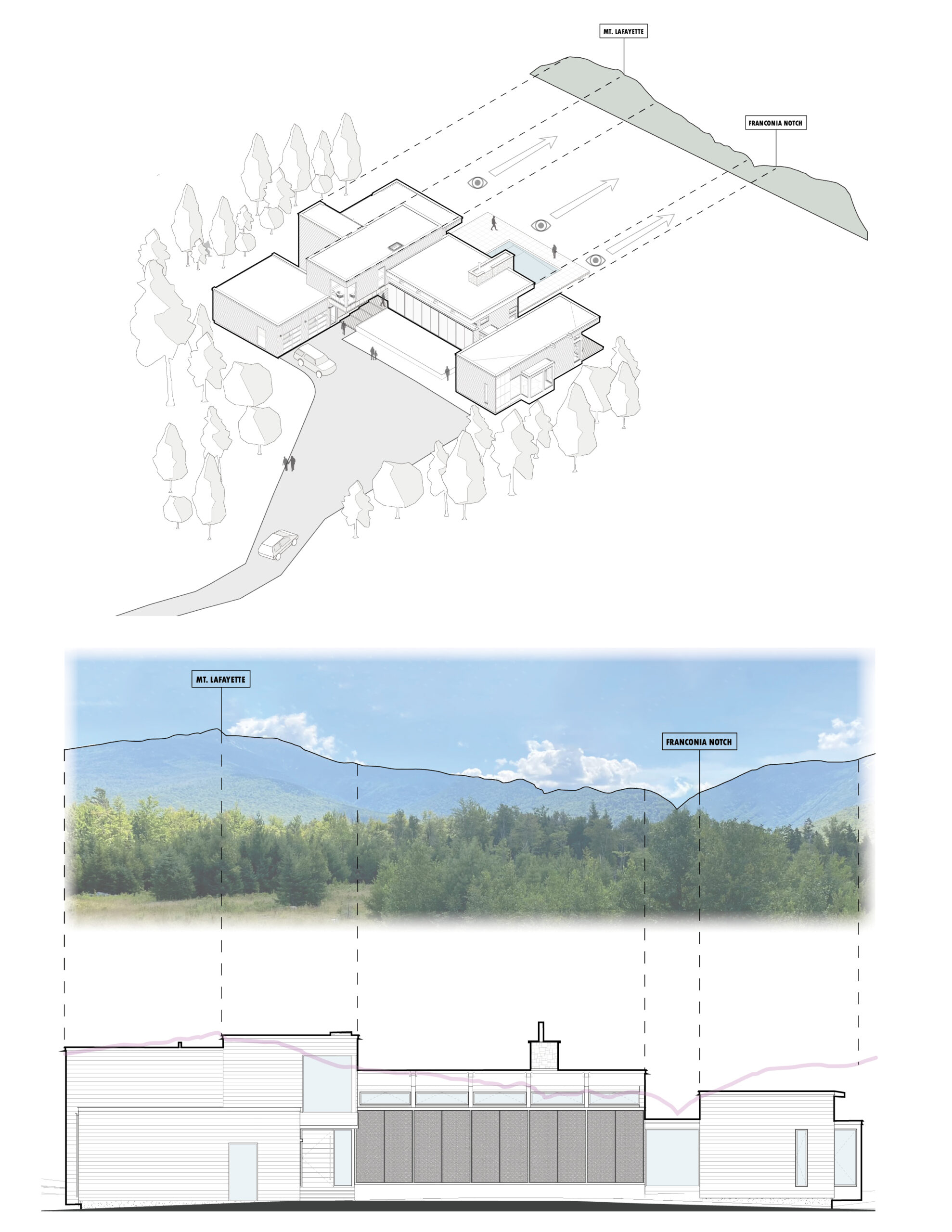
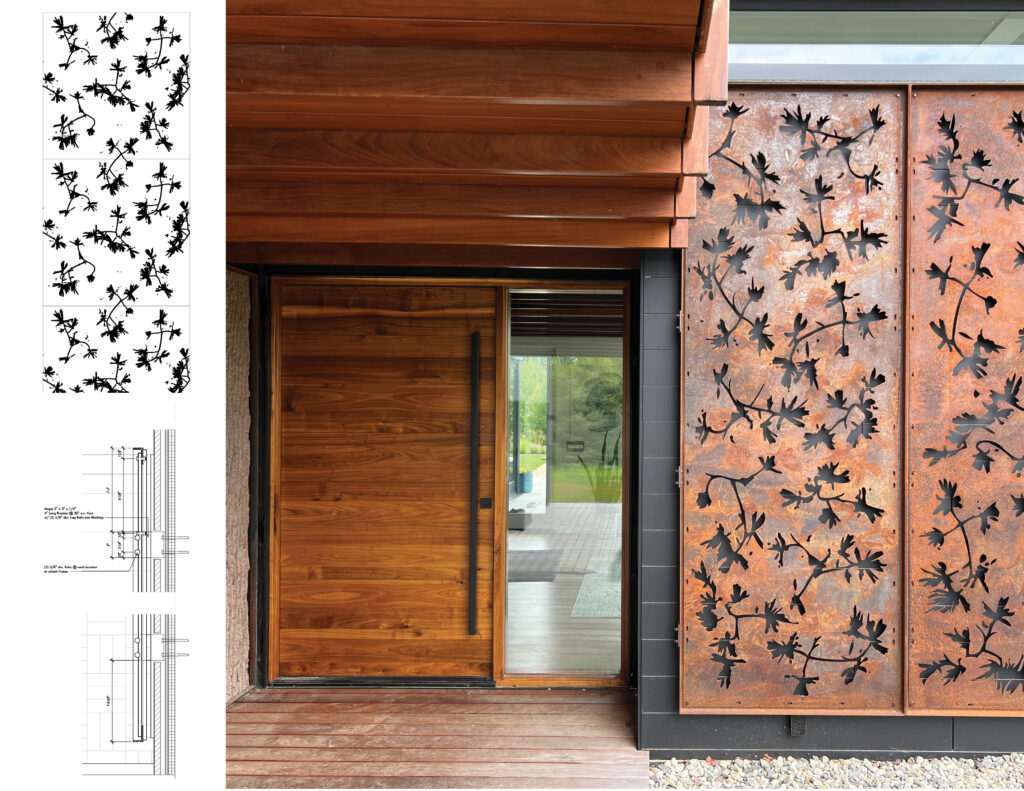
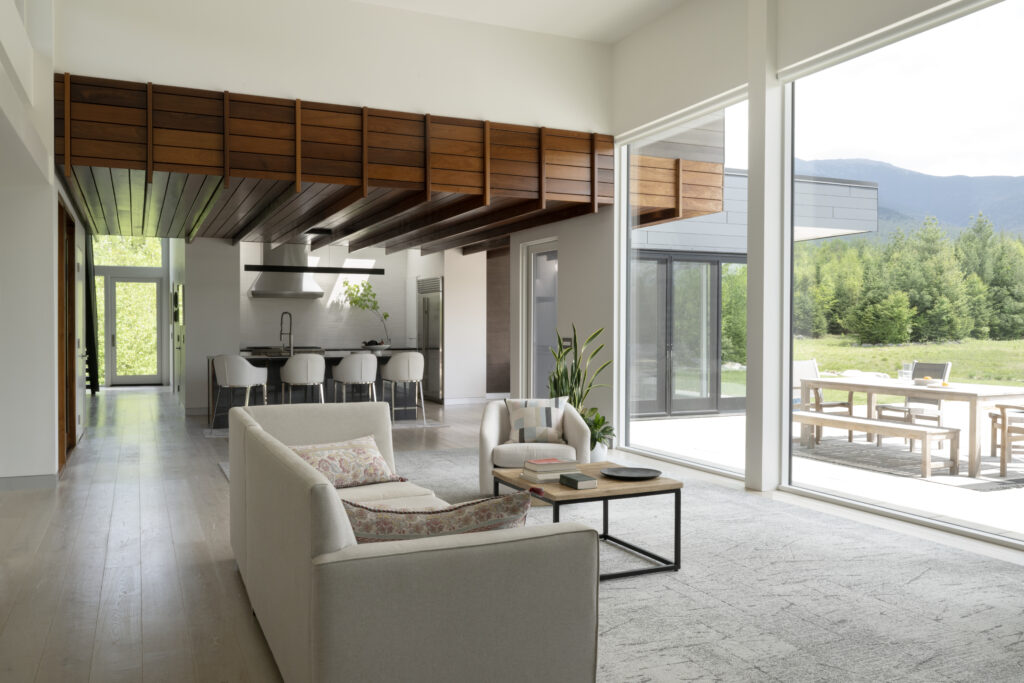

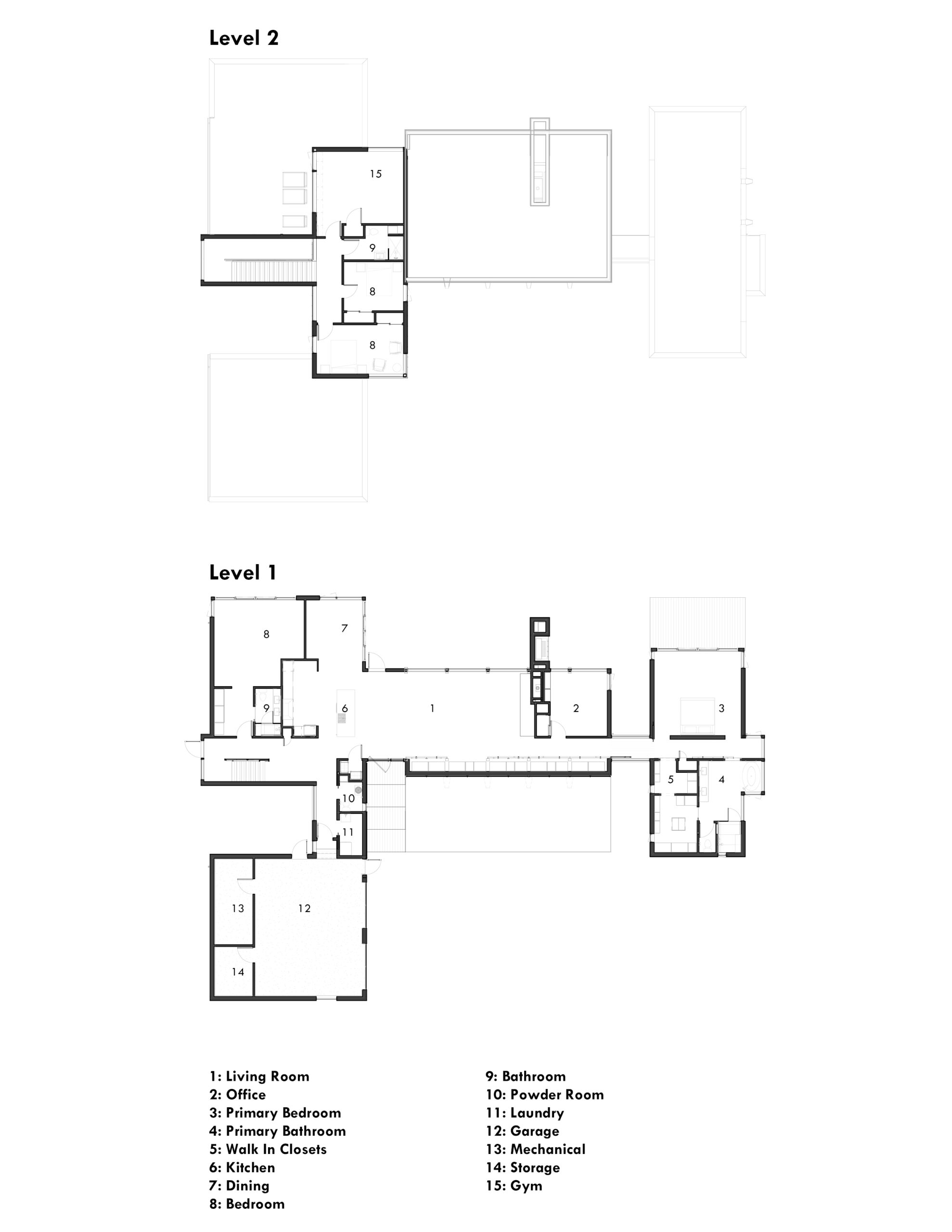
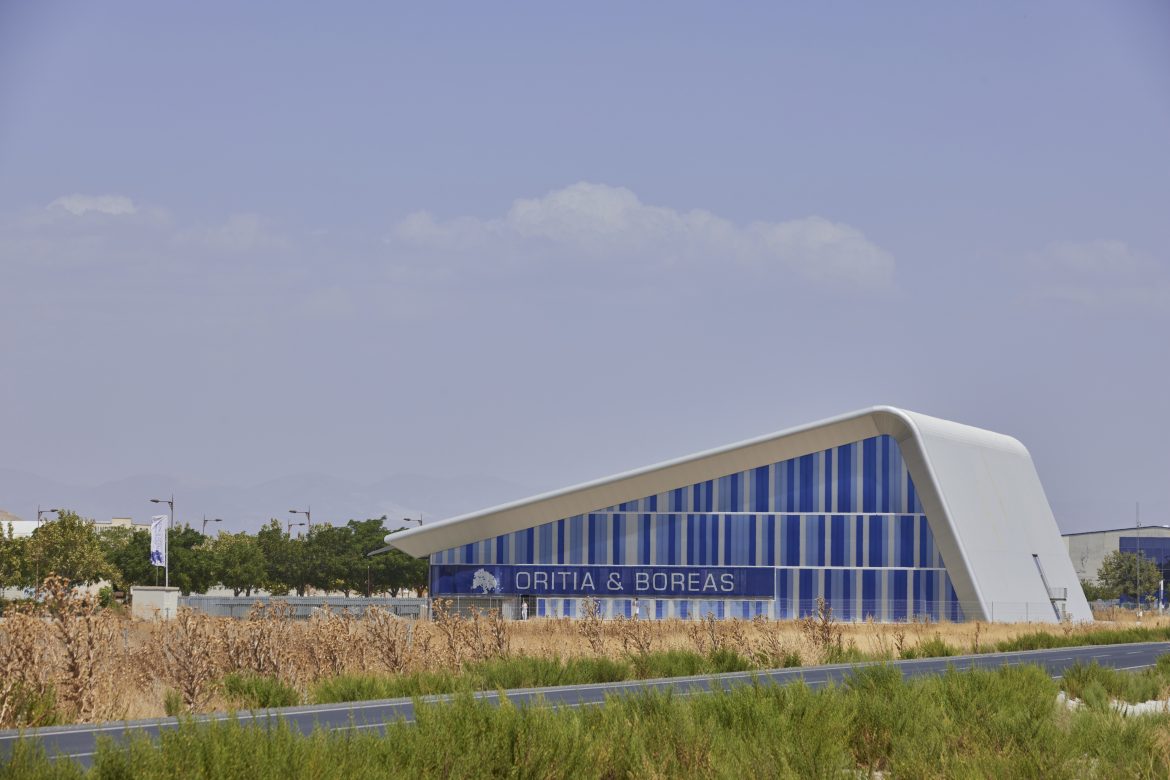
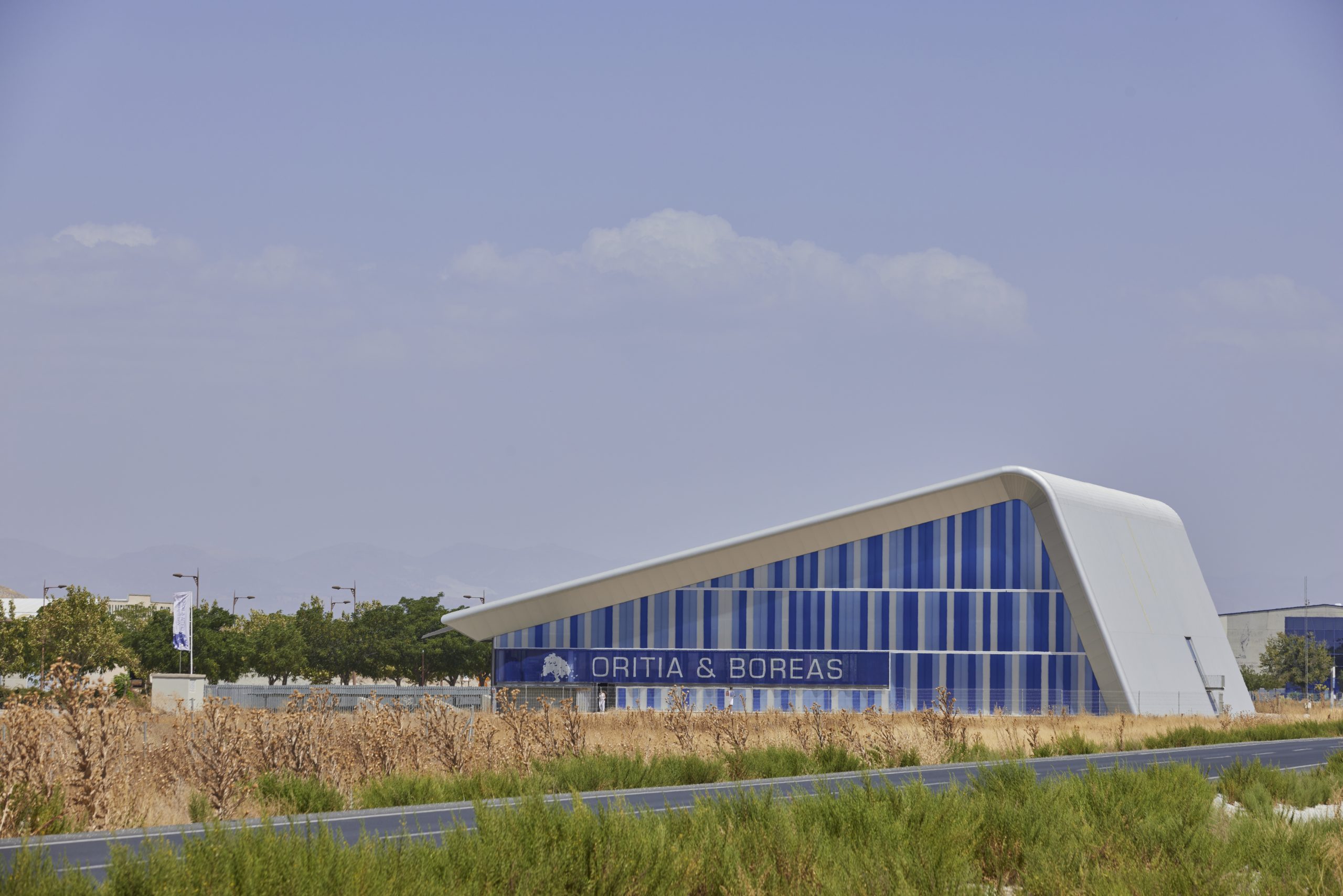




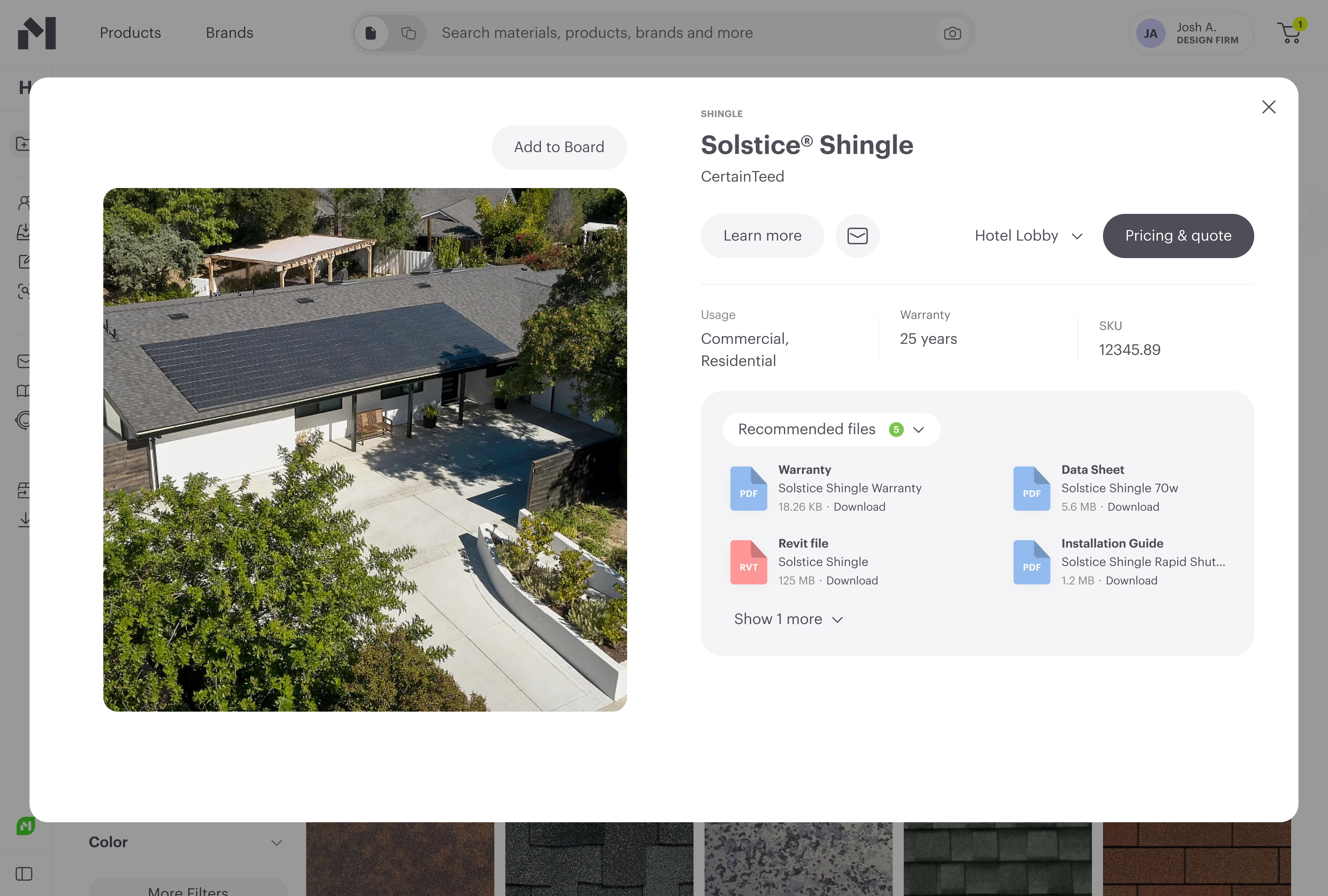


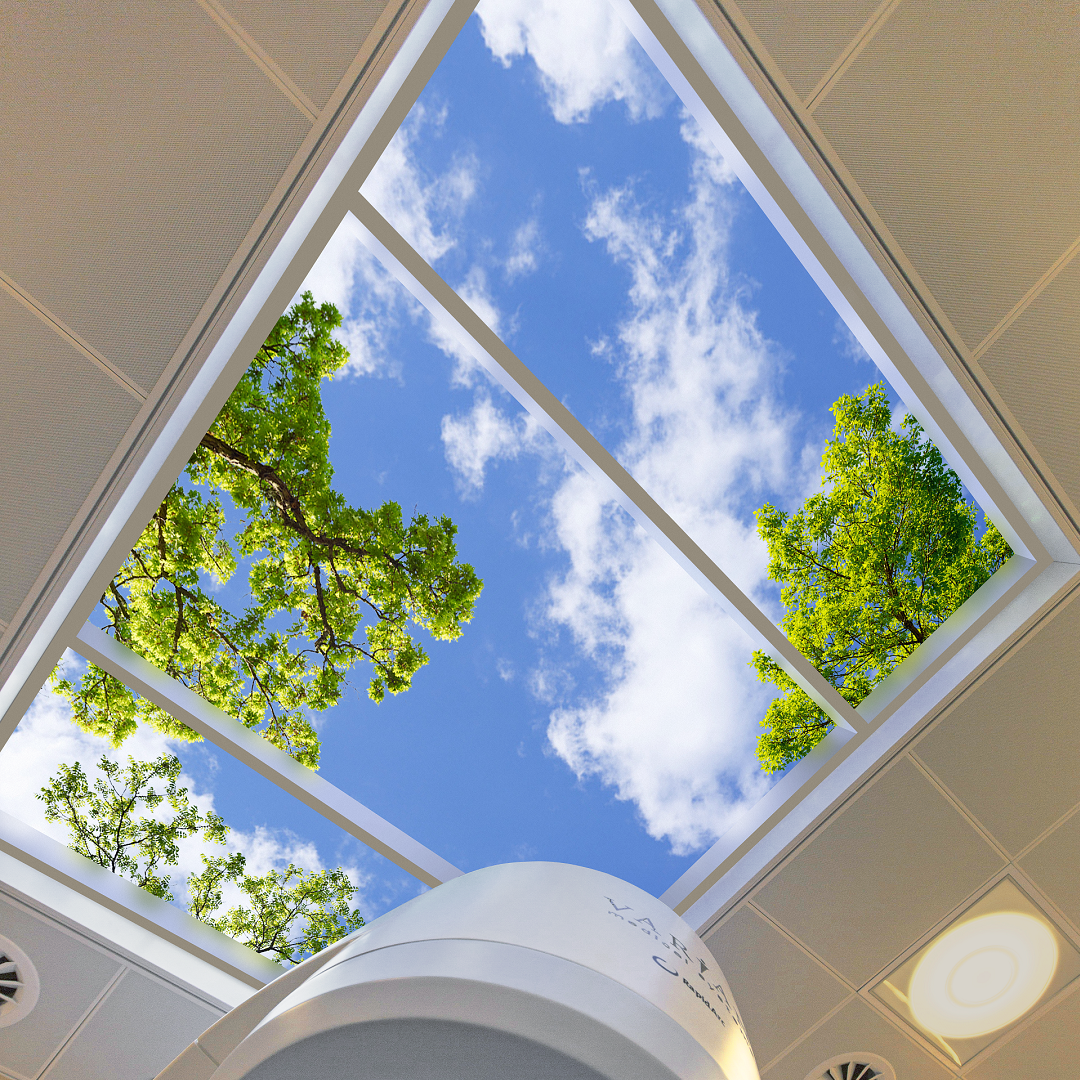
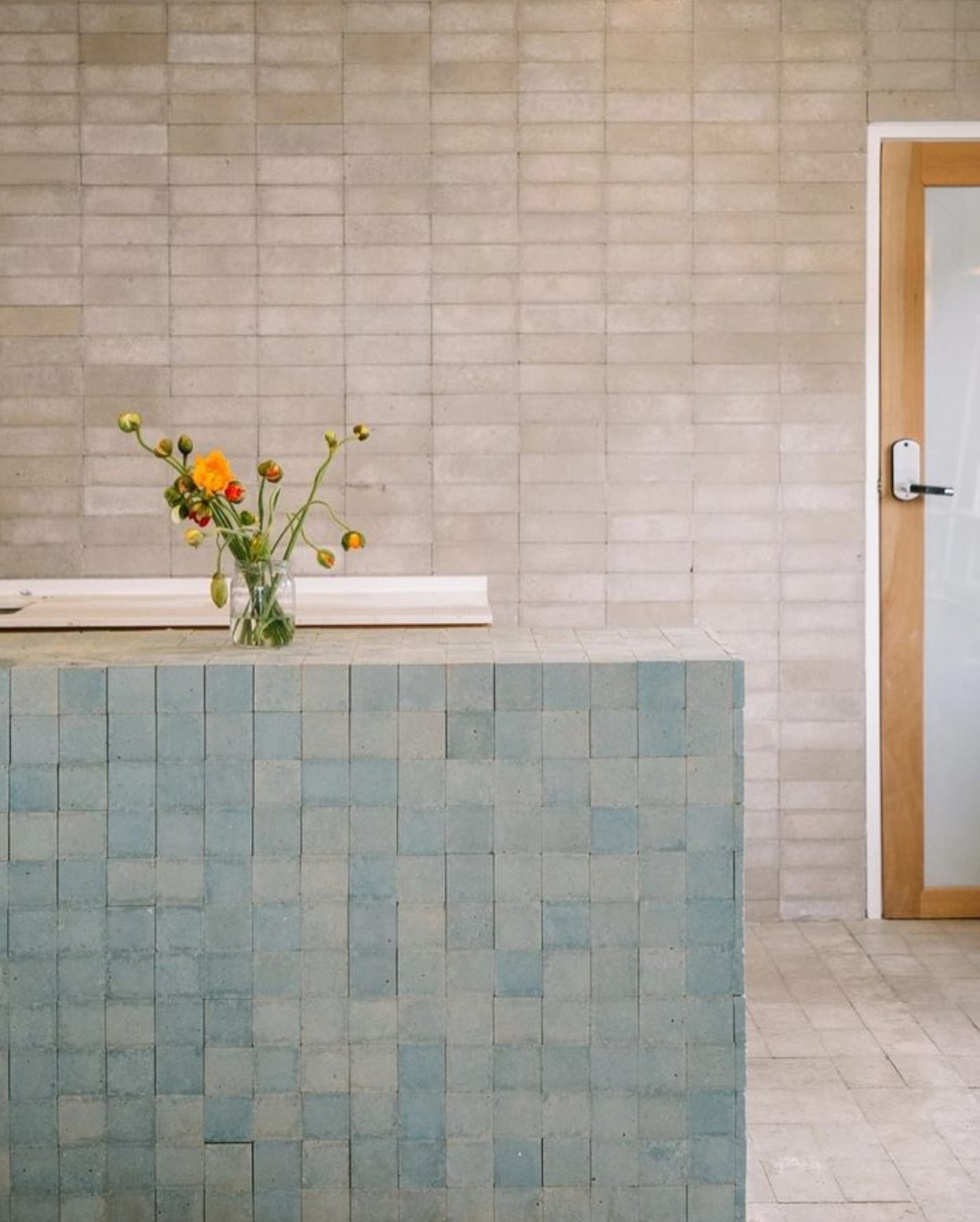 In a restful environment, materials shape perception, which is why Loqa’s Unfired Circular Tile, with its artisanal texture and a guilt-free footprint, is the perfect choice. Formed from 85% industrial waste — ceramics, glass and fly ash — and no high-temperature firing, each tile cuts carbon emissions while boasting 106% more strength than conventional choices. The result is a textured finish that evokes calm and supports a truly sustainable retreat.
In a restful environment, materials shape perception, which is why Loqa’s Unfired Circular Tile, with its artisanal texture and a guilt-free footprint, is the perfect choice. Formed from 85% industrial waste — ceramics, glass and fly ash — and no high-temperature firing, each tile cuts carbon emissions while boasting 106% more strength than conventional choices. The result is a textured finish that evokes calm and supports a truly sustainable retreat.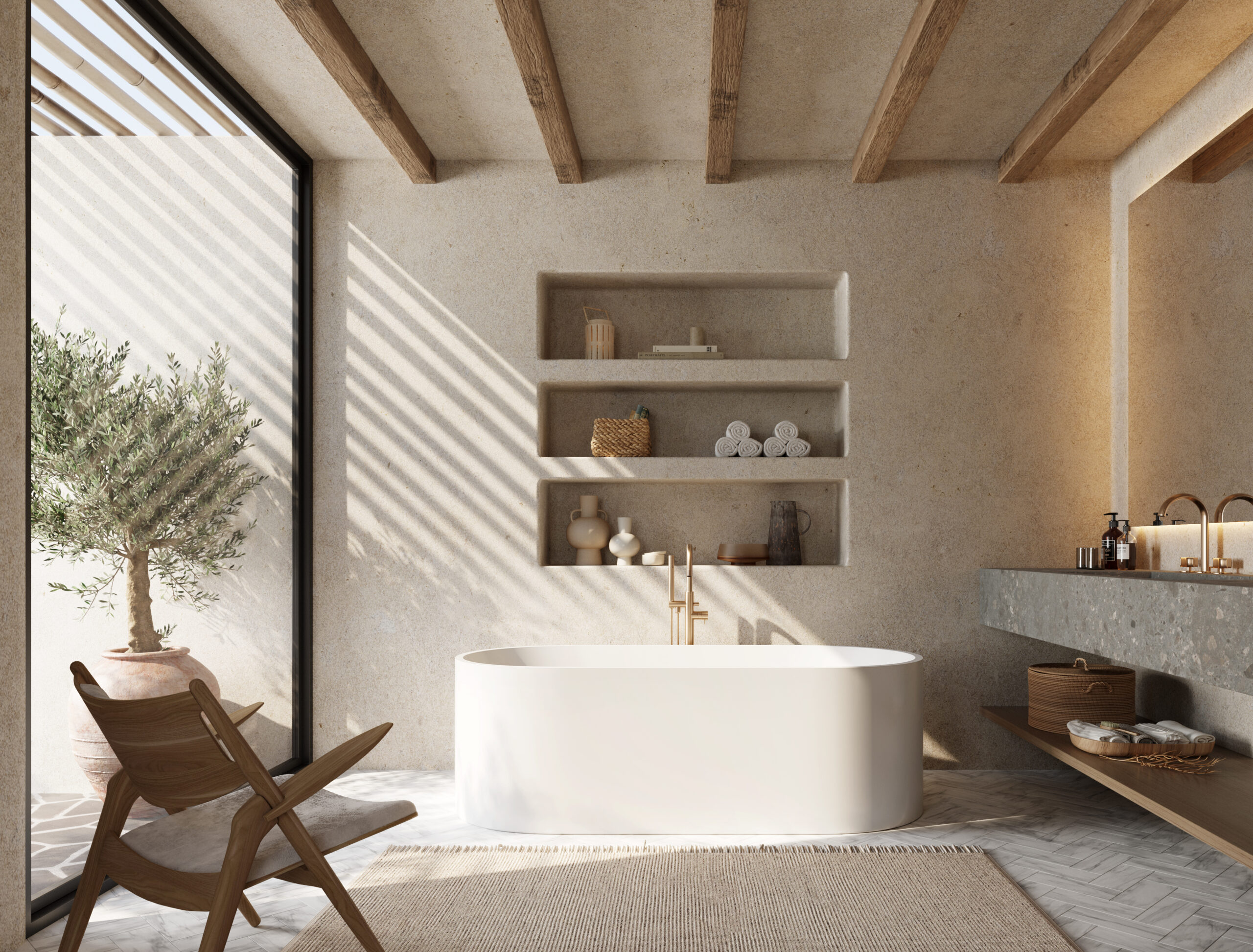 Nodding to Morris Lapidus’s mid-century flair, Hydro Systems’ Lido Freestanding Bathtub goes beyond the average oval tub to become a sculptural focal point in any spa-inspired interior. The gently dipping 1.5-inch deck allows effortless entry, while a 31-degree back slope and HydroLuxeSS™ material deliver the kind of indulgent soak that can confidently be specified for daily restoration. Optional hydro therapies — Cold Plunge, Hydro Indulge or Thermal Air — push the experience further.
Nodding to Morris Lapidus’s mid-century flair, Hydro Systems’ Lido Freestanding Bathtub goes beyond the average oval tub to become a sculptural focal point in any spa-inspired interior. The gently dipping 1.5-inch deck allows effortless entry, while a 31-degree back slope and HydroLuxeSS™ material deliver the kind of indulgent soak that can confidently be specified for daily restoration. Optional hydro therapies — Cold Plunge, Hydro Indulge or Thermal Air — push the experience further.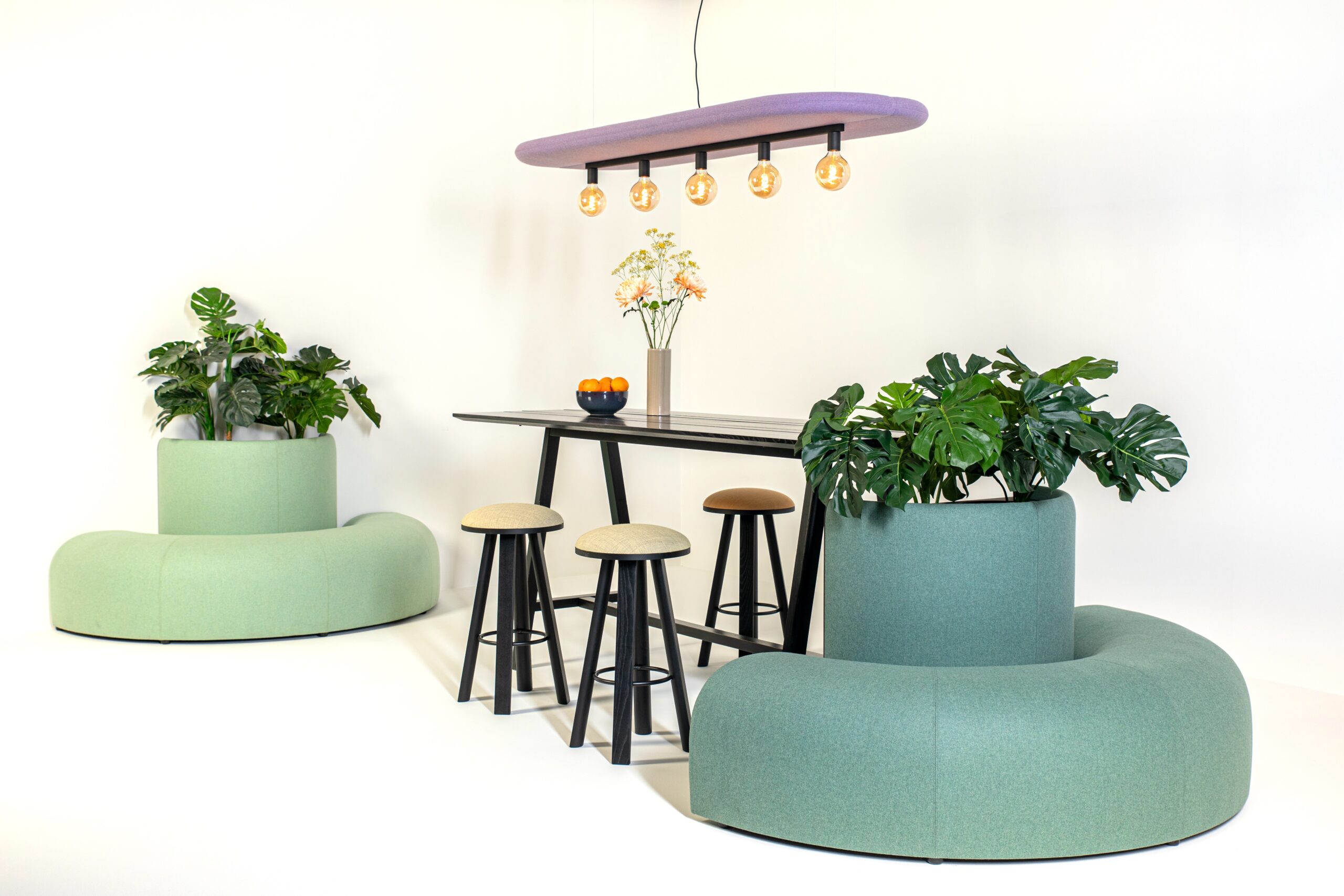 BuzziCee is an acoustic seating concept that hushes the open-plan clamor with upcycled materials and soft geometry. Paired with BuzziPlanter — a lush, sustainable vessel for greenery — this duo turns shared spaces into zones for calm, connectivity and collaboration. BuzziSpace proves that well-being can be built right into the furniture with nature and noise control.
BuzziCee is an acoustic seating concept that hushes the open-plan clamor with upcycled materials and soft geometry. Paired with BuzziPlanter — a lush, sustainable vessel for greenery — this duo turns shared spaces into zones for calm, connectivity and collaboration. BuzziSpace proves that well-being can be built right into the furniture with nature and noise control.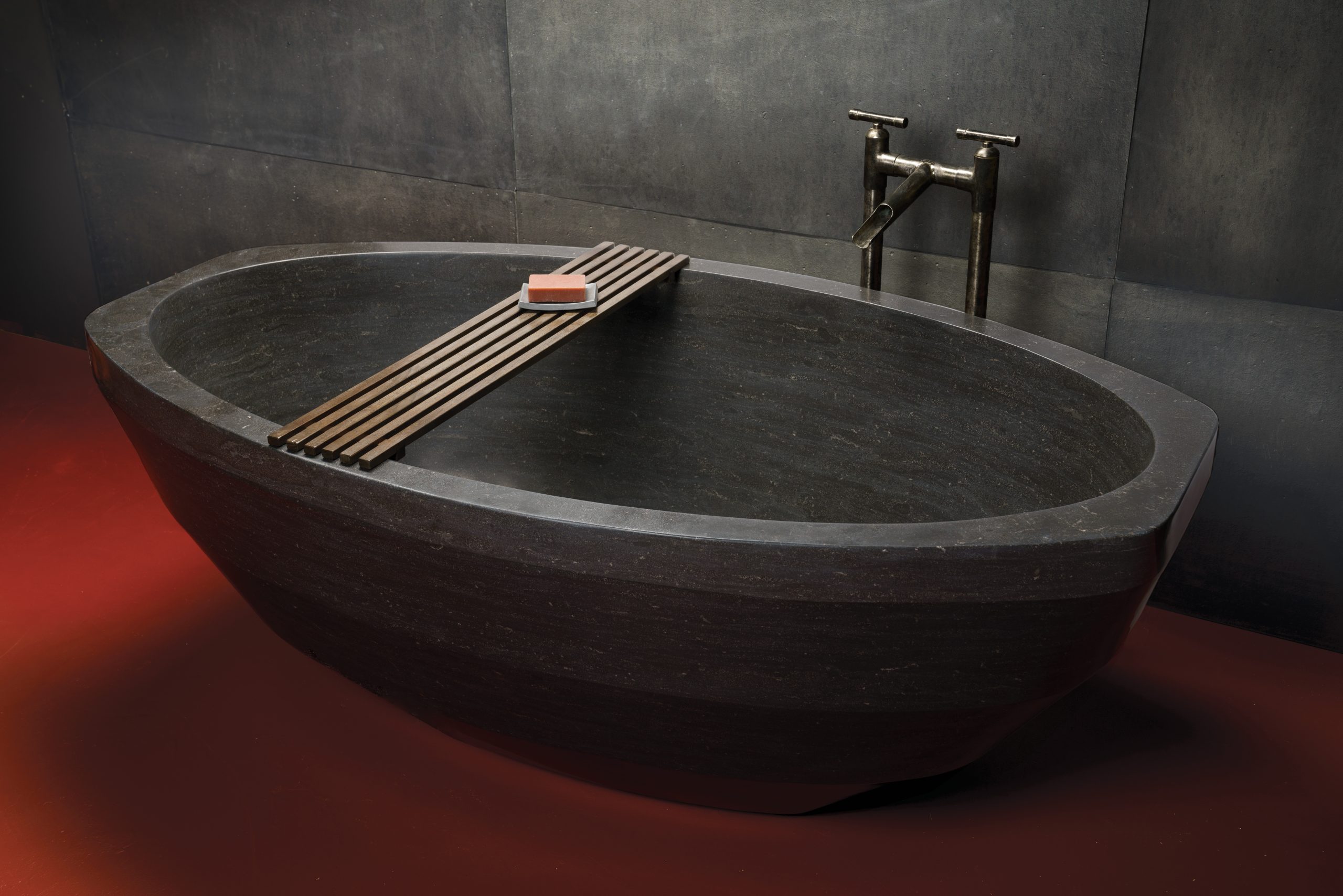 Stone Forest’s Facet Bathtub is made of natural stone to offer a soul-healing centerpiece. Hand-carved over three weeks from single blocks of Antique Gray Limestone or Noce Basalt each ovoid tub absorbs the ambient room temperature to turn a simple soak into an immersive, spa-like experience. Subtle planes and squared ends also provide both architectural flair and functional rest.
Stone Forest’s Facet Bathtub is made of natural stone to offer a soul-healing centerpiece. Hand-carved over three weeks from single blocks of Antique Gray Limestone or Noce Basalt each ovoid tub absorbs the ambient room temperature to turn a simple soak into an immersive, spa-like experience. Subtle planes and squared ends also provide both architectural flair and functional rest.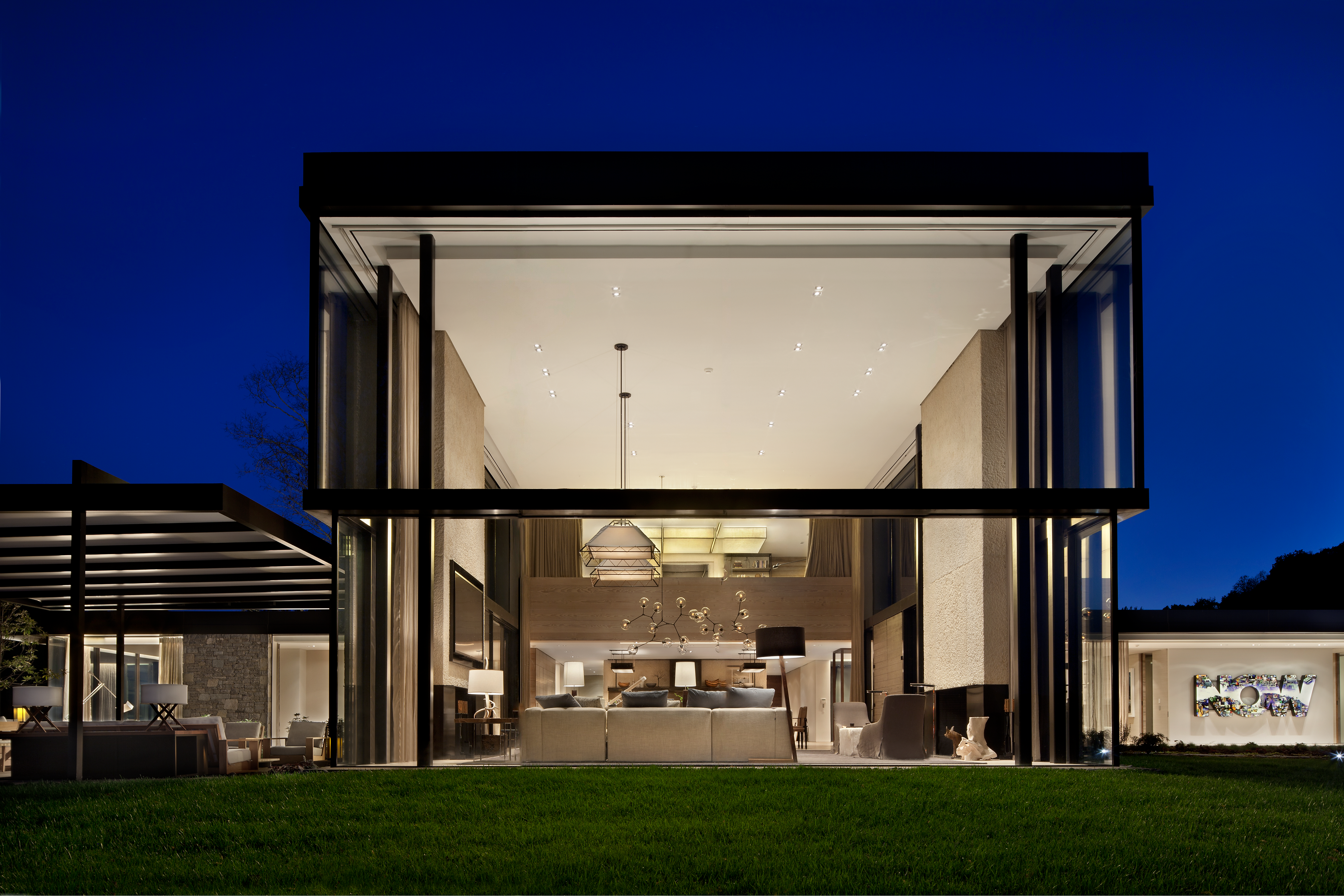 Architects looking to dissolve the line between indoors and out will find VetraSpan-L’s uninterrupted 50-foot expanse irresistible. Free of vertical joints or bulky frames, Sentech’s structural glass system amplifies openness to provide uninterrupted vistas. The result is an uncluttered façade that concentrates the focus on the view, not the hardware.
Architects looking to dissolve the line between indoors and out will find VetraSpan-L’s uninterrupted 50-foot expanse irresistible. Free of vertical joints or bulky frames, Sentech’s structural glass system amplifies openness to provide uninterrupted vistas. The result is an uncluttered façade that concentrates the focus on the view, not the hardware.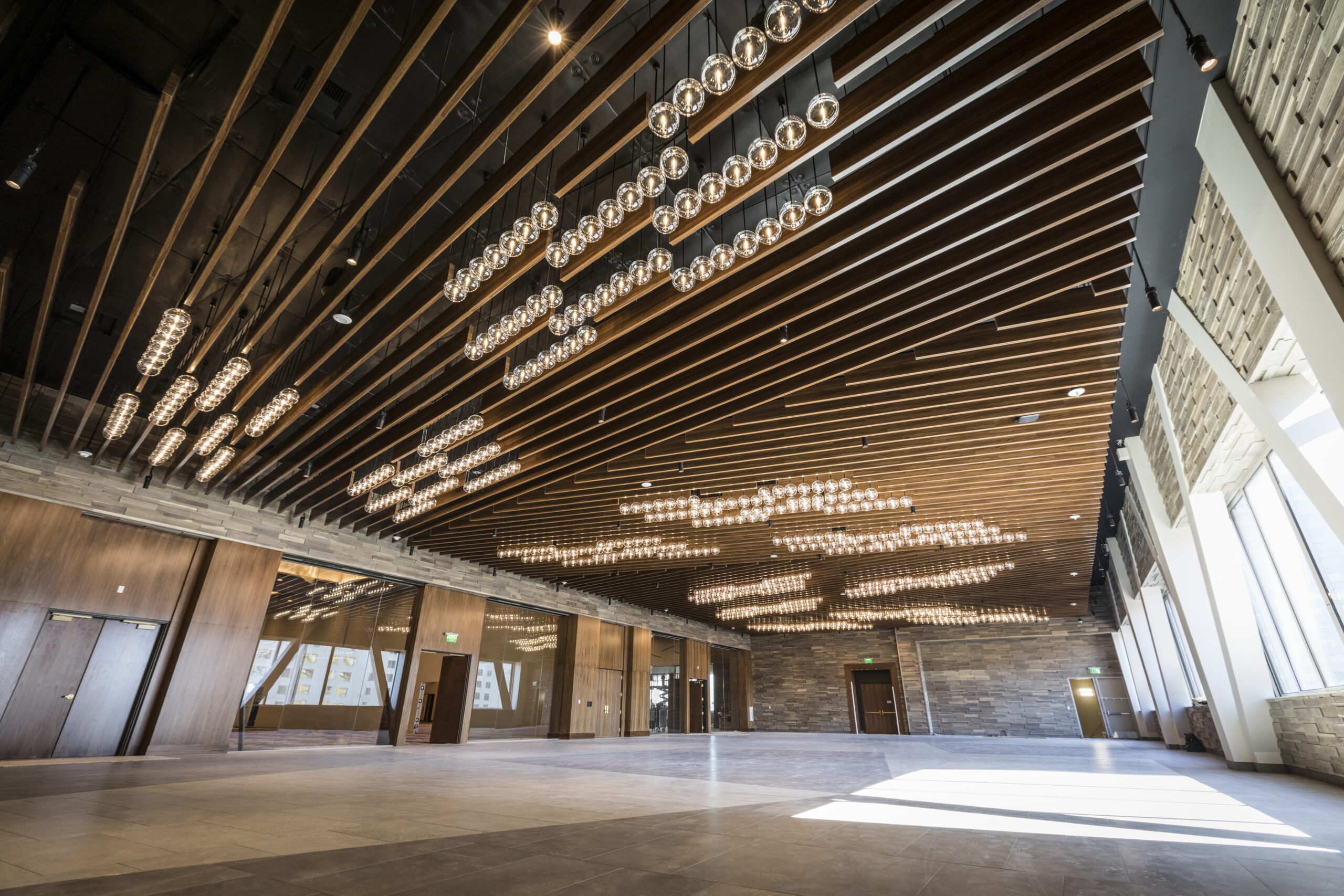 Ceilings can be an underutilized surface, but Pure + FreeForm’s ceiling products make them work harder with seamless, noncombustible panels. Made from at least 20% post-consumer content and free of off-gassing, these refined ceiling baffles help create a calm and health-conscious environment. By finishing to exacting tolerances, the system ensures architects can shape sanctuaries without sacrificing performance or sustainability.
Ceilings can be an underutilized surface, but Pure + FreeForm’s ceiling products make them work harder with seamless, noncombustible panels. Made from at least 20% post-consumer content and free of off-gassing, these refined ceiling baffles help create a calm and health-conscious environment. By finishing to exacting tolerances, the system ensures architects can shape sanctuaries without sacrificing performance or sustainability.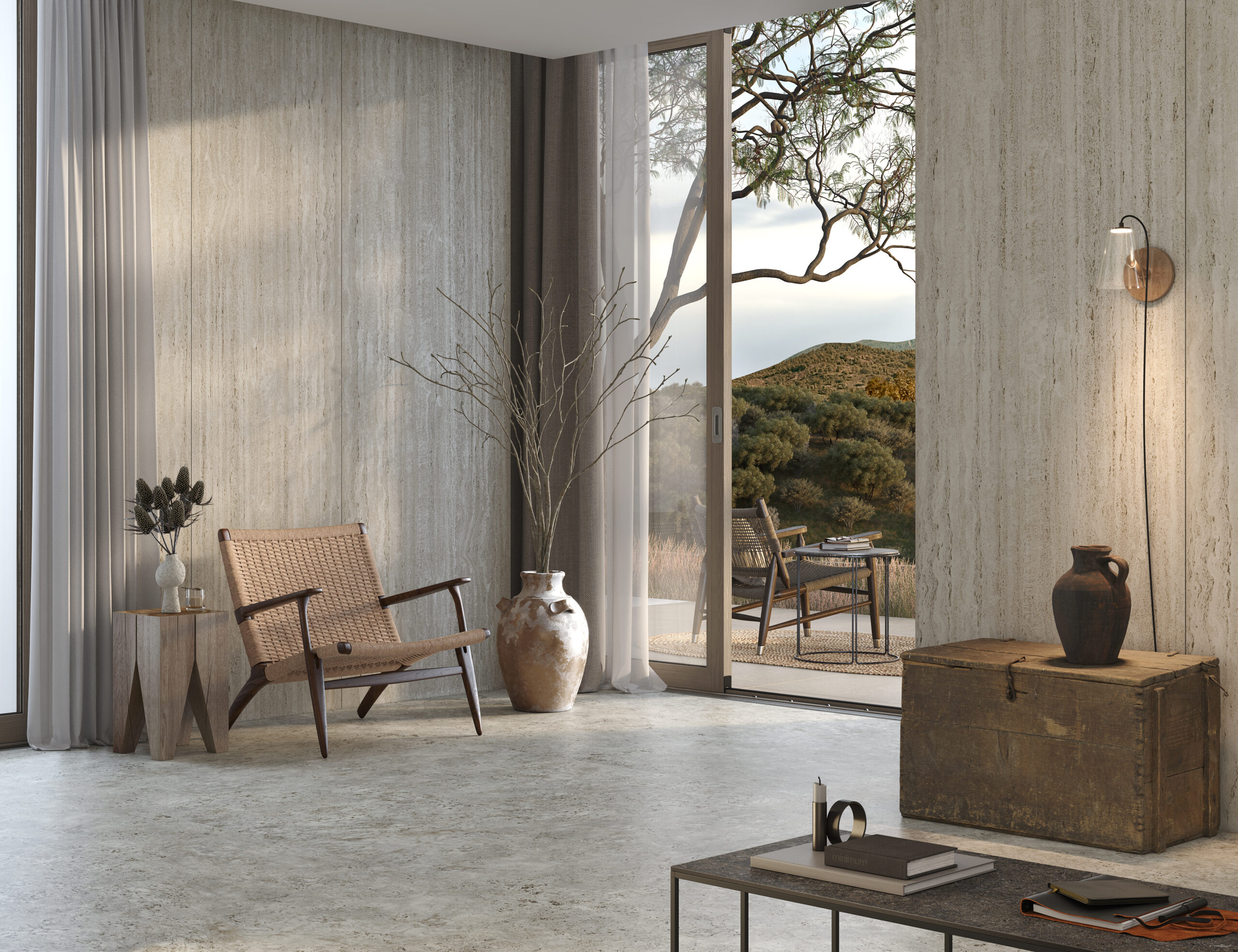 Cosentino’s Dekton® Pietra Kode is the epitome of timeless Italian stone, yet, it is ideal for modern wellness-focused interiors, without the upkeep or carbon footprint of its quarried cousins. Reinterpreted by Daniel Germani, each color retains the grounded serenity of Vicenza, Travertine or Ceppo di Gré yet stands up to everyday demands indoors or out. It is a product that is carbon-neutral, ultra-compact surface that provides quiet luxury with lasting peace of mind.
Cosentino’s Dekton® Pietra Kode is the epitome of timeless Italian stone, yet, it is ideal for modern wellness-focused interiors, without the upkeep or carbon footprint of its quarried cousins. Reinterpreted by Daniel Germani, each color retains the grounded serenity of Vicenza, Travertine or Ceppo di Gré yet stands up to everyday demands indoors or out. It is a product that is carbon-neutral, ultra-compact surface that provides quiet luxury with lasting peace of mind. Turf’s new Wall Scapes turn noise control into an artful statement, layering a double panel system in carved motifs that evoke farmland, forest peaks and waves. Each pattern is cut and configured so the gaps become part of the design. With up to 0.4 NRC for acoustic relief, these large-scale panels bring a calming presence with a dash of visual intrigue. A simple yet effective solution.
Turf’s new Wall Scapes turn noise control into an artful statement, layering a double panel system in carved motifs that evoke farmland, forest peaks and waves. Each pattern is cut and configured so the gaps become part of the design. With up to 0.4 NRC for acoustic relief, these large-scale panels bring a calming presence with a dash of visual intrigue. A simple yet effective solution.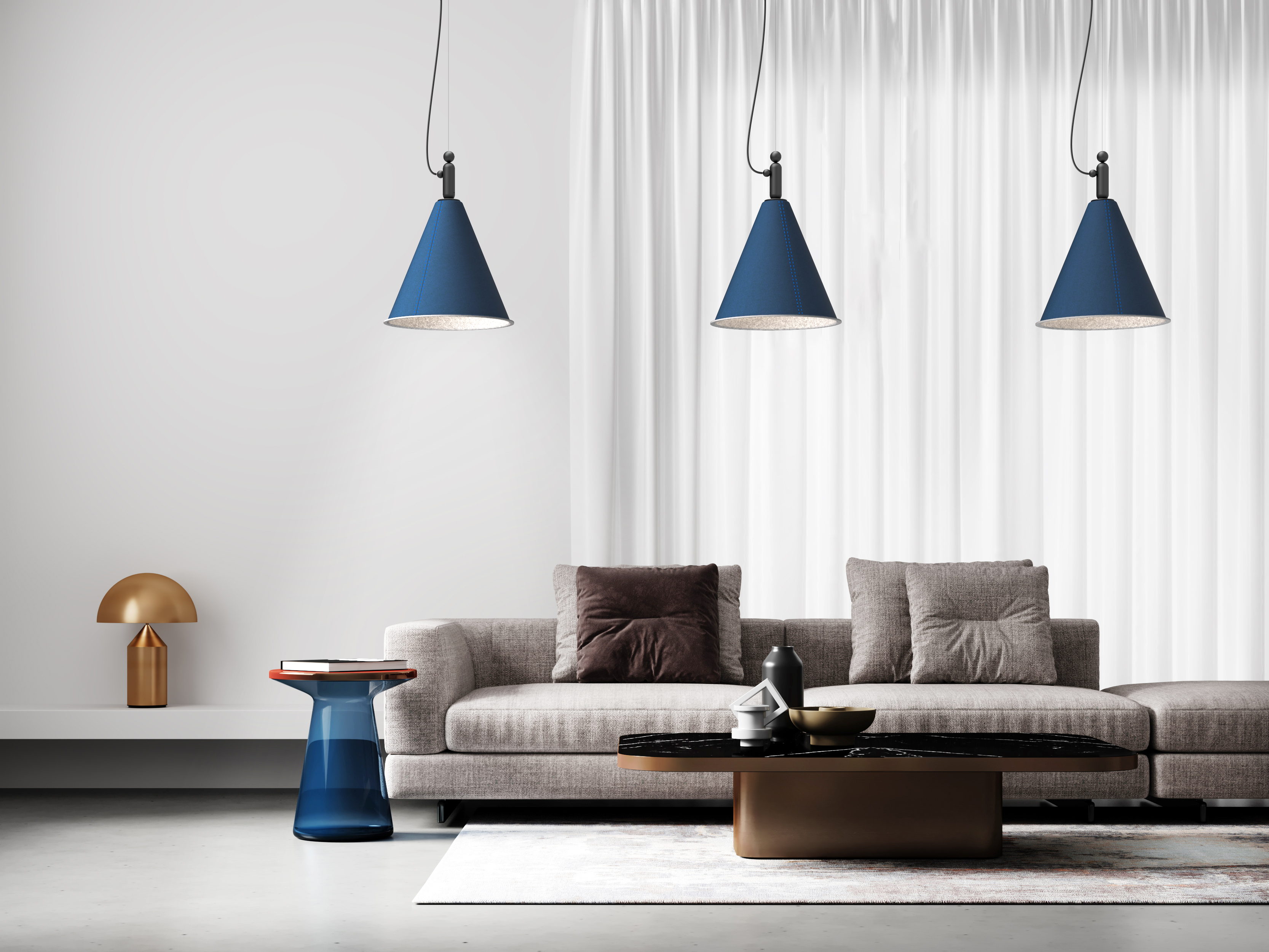 Luxxbox’s Cono pendant hushes background clamor while delivering warm, targeted illumination — exactly what’s needed in a lounge or private nook designed for peaceful conversation. Crafted from renewable wool on a PET shell, it is a multifunctional solution that merges acoustic performance with excellent lighting. Whether hung alone or in clusters, Cono is a brilliant all-rounder product.
Luxxbox’s Cono pendant hushes background clamor while delivering warm, targeted illumination — exactly what’s needed in a lounge or private nook designed for peaceful conversation. Crafted from renewable wool on a PET shell, it is a multifunctional solution that merges acoustic performance with excellent lighting. Whether hung alone or in clusters, Cono is a brilliant all-rounder product.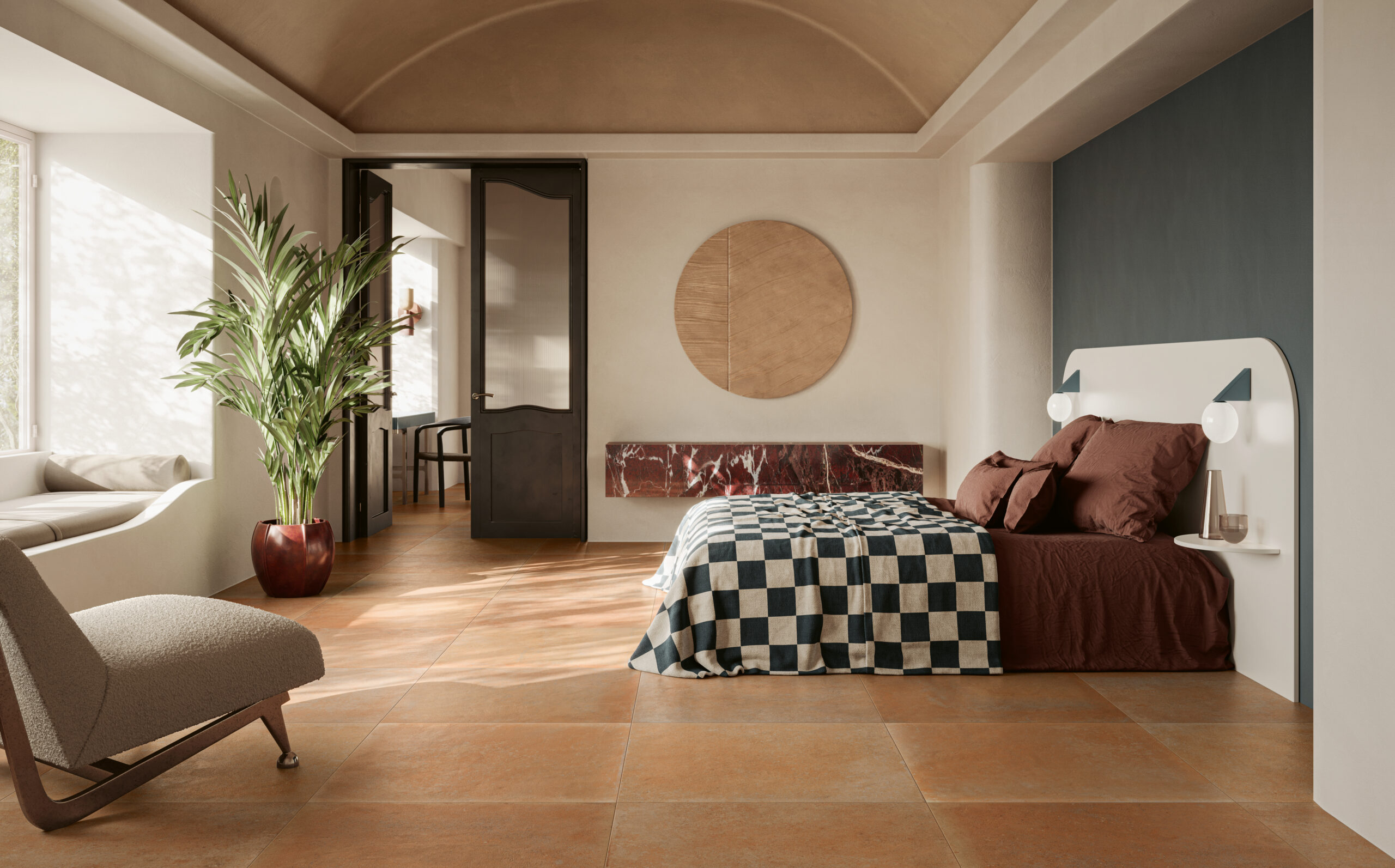 Rustic terracotta rarely feels this contemporary. Italica takes an age-old aesthetic and elevates it for modern projects that demand both comfort and practicality. Five earthy tones — from volcanic reds to salty neutrals — let architects shift between large-format expanses or smaller, modular tiles. By harnessing the strength of porcelain stoneware, Italica enables a stress-free design that respects tradition while encouraging everyday calm.
Rustic terracotta rarely feels this contemporary. Italica takes an age-old aesthetic and elevates it for modern projects that demand both comfort and practicality. Five earthy tones — from volcanic reds to salty neutrals — let architects shift between large-format expanses or smaller, modular tiles. By harnessing the strength of porcelain stoneware, Italica enables a stress-free design that respects tradition while encouraging everyday calm.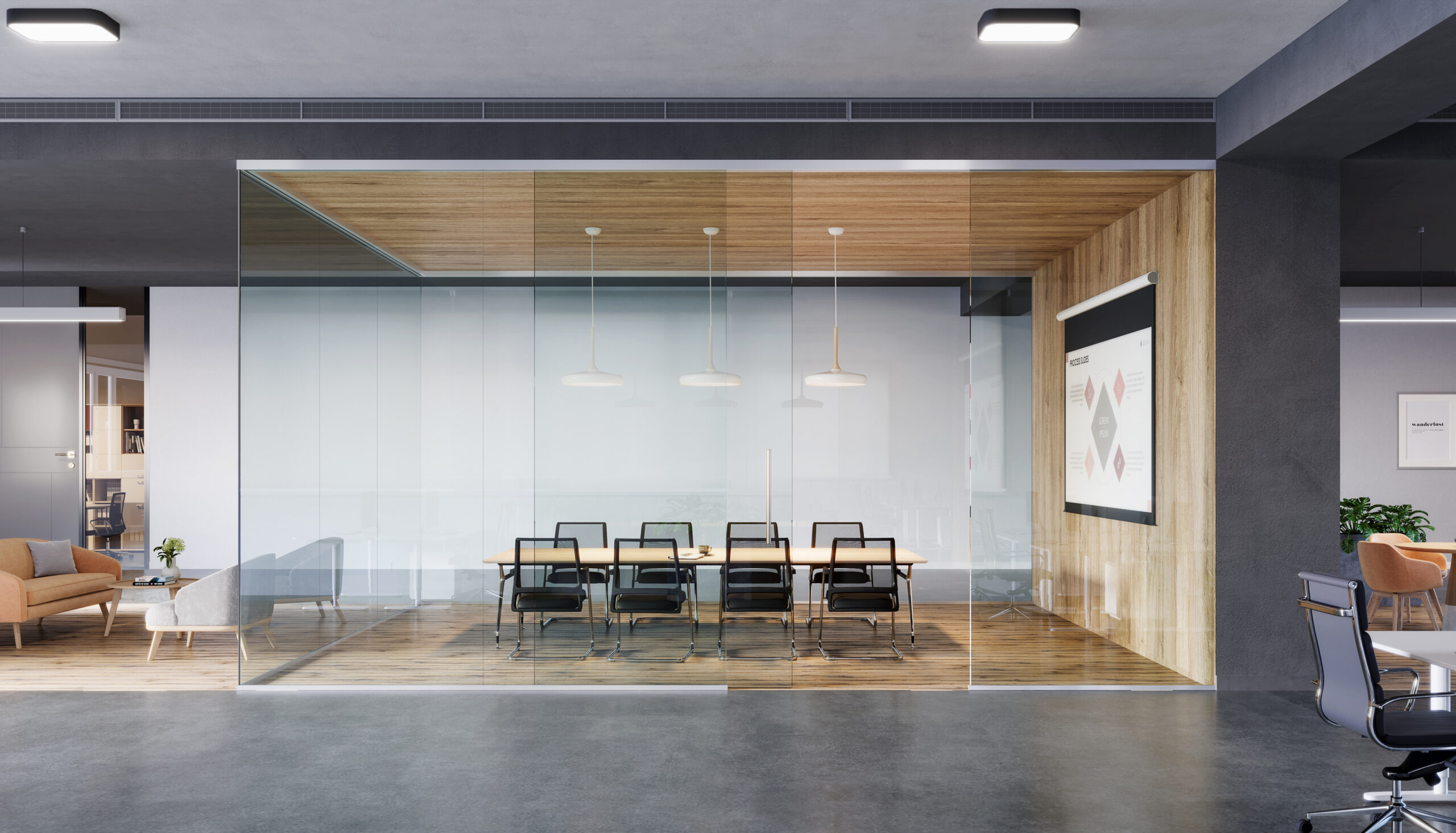 Because nothing kills a quiet space faster than a door that scrapes or squeaks open, CRL’s 690/695 Sliding Door System glides with near-silent grace. A single advanced soft-brake mechanism hushes movement across broad glass spans while the minimal 2.5-inch header all but disappears, letting the architecture speak for itself. In any space aimed at genuine repose, this door helps keep the outside world firmly at bay.
Because nothing kills a quiet space faster than a door that scrapes or squeaks open, CRL’s 690/695 Sliding Door System glides with near-silent grace. A single advanced soft-brake mechanism hushes movement across broad glass spans while the minimal 2.5-inch header all but disappears, letting the architecture speak for itself. In any space aimed at genuine repose, this door helps keep the outside world firmly at bay. Carving serenity from natural timber, the Seyun Collection by Zaha Hadid Design brings calm curves into any environment. Commissioned by Karimoku, the sculptural chairs, stools and tables pair digital precision with hand-finished warmth that’s both visually fluid and physically ergonomically supportive. Sustainably sourced and assembled with minimal waste, each piece aligns with an architect’s pursuit of tranquil, earth-friendly design.
Carving serenity from natural timber, the Seyun Collection by Zaha Hadid Design brings calm curves into any environment. Commissioned by Karimoku, the sculptural chairs, stools and tables pair digital precision with hand-finished warmth that’s both visually fluid and physically ergonomically supportive. Sustainably sourced and assembled with minimal waste, each piece aligns with an architect’s pursuit of tranquil, earth-friendly design. As much as they might try plants, on their own, can’t do everything, but that’s where CSI Creative’s Bio-Acoustic Claypot Wall Panel comes in to help. Combining serious sound-dampening with botanic design, the recycled felt and terracotta wall planters referenced from African craft, integrate greenery in a modular recoverable system that architects and designers can install without the need for a horticulture degree. The result is a visually tactile surface that balances cultural authenticity and acoustic performance.
As much as they might try plants, on their own, can’t do everything, but that’s where CSI Creative’s Bio-Acoustic Claypot Wall Panel comes in to help. Combining serious sound-dampening with botanic design, the recycled felt and terracotta wall planters referenced from African craft, integrate greenery in a modular recoverable system that architects and designers can install without the need for a horticulture degree. The result is a visually tactile surface that balances cultural authenticity and acoustic performance.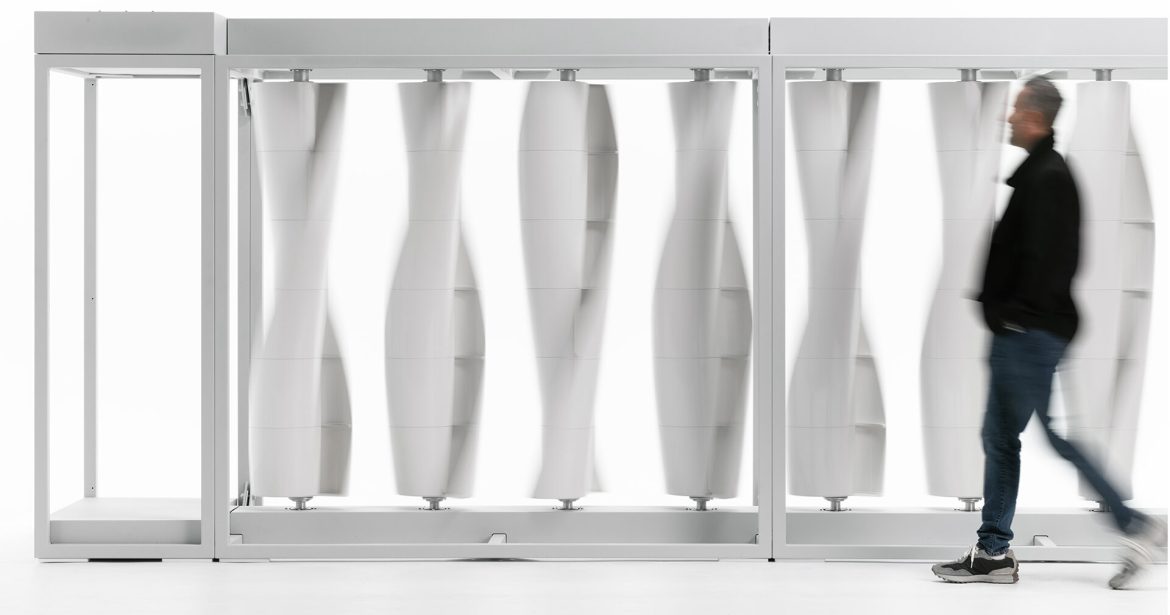
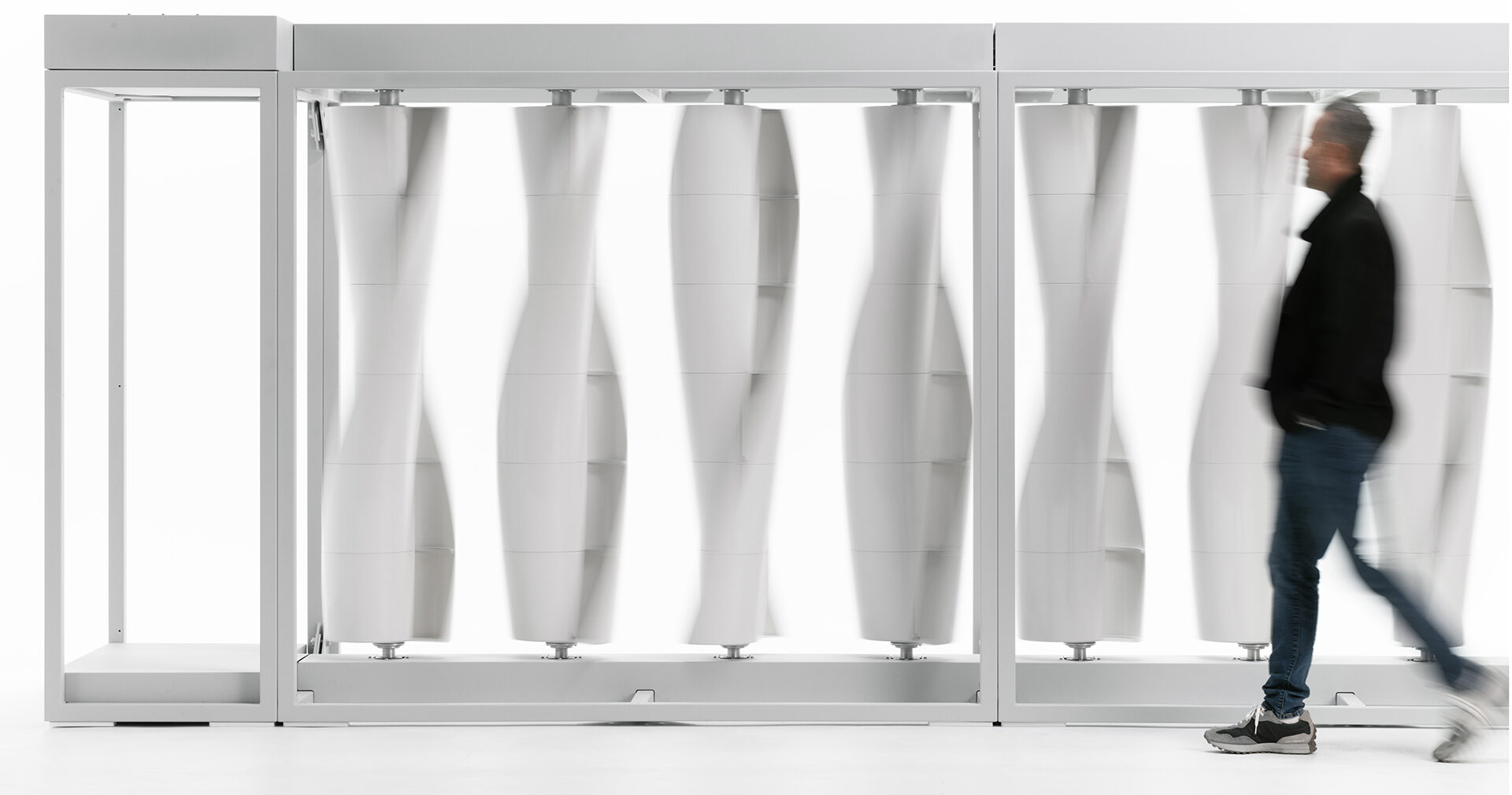 Hannah Feniak: What inspired the creation of the Airiva wind energy system; could you provide a bit of background behind its development?
Hannah Feniak: What inspired the creation of the Airiva wind energy system; could you provide a bit of background behind its development?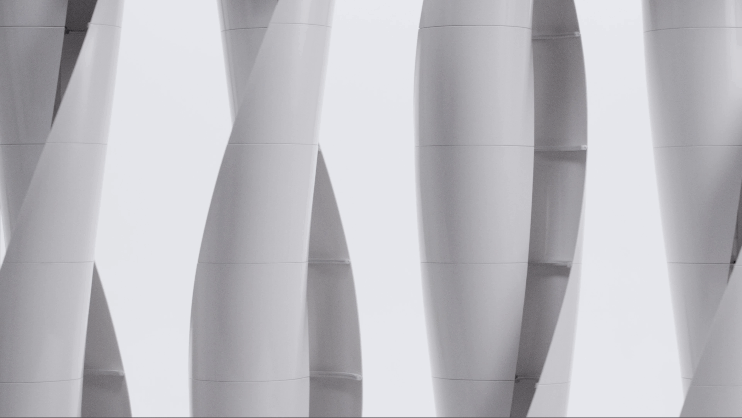
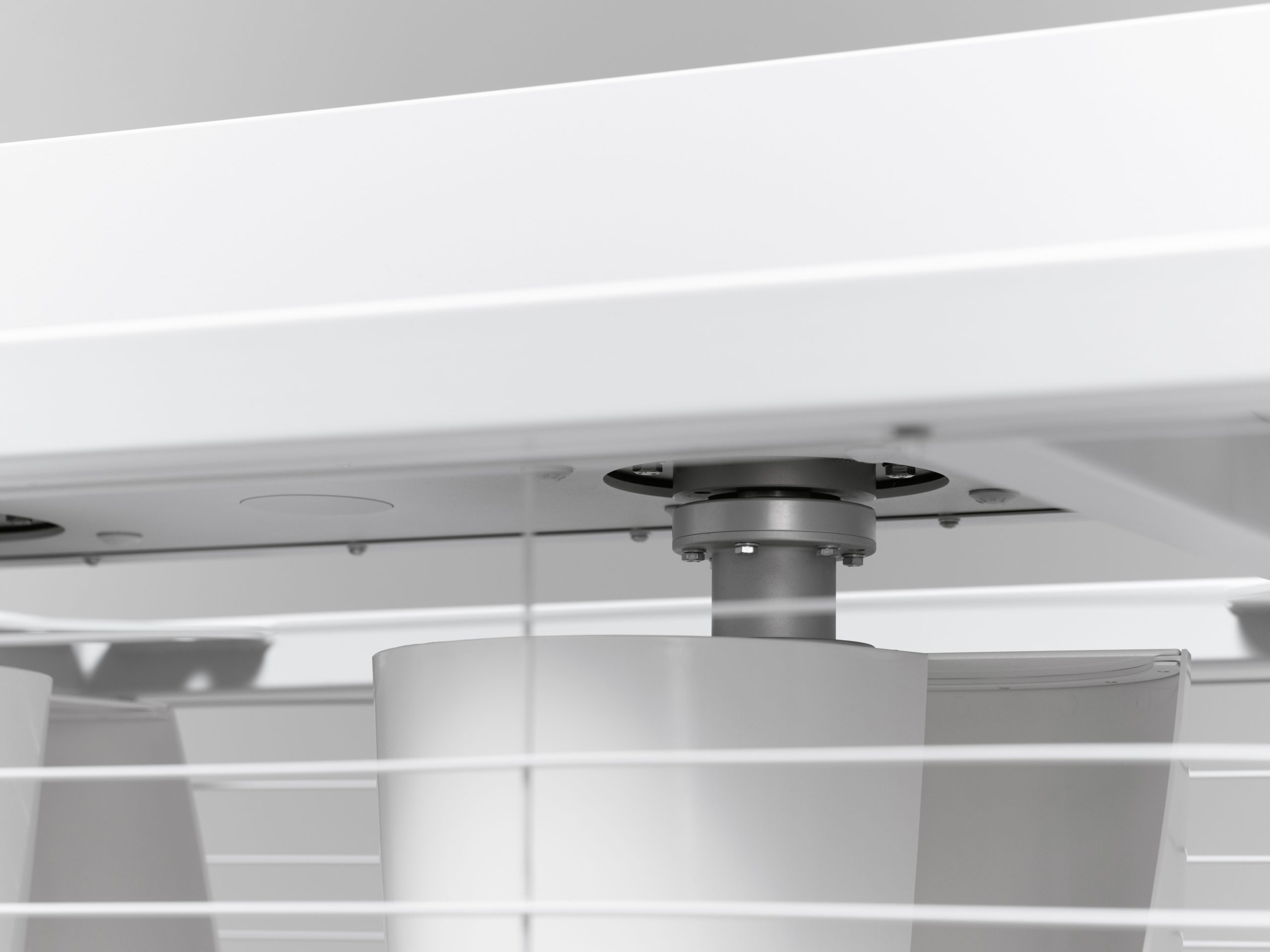
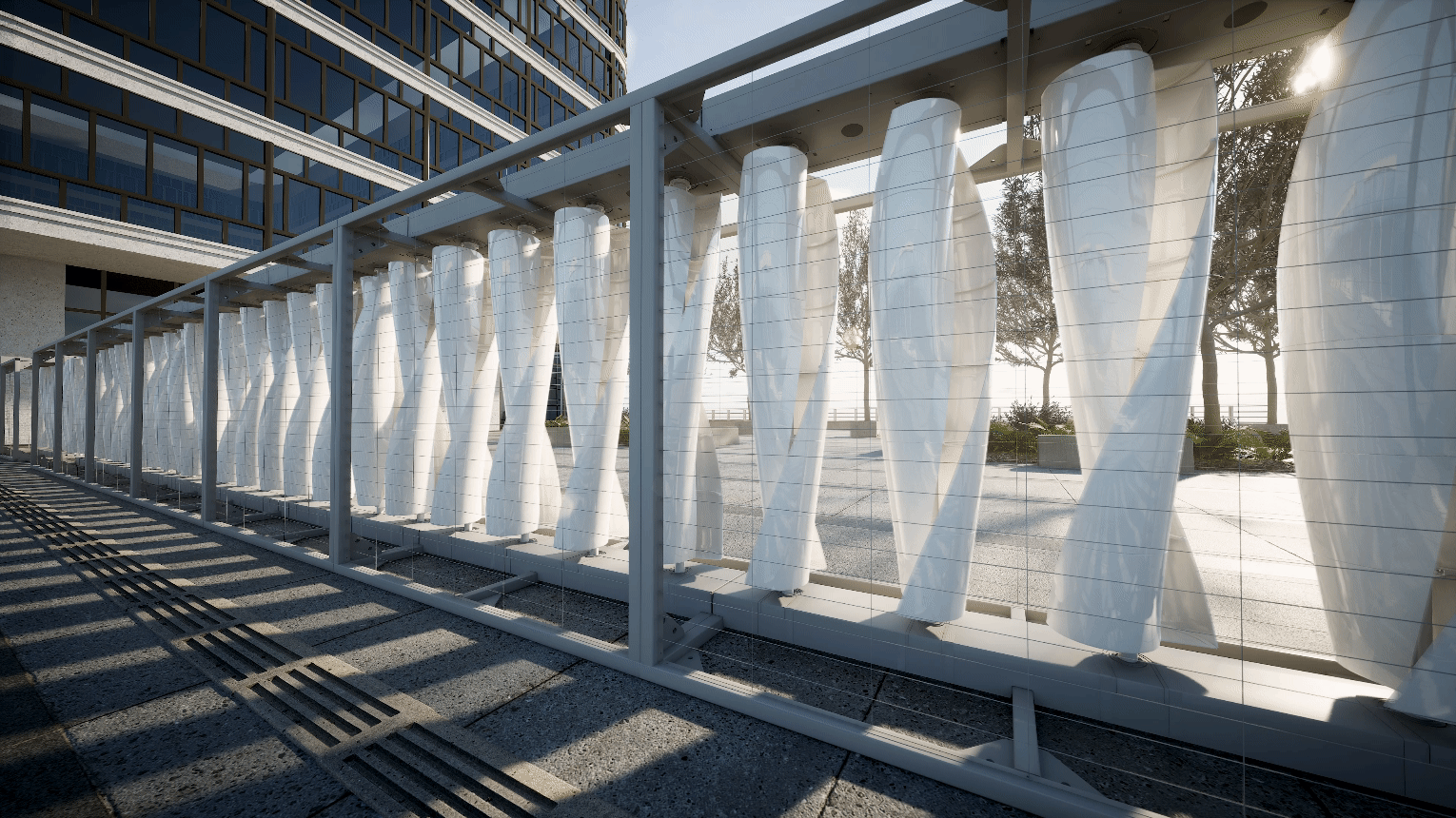
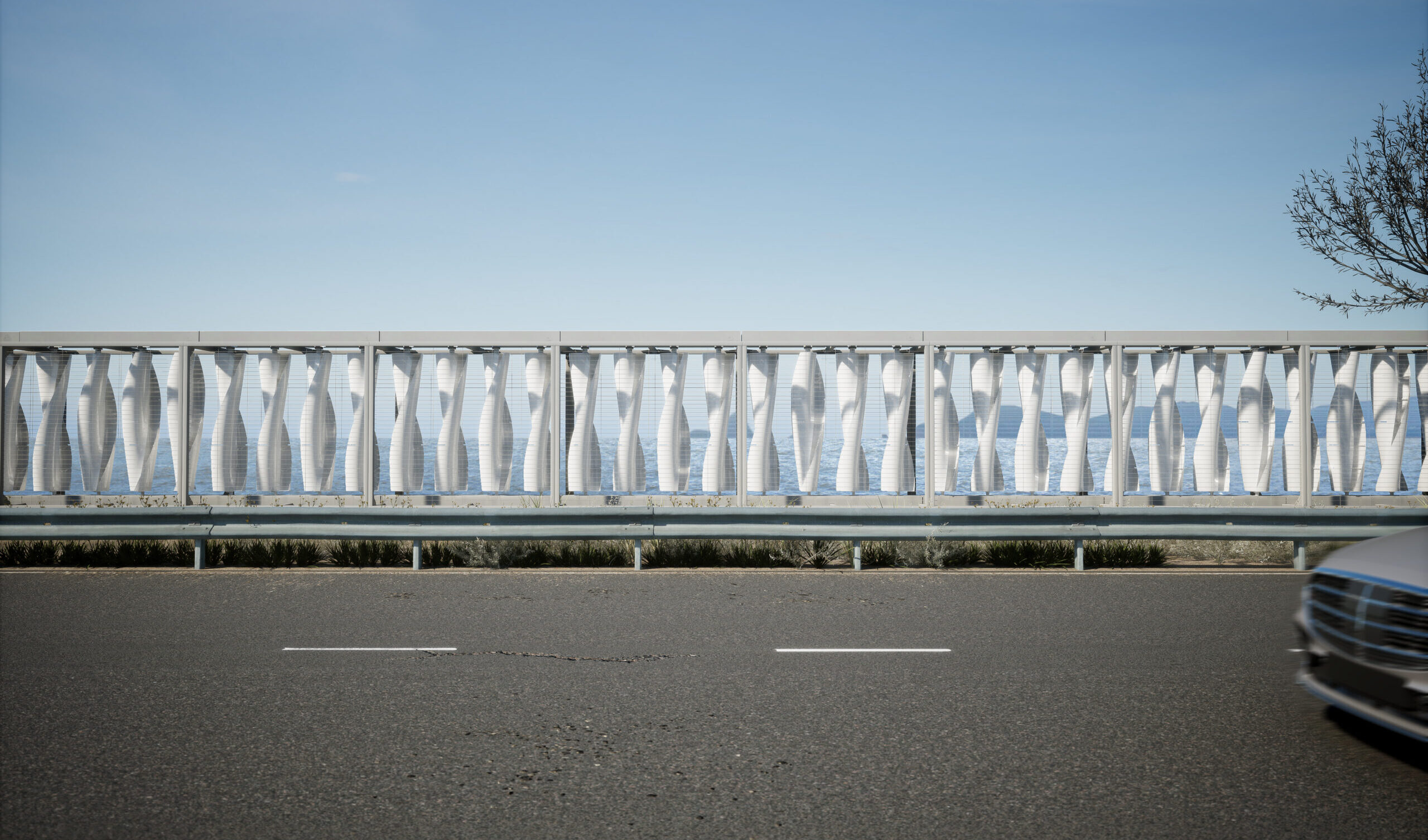 What does winning an A+Product Award mean to you and your team?
What does winning an A+Product Award mean to you and your team?
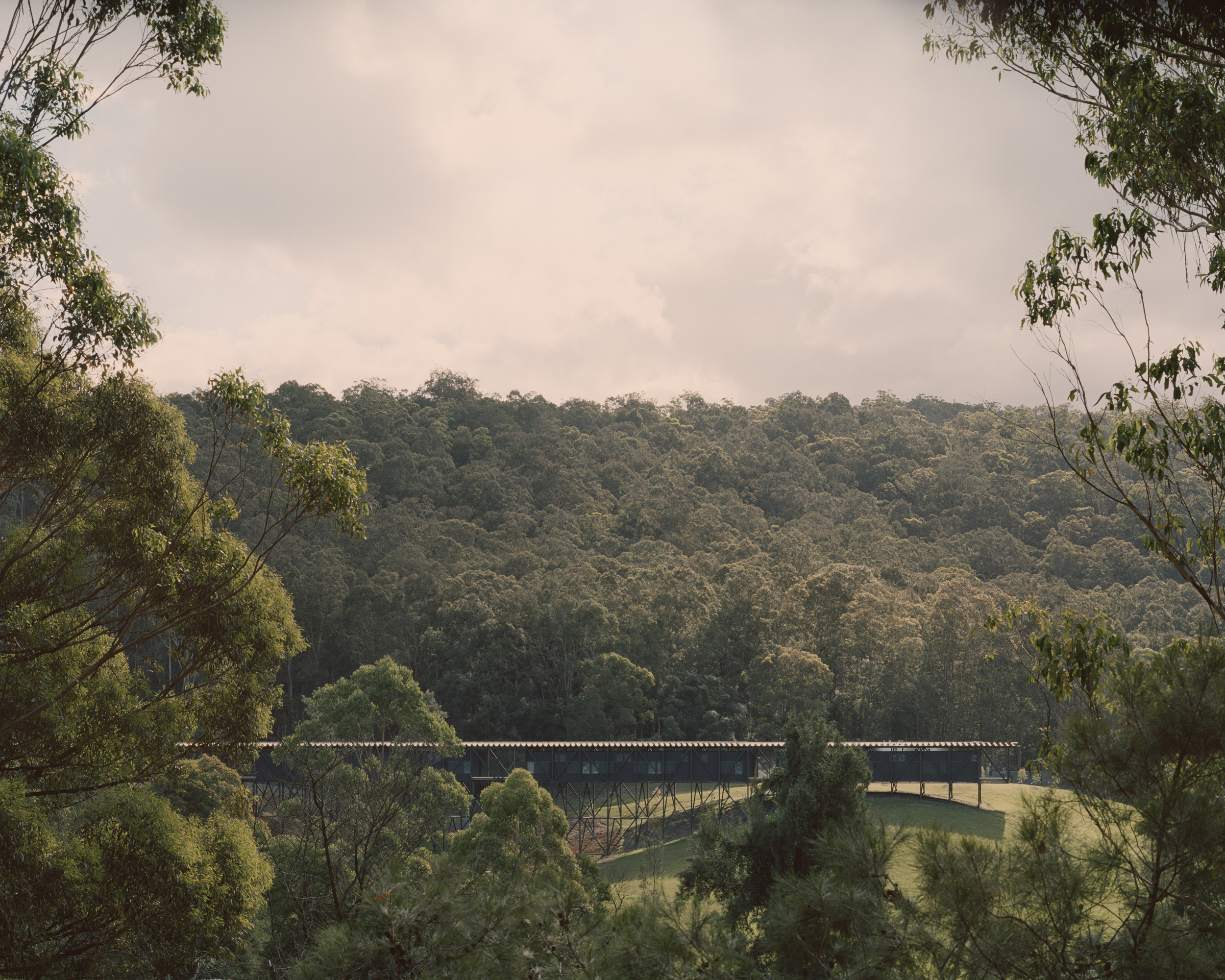
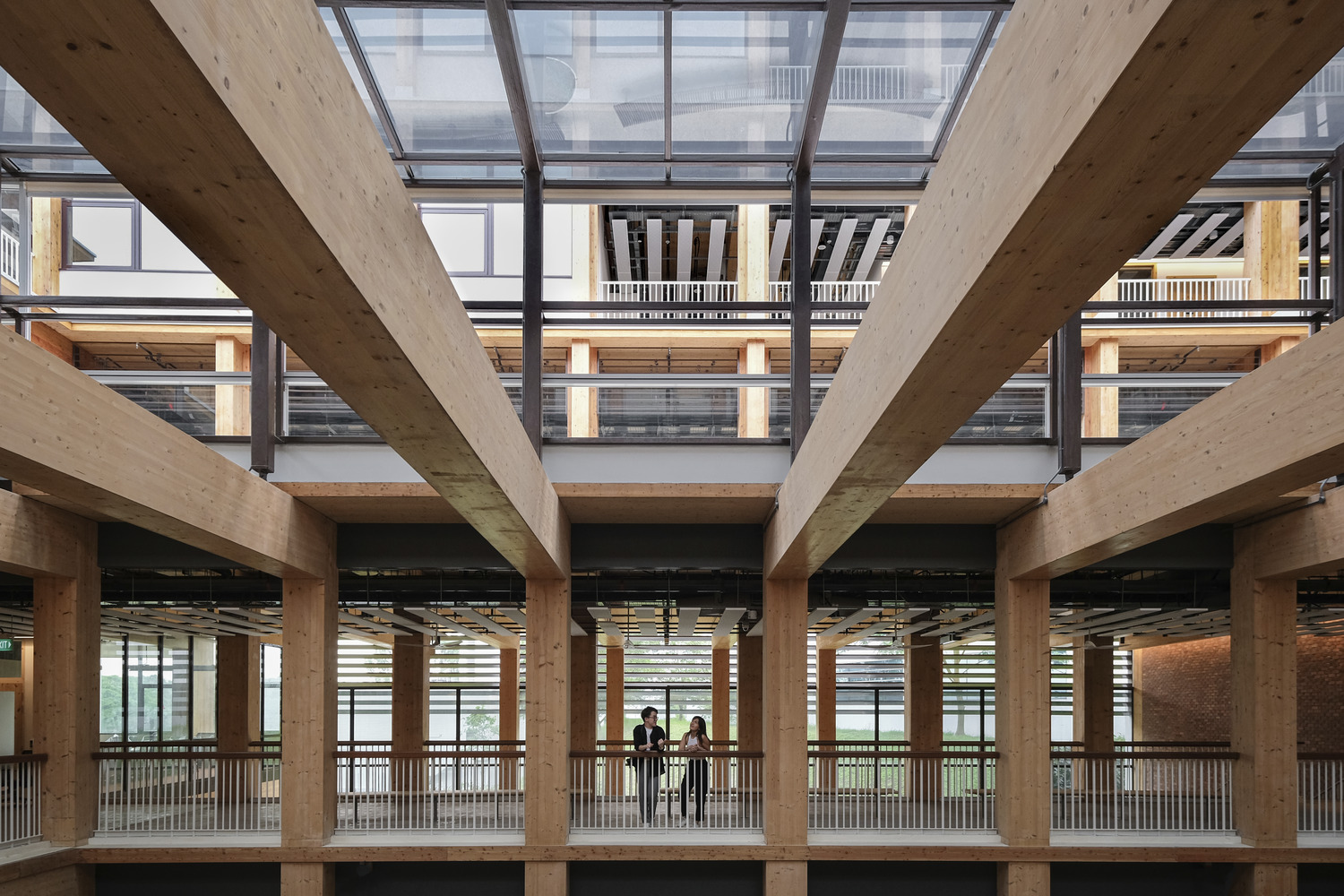
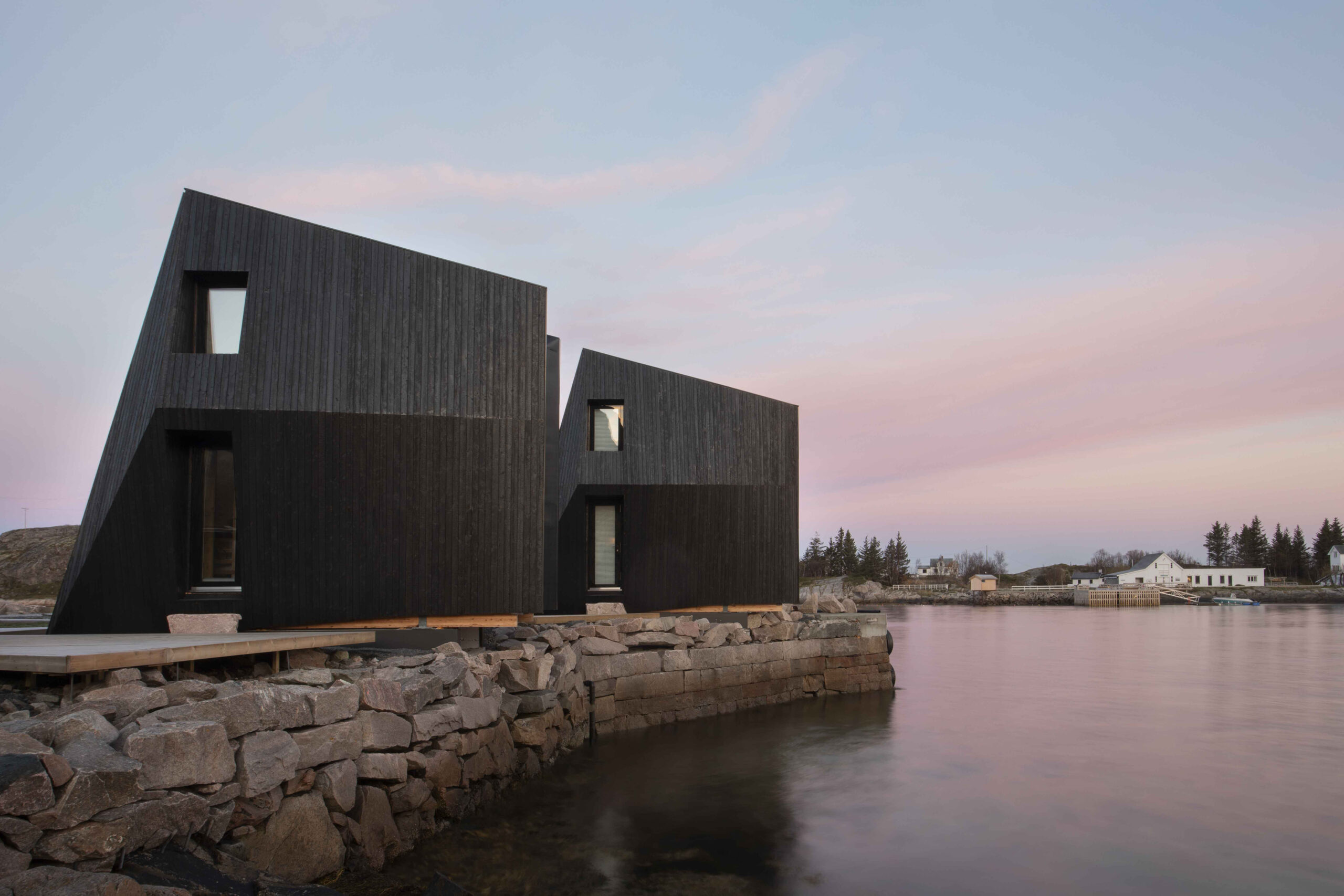
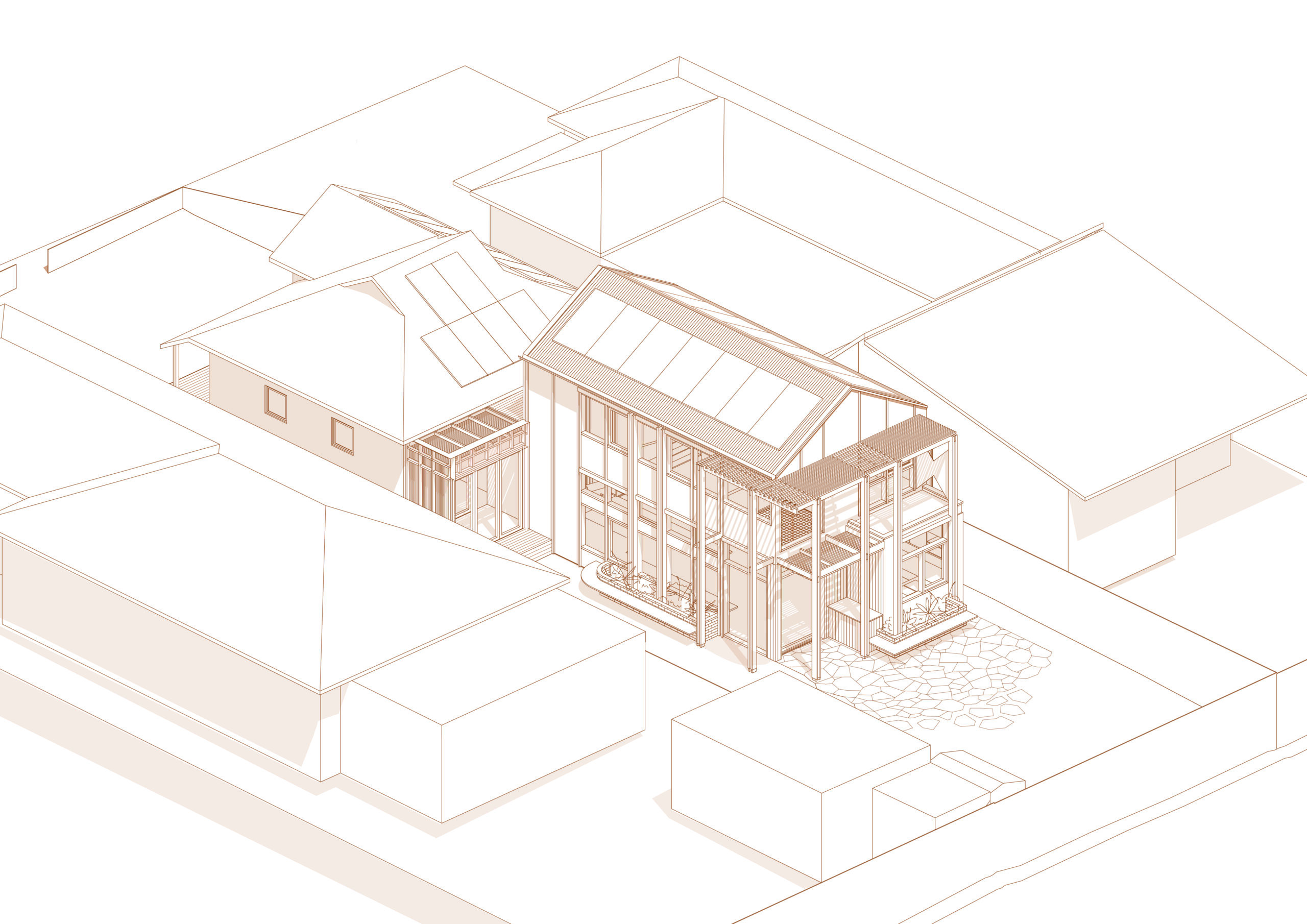
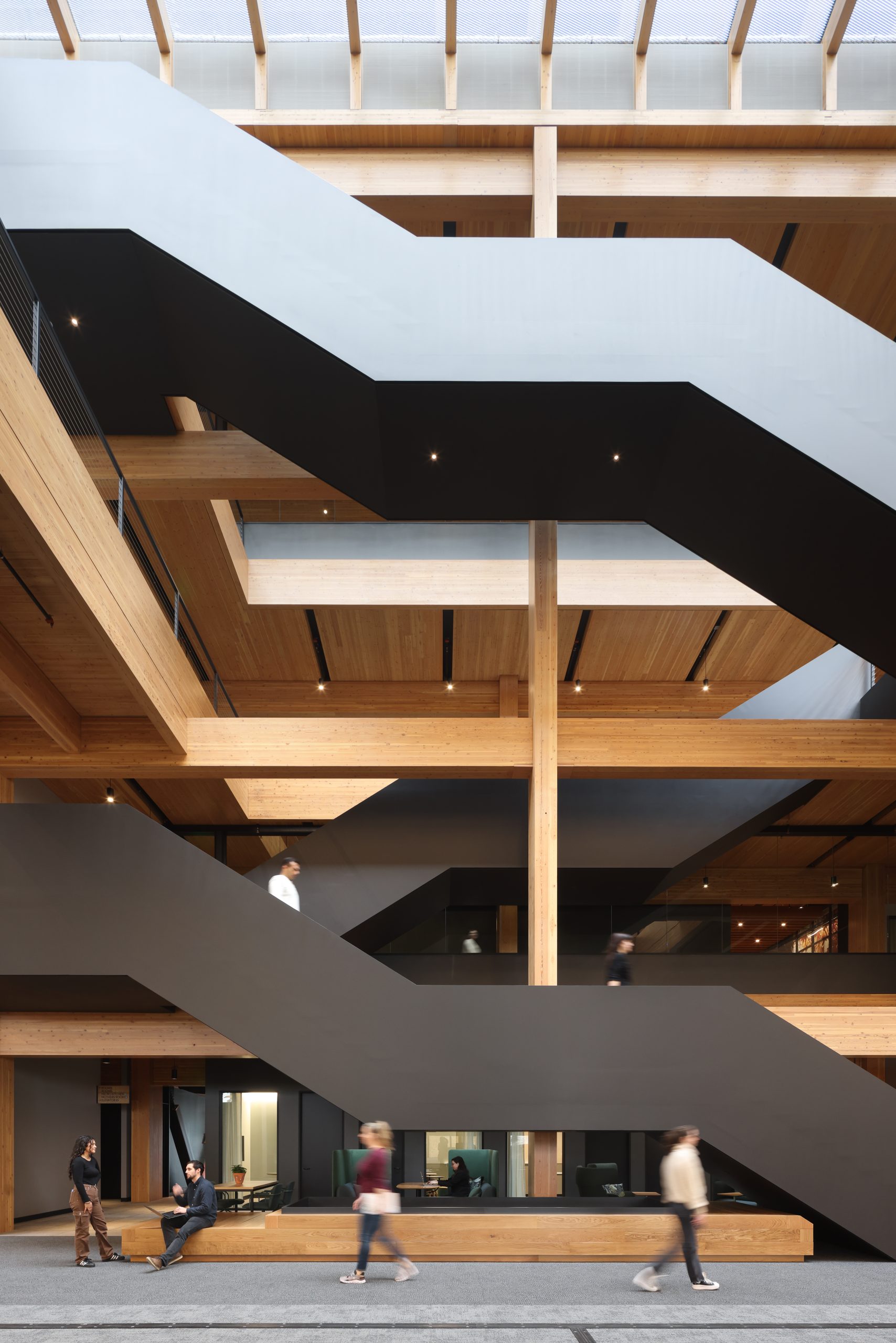
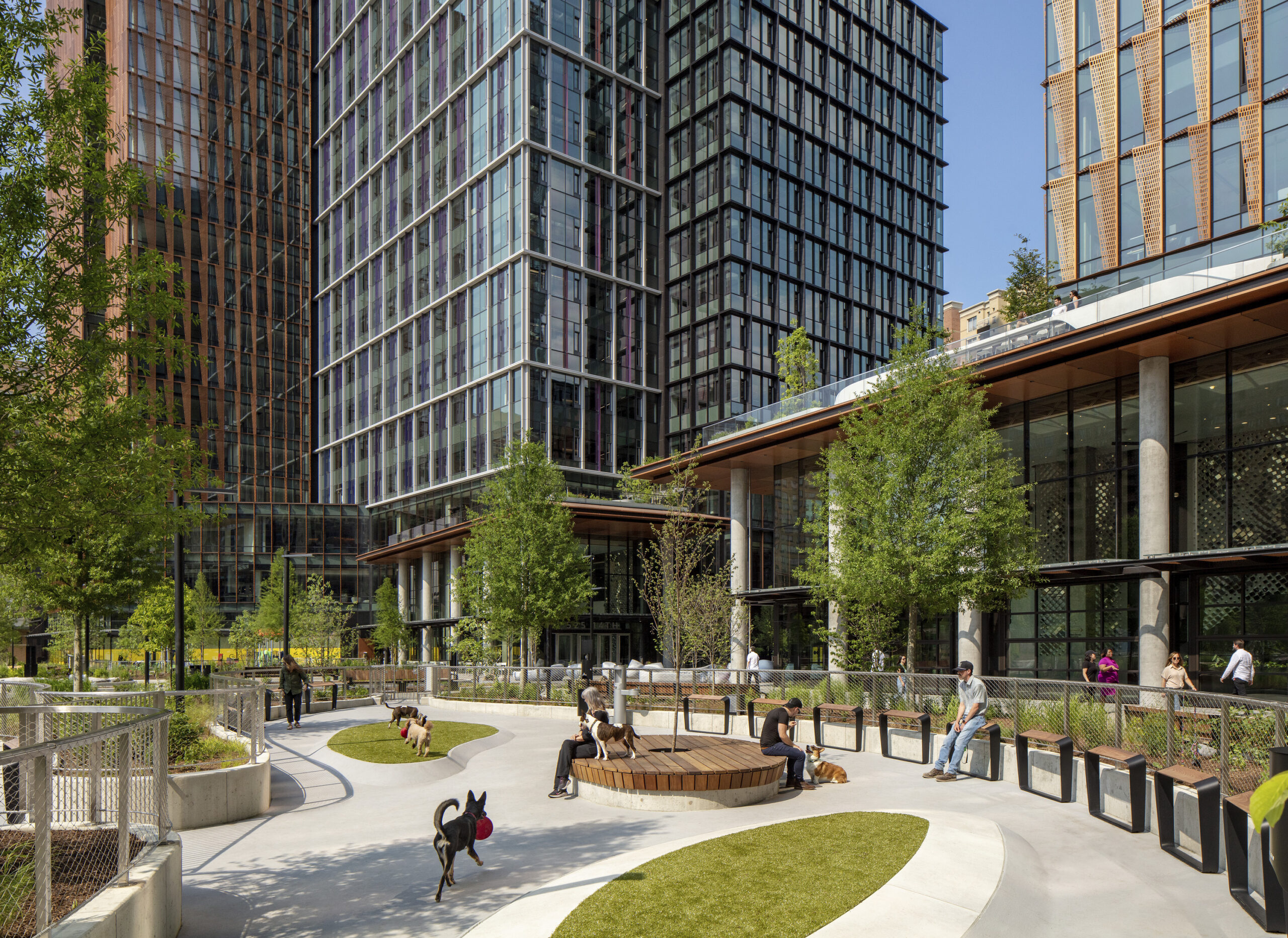
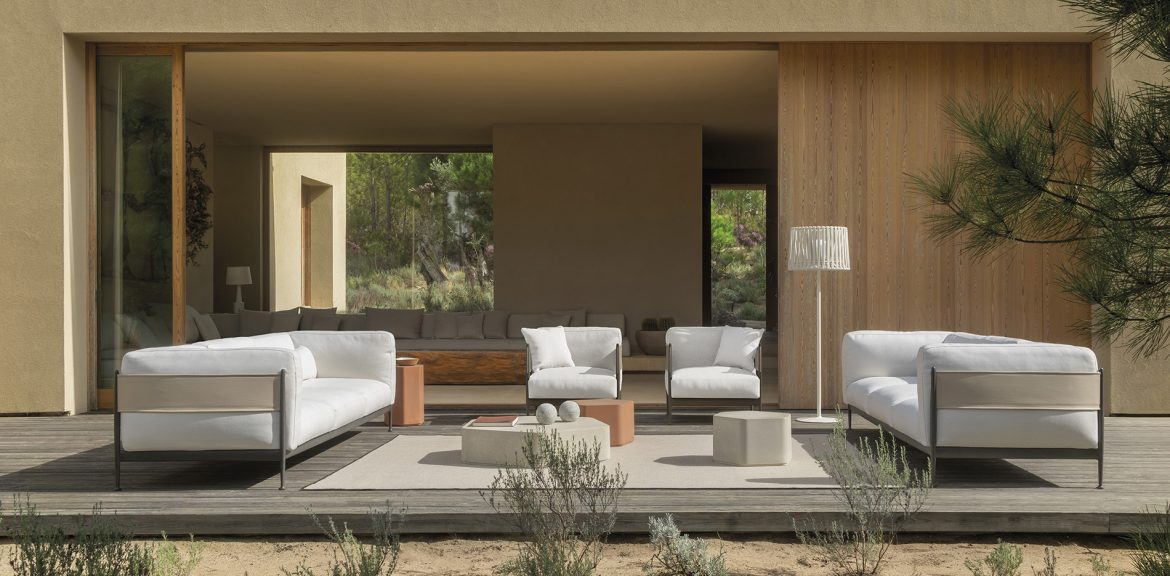
 Inspired by Japanese tradition, Obi’s elastic band detail brings a bold, graphic edge to its elegant design. This seemingly simple feature adds a layer of sophistication, echoing the “obi” sash that adorns traditional kimonos. With an aluminum frame and indoor-level comfort, Obi is a modern outdoor seating collection that perfectly balances simplicity with style, making it ideal for terraces or garden spaces.
Inspired by Japanese tradition, Obi’s elastic band detail brings a bold, graphic edge to its elegant design. This seemingly simple feature adds a layer of sophistication, echoing the “obi” sash that adorns traditional kimonos. With an aluminum frame and indoor-level comfort, Obi is a modern outdoor seating collection that perfectly balances simplicity with style, making it ideal for terraces or garden spaces.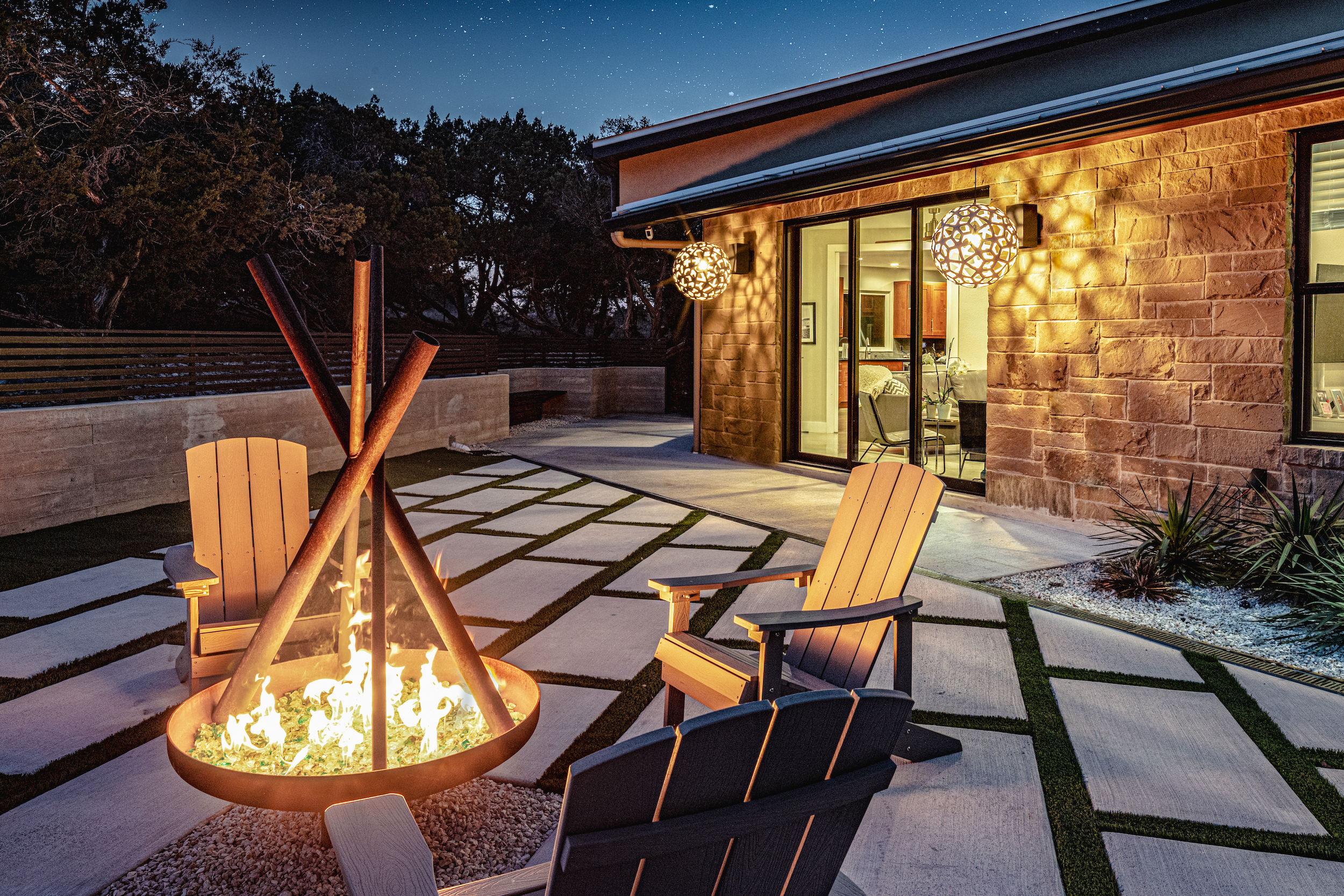 Marking 20 years of design excellence, Outdoor Coral combines geometric beauty with eco-conscious materials. Inspired by nature’s intricate forms, its Panelex construction ensures both visual and environmental longevity. Whether installed as a statement piece or in clusters, Outdoor Coral is perfect for outdoor spaces, casting intricate shadows that add texture and mood to any setting.
Marking 20 years of design excellence, Outdoor Coral combines geometric beauty with eco-conscious materials. Inspired by nature’s intricate forms, its Panelex construction ensures both visual and environmental longevity. Whether installed as a statement piece or in clusters, Outdoor Coral is perfect for outdoor spaces, casting intricate shadows that add texture and mood to any setting.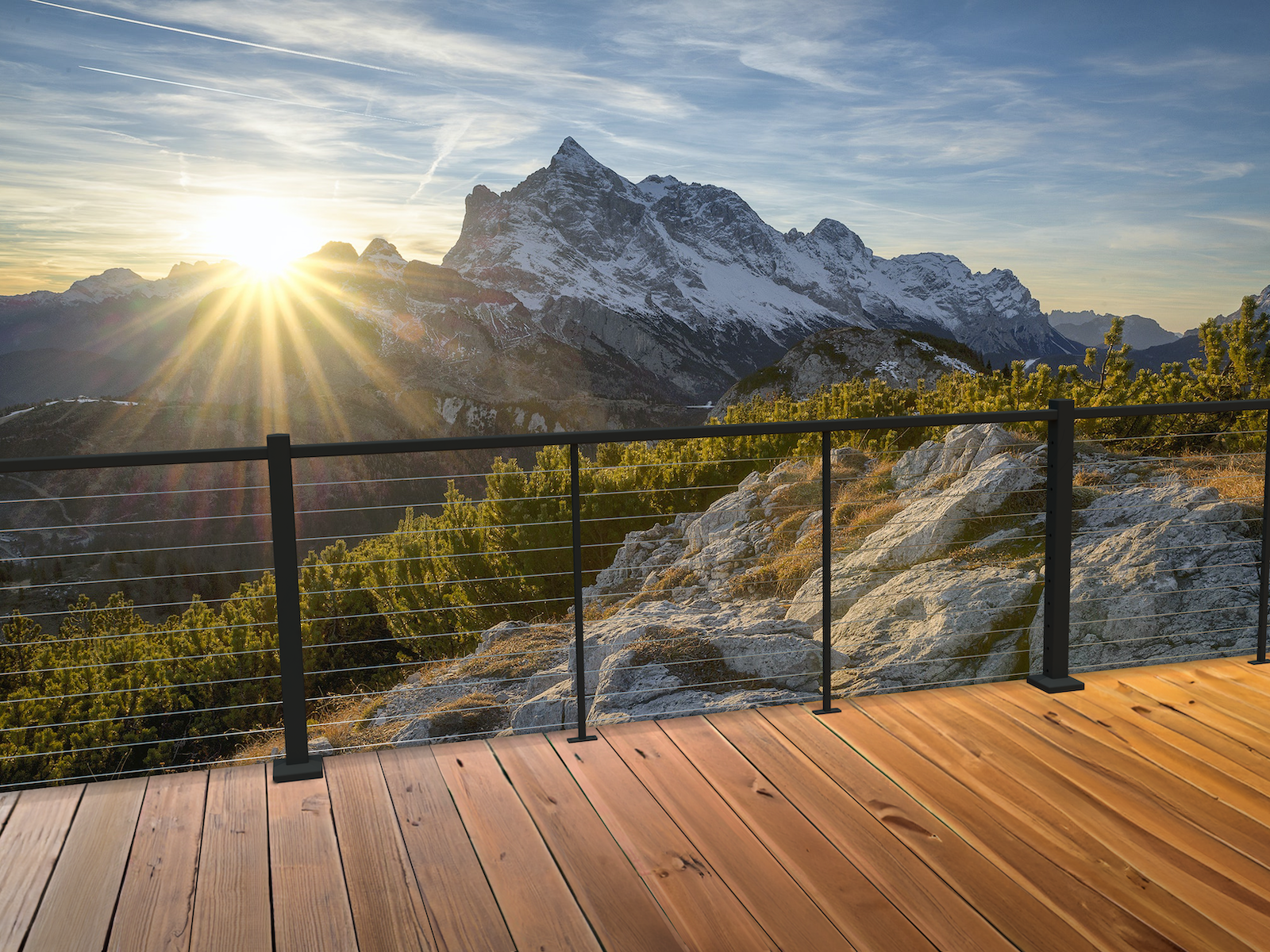 This cable railing system is engineered specifically for unobstructed views and contemporary appeal, with hidden fasteners and a minimalist aesthetic. Its modular design allows for long spans, reducing the need for additional posts and, in turn, opening up vistas. Optional features like LED-ready rails and DrinkRail enhance both practicality and evening ambiance, making it an exceptional choice for patios, balconies and other outdoor living areas.
This cable railing system is engineered specifically for unobstructed views and contemporary appeal, with hidden fasteners and a minimalist aesthetic. Its modular design allows for long spans, reducing the need for additional posts and, in turn, opening up vistas. Optional features like LED-ready rails and DrinkRail enhance both practicality and evening ambiance, making it an exceptional choice for patios, balconies and other outdoor living areas.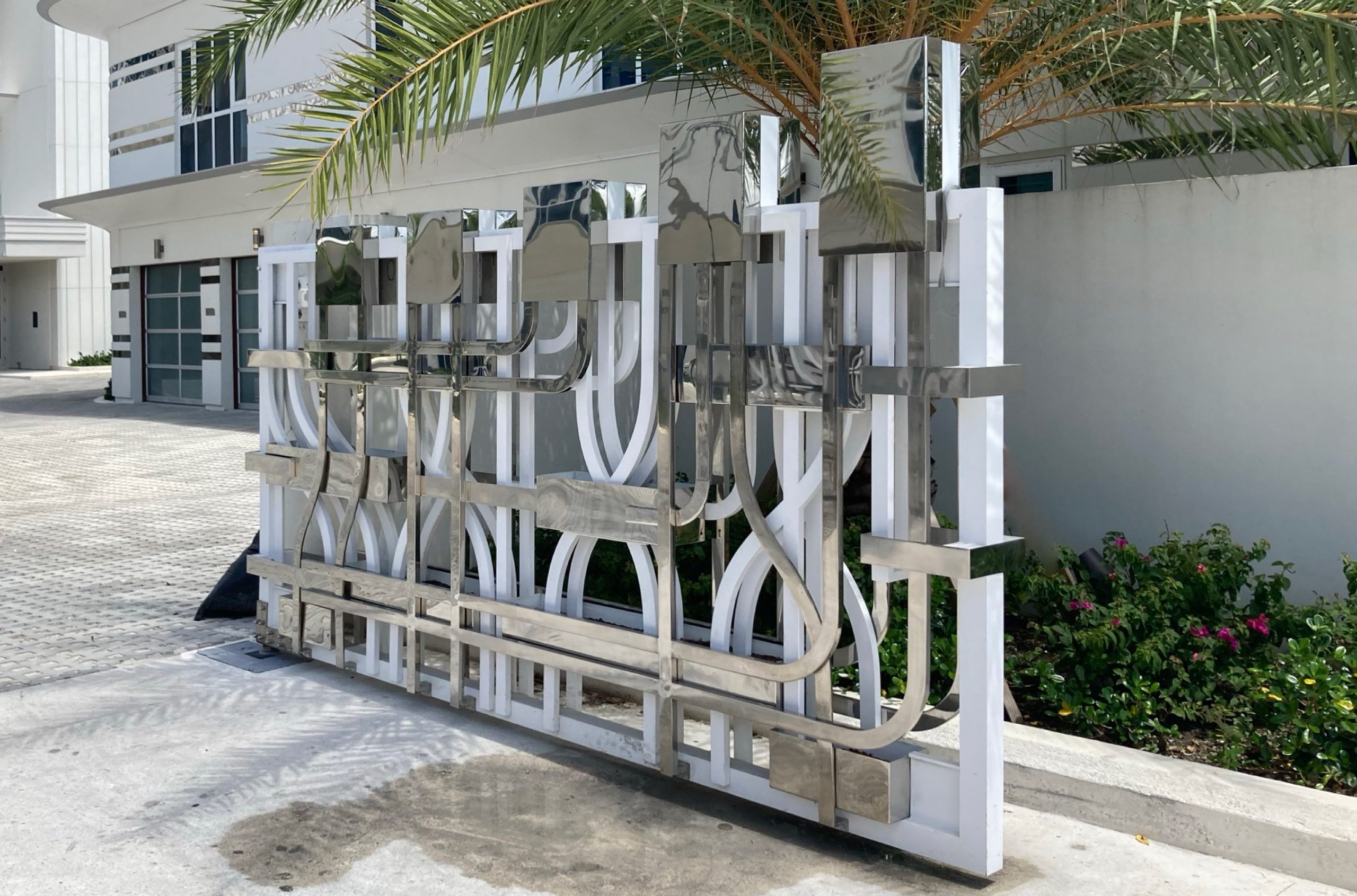 Combining Art Deco aesthetics with cutting-edge craftsmanship, Coastal Metal Sculpture uses stainless steel and dynamic LED lighting to animate facades and railings. Each piece is meticulously designed using both traditional and innovative techniques. Its bold lines and striking mirror finish bring a sculptural element to exterior spaces, elevating them into visual landmarks.
Combining Art Deco aesthetics with cutting-edge craftsmanship, Coastal Metal Sculpture uses stainless steel and dynamic LED lighting to animate facades and railings. Each piece is meticulously designed using both traditional and innovative techniques. Its bold lines and striking mirror finish bring a sculptural element to exterior spaces, elevating them into visual landmarks.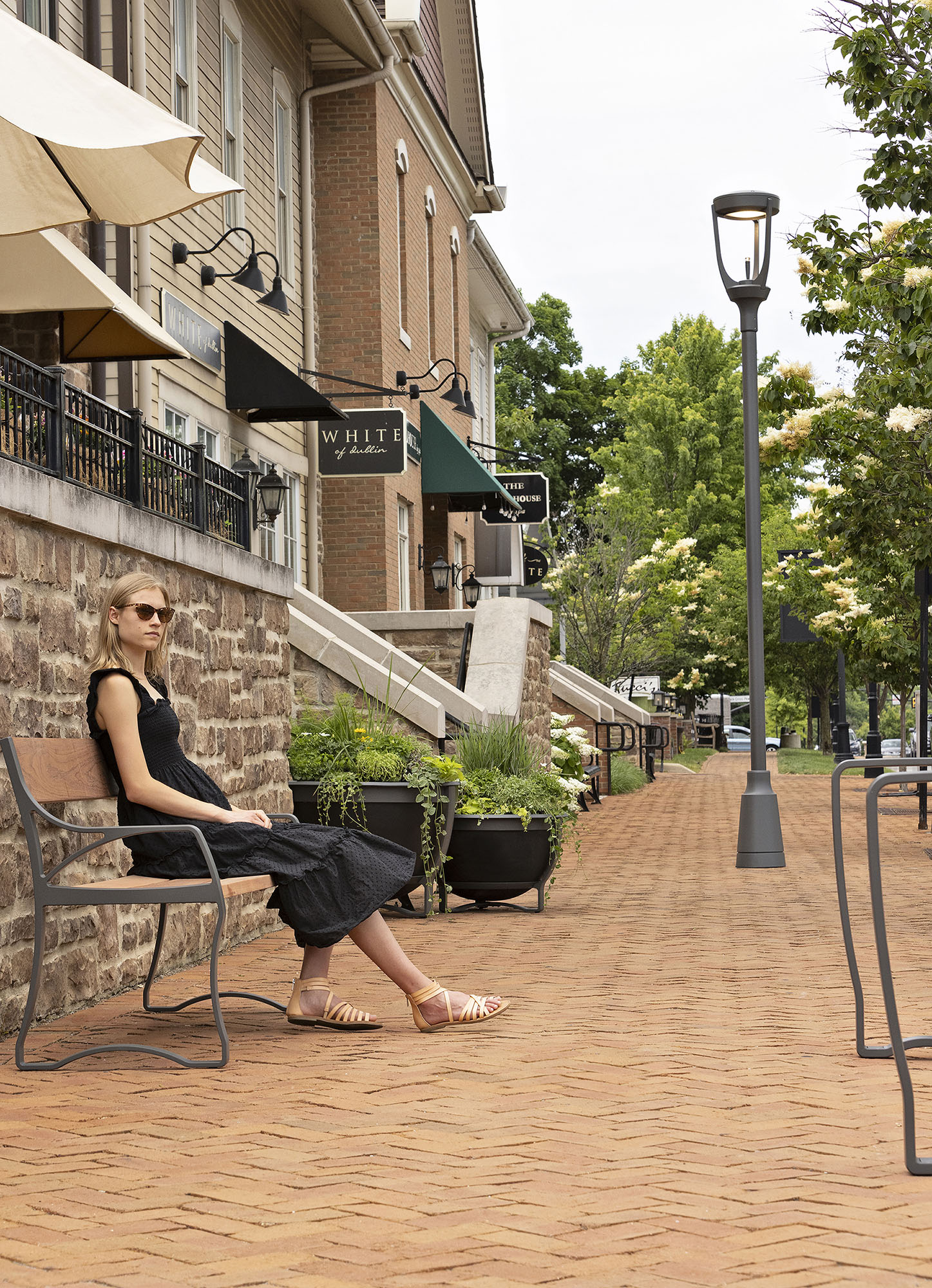 Northport reinvents traditional acorn street lamps with a refined, minimalist approach. Its subtle negative-space design evokes nostalgia while remaining contemporary, offering versatility for parks, promenades, and historic streetscapes. Combined with adjustable LED technology, Northport Lighting balances heritage and innovation, creating exteriors that feel timeless yet firmly rooted in the present.
Northport reinvents traditional acorn street lamps with a refined, minimalist approach. Its subtle negative-space design evokes nostalgia while remaining contemporary, offering versatility for parks, promenades, and historic streetscapes. Combined with adjustable LED technology, Northport Lighting balances heritage and innovation, creating exteriors that feel timeless yet firmly rooted in the present.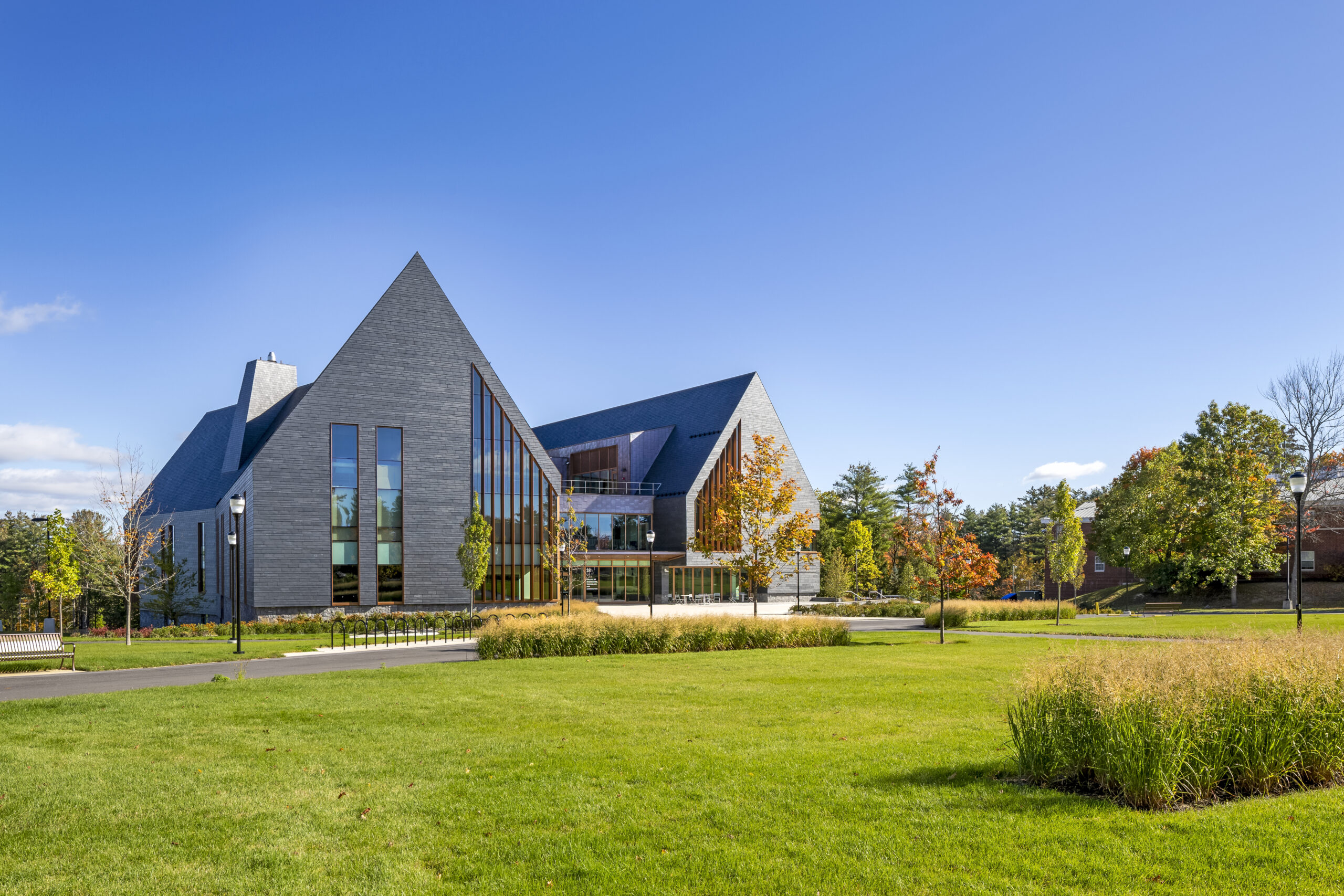 CUPACLAD’s natural slate façade offers a durability that will last for over a century, with no maintenance required. The carbon-neutral production process reflects CUPA’s commitment to sustainability, while its versatility allows architects to experiment with both traditional and modern compositions. Whether used for residential or commercial projects, CUPACLAD exemplifies the strength and beauty of natural materials.
CUPACLAD’s natural slate façade offers a durability that will last for over a century, with no maintenance required. The carbon-neutral production process reflects CUPA’s commitment to sustainability, while its versatility allows architects to experiment with both traditional and modern compositions. Whether used for residential or commercial projects, CUPACLAD exemplifies the strength and beauty of natural materials.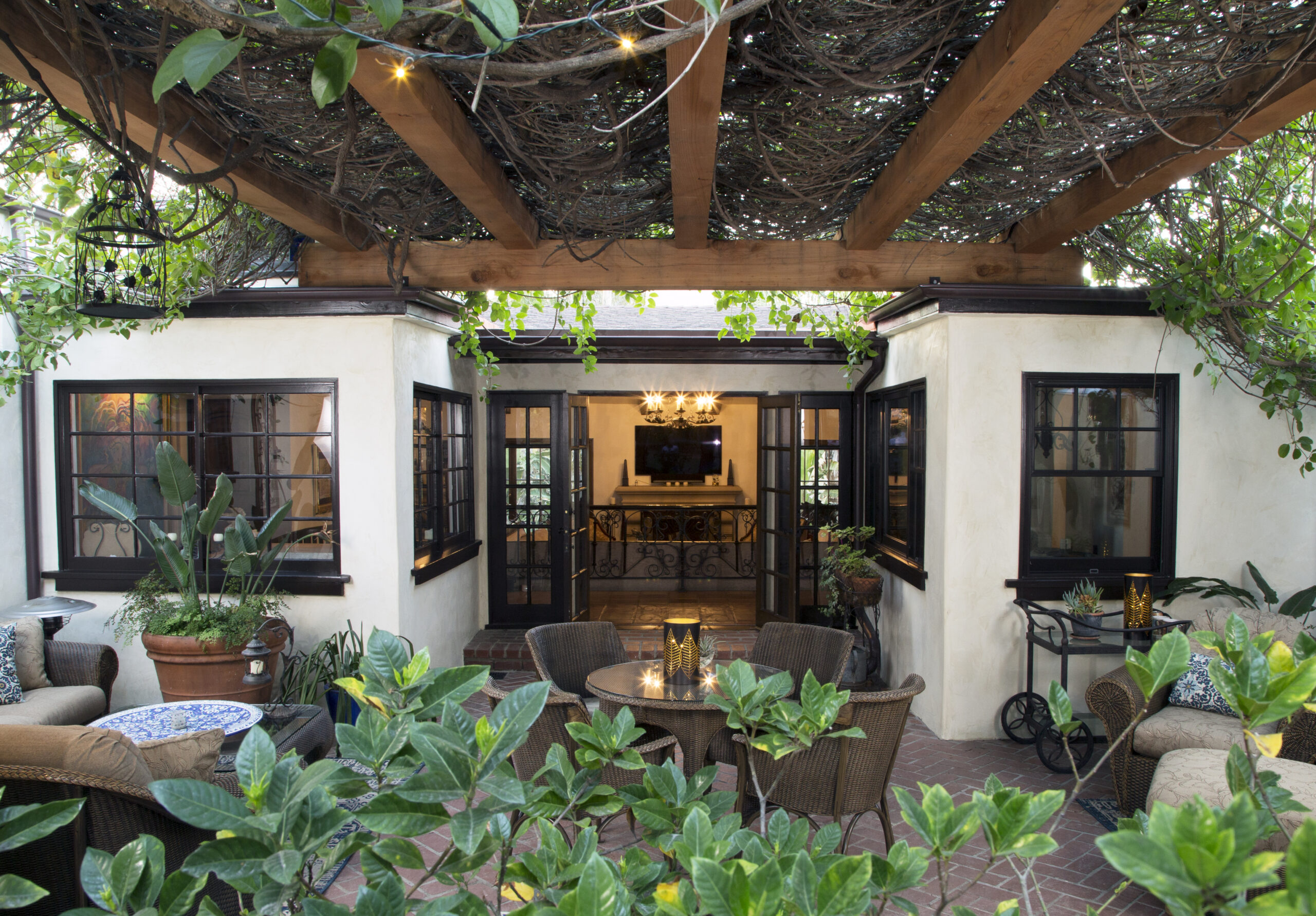 Harvested sustainably in FSC-certified forests, Humboldt’s redwood timbers bring natural strength and warmth to outdoor structures. Ideal for everything from exposed beams to elegant cladding, its rich tones and inherent durability make it a highly versatile choice for all exteriors. Redwood’s natural resistance to decay and pests further underscores its enduring appeal for both architects and homeowners.
Harvested sustainably in FSC-certified forests, Humboldt’s redwood timbers bring natural strength and warmth to outdoor structures. Ideal for everything from exposed beams to elegant cladding, its rich tones and inherent durability make it a highly versatile choice for all exteriors. Redwood’s natural resistance to decay and pests further underscores its enduring appeal for both architects and homeowners.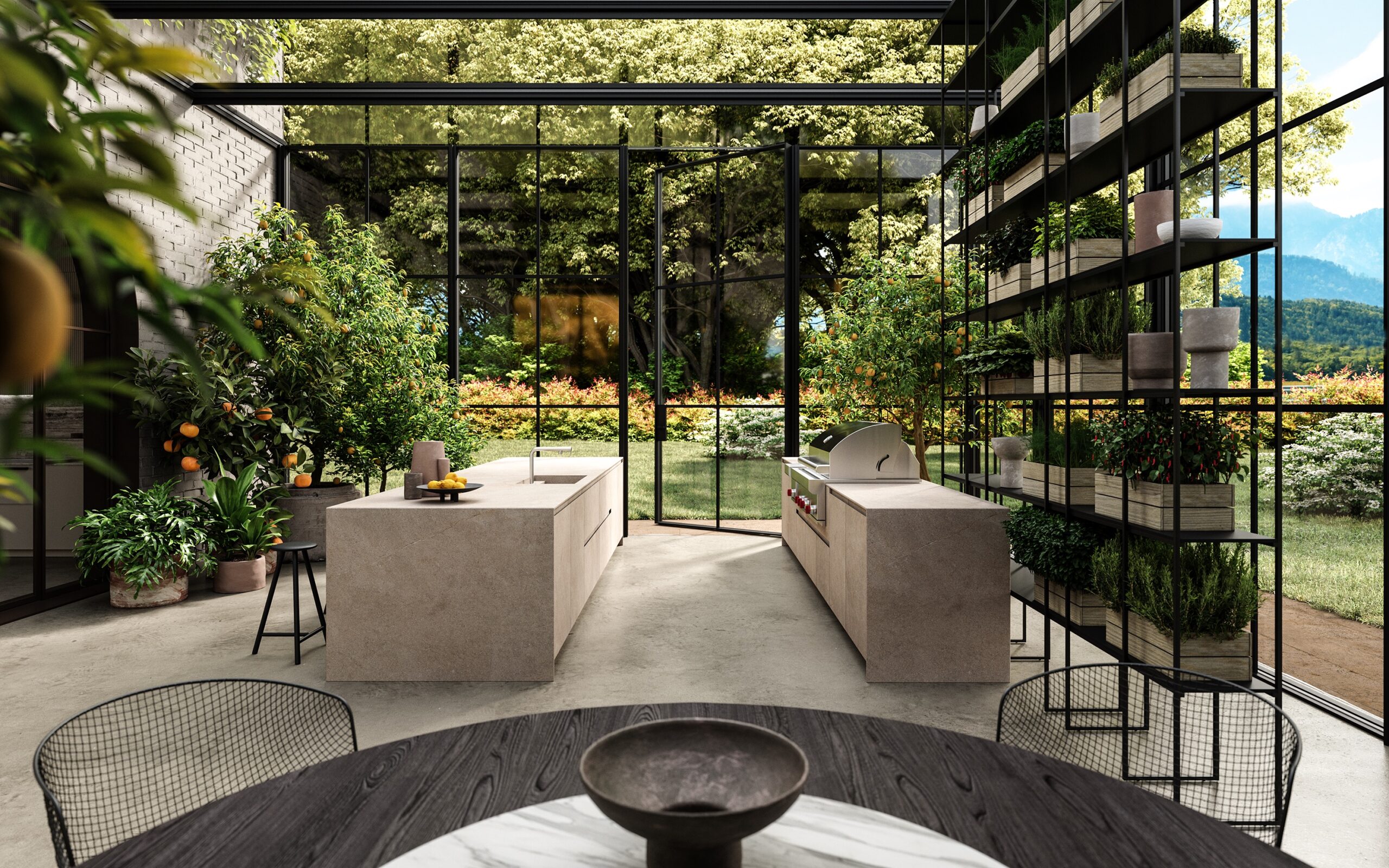 Outdoor kitchens seldom reach the craftsmanship of a product like Vitae, where natural stone and timber meet modular precision. Designed to adapt seamlessly to indoor or outdoor spaces, the kitchen embodies versatility with striking materials that turn a functional cooking area into a truly unique design statement.
Outdoor kitchens seldom reach the craftsmanship of a product like Vitae, where natural stone and timber meet modular precision. Designed to adapt seamlessly to indoor or outdoor spaces, the kitchen embodies versatility with striking materials that turn a functional cooking area into a truly unique design statement.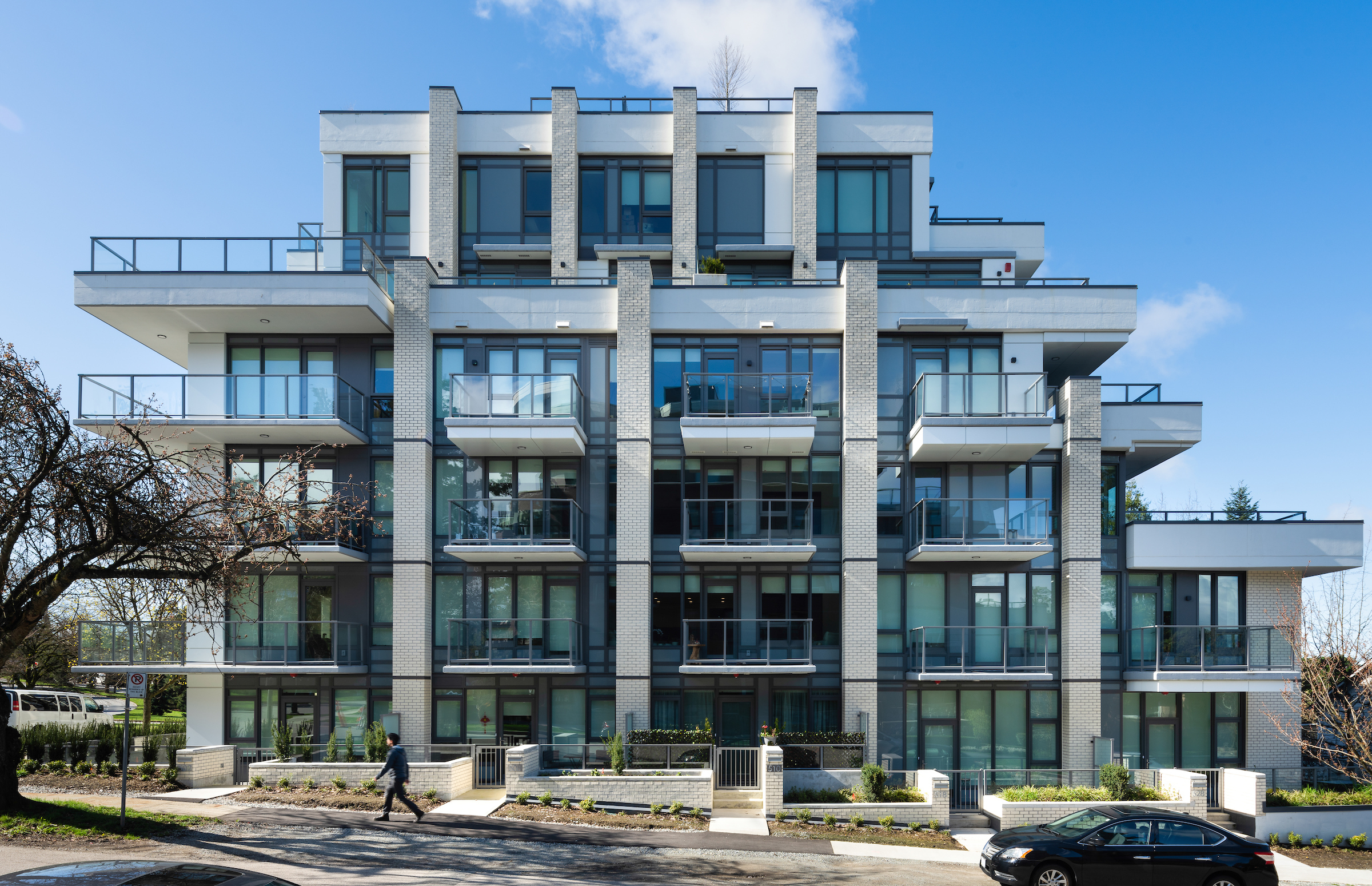 Combining expansive glazing with top-tier thermal performance, the Universal Series™ Window Wall creates striking façades that improve energy efficiency. Its fiberglass frame, customizable to project specifications, offers a perfect balance of form and function.
Combining expansive glazing with top-tier thermal performance, the Universal Series™ Window Wall creates striking façades that improve energy efficiency. Its fiberglass frame, customizable to project specifications, offers a perfect balance of form and function.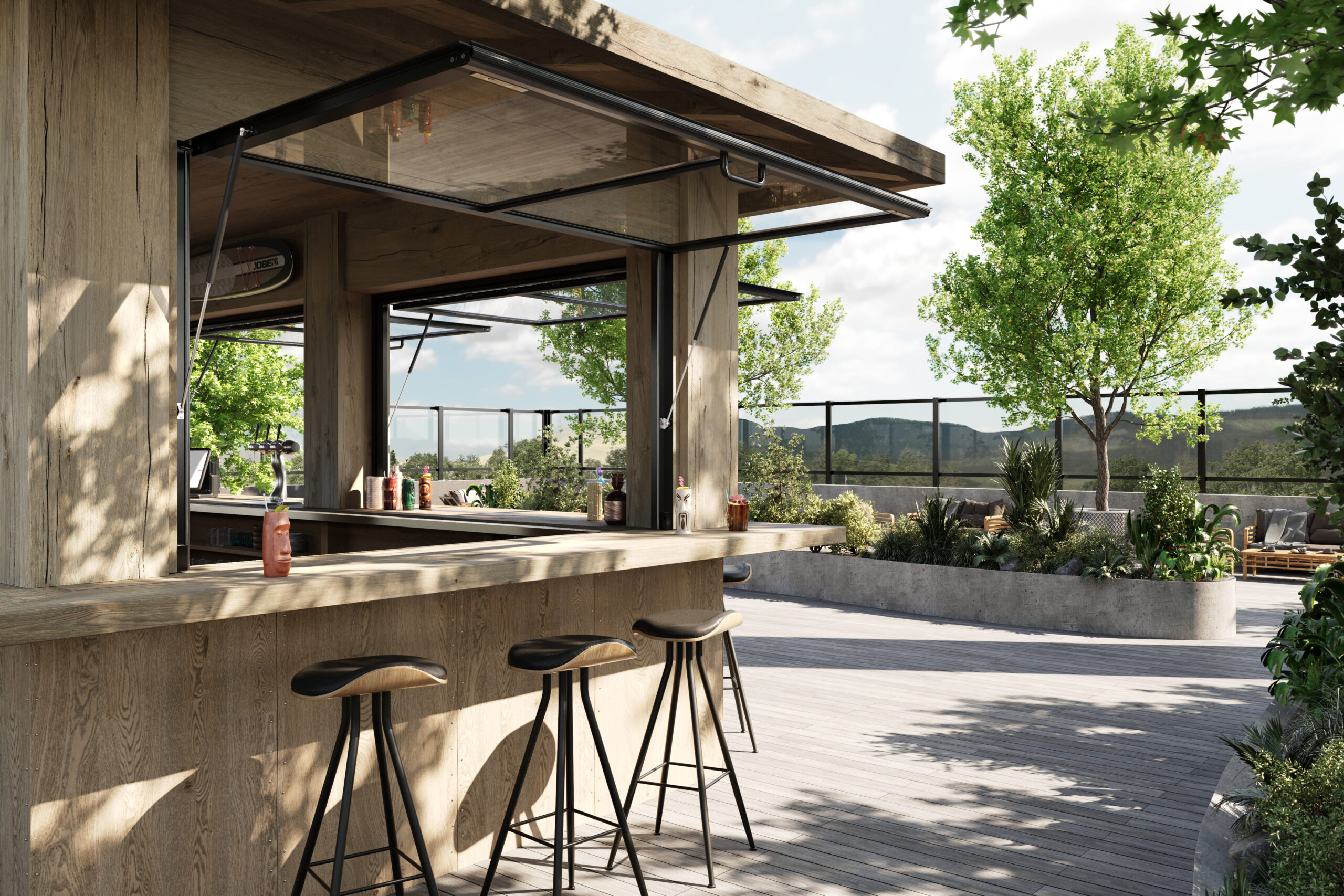 Evo-Flex transforms exterior spaces with its gas strut window system, which is ideal for pass-through bar tops and outdoor kitchens. Its sleek, self-lifting aluminum frame is designed for immense durability and ease of use, creating seamless transitions between indoor and outdoor living areas.
Evo-Flex transforms exterior spaces with its gas strut window system, which is ideal for pass-through bar tops and outdoor kitchens. Its sleek, self-lifting aluminum frame is designed for immense durability and ease of use, creating seamless transitions between indoor and outdoor living areas.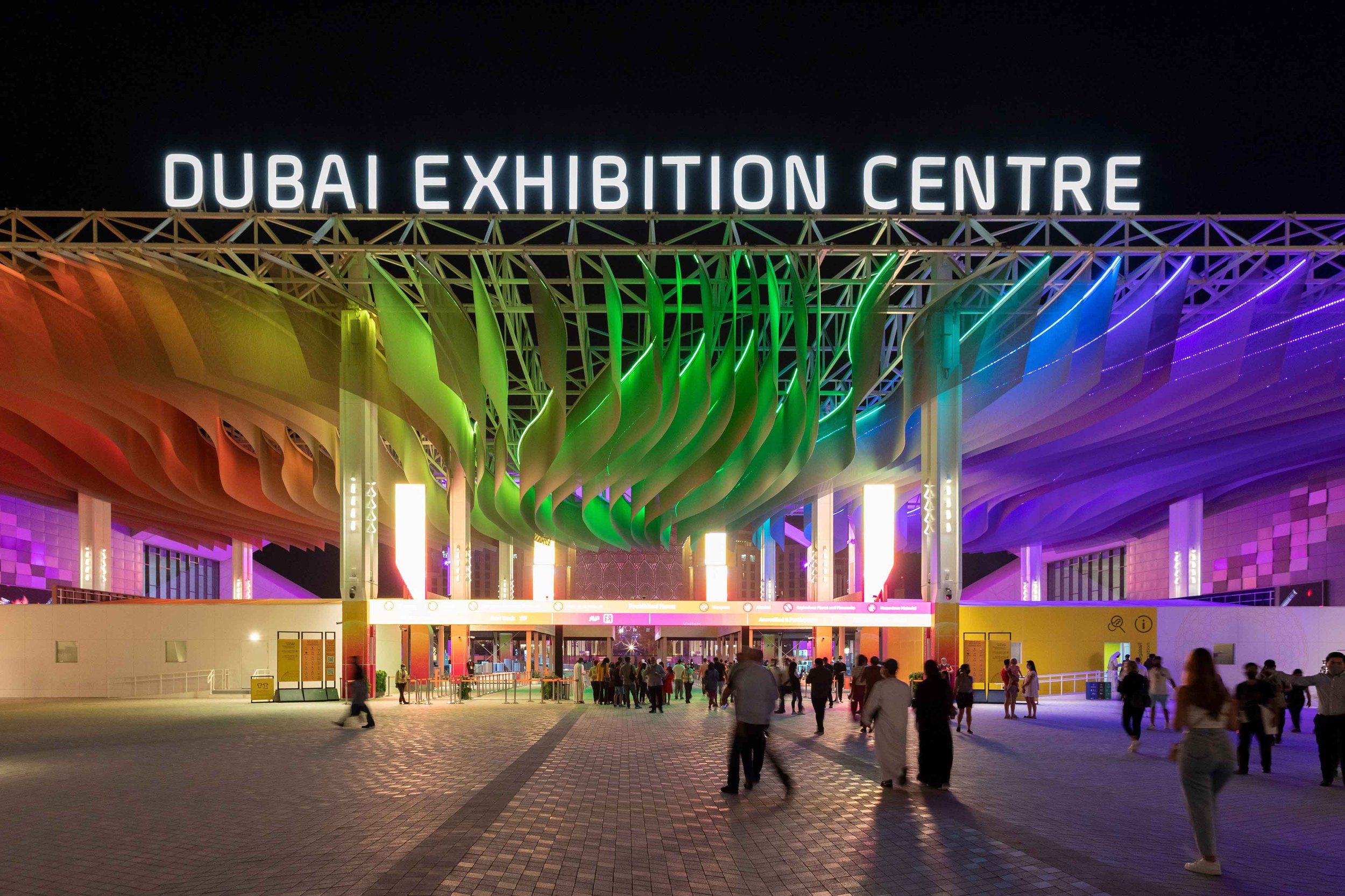 This 3D mesh offers an innovative approach to shading and façades, crafted from bio-based polymers that reduce carbon footprints by 80%. With its ability to provide solar reduction and airflow, RE/8 combines functionality with sustainability, making it an essential choice for environmentally conscious design.
This 3D mesh offers an innovative approach to shading and façades, crafted from bio-based polymers that reduce carbon footprints by 80%. With its ability to provide solar reduction and airflow, RE/8 combines functionality with sustainability, making it an essential choice for environmentally conscious design.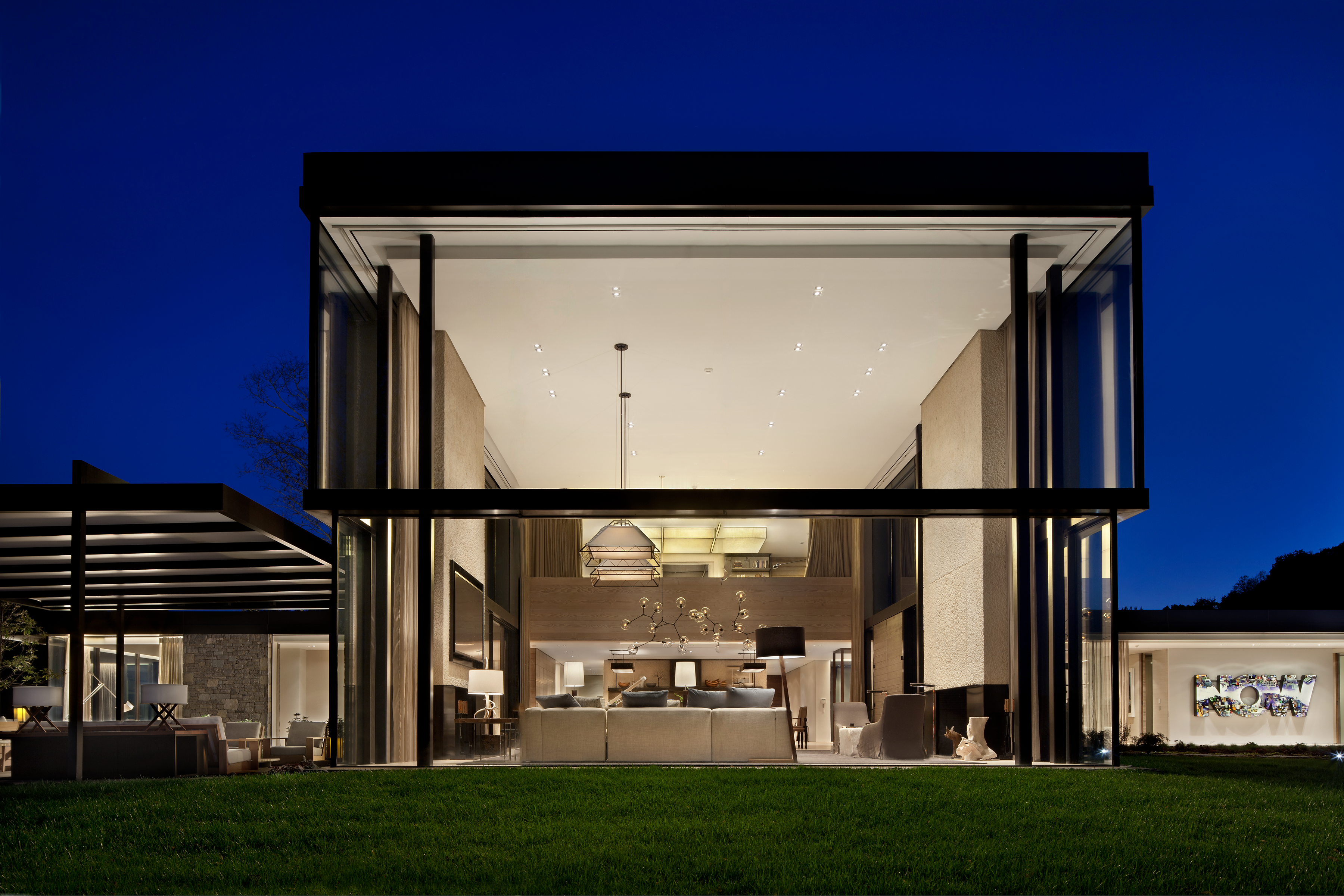 VetraSpan-L delivers 50-foot spans of uninterrupted glass, creating exteriors with unparalleled transparency. Its advanced structural system eliminates vertical joints, providing a seamless connection to the surrounding landscape and elevating modern façade design to new heights.
VetraSpan-L delivers 50-foot spans of uninterrupted glass, creating exteriors with unparalleled transparency. Its advanced structural system eliminates vertical joints, providing a seamless connection to the surrounding landscape and elevating modern façade design to new heights.
 What sets the MSI Titan 18 apart in the premium laptop category is its exceptional upgradability. Designed with future-proofing in mind, it supports up to 192GB of DDR5 RAM and additional PCIe Gen 5 storage, giving architects the flexibility to scale their hardware as project demands grow. This makes the Titan 18 not just a high-end laptop, but an investment in long-term performance.
What sets the MSI Titan 18 apart in the premium laptop category is its exceptional upgradability. Designed with future-proofing in mind, it supports up to 192GB of DDR5 RAM and additional PCIe Gen 5 storage, giving architects the flexibility to scale their hardware as project demands grow. This makes the Titan 18 not just a high-end laptop, but an investment in long-term performance. The Lenovo Legion Pro 7i is a premium choice for architects needing professional-grade performance with a focus on raw power. Equipped with an Intel i9-14900HX processor and NVIDIA RTX 4080 GPU, it excels in demanding workflows, such as rendering, 3D modeling and BIM applications, making it a reliable powerhouse for intensive architectural tasks.
The Lenovo Legion Pro 7i is a premium choice for architects needing professional-grade performance with a focus on raw power. Equipped with an Intel i9-14900HX processor and NVIDIA RTX 4080 GPU, it excels in demanding workflows, such as rendering, 3D modeling and BIM applications, making it a reliable powerhouse for intensive architectural tasks. For architects who prioritize a vast, detailed display, the Alienware M18 R2 sets a new standard. Its 18-inch QHD+ screen offers 2560 x 1600 resolution and a 165Hz refresh rate, making it ideal for reviewing detailed drawings, refining renderings or multi-tasking across software windows without any issue.
For architects who prioritize a vast, detailed display, the Alienware M18 R2 sets a new standard. Its 18-inch QHD+ screen offers 2560 x 1600 resolution and a 165Hz refresh rate, making it ideal for reviewing detailed drawings, refining renderings or multi-tasking across software windows without any issue. The Razer Blade 16 stands out among high-end gaming laptops for its balance of power and efficiency, delivering top-tier performance in a more streamlined form. Powered by a 14th Gen Intel Core i9-14900HX processor and NVIDIA RTX 4080 GPU, it’s built to handle demanding tasks like 3D modeling, rendering and complex simulations with precision and speed.
The Razer Blade 16 stands out among high-end gaming laptops for its balance of power and efficiency, delivering top-tier performance in a more streamlined form. Powered by a 14th Gen Intel Core i9-14900HX processor and NVIDIA RTX 4080 GPU, it’s built to handle demanding tasks like 3D modeling, rendering and complex simulations with precision and speed. The ASUS Zephyrus G14 is a great choice for architects seeking both high-end performance and a portable, lightweight design. Powered by the AMD Ryzen 9 8945HS processor and NVIDIA RTX 4070 GPU, it delivers exceptional speed and graphical capability, perfect for 3D modeling, rendering and multitasking in software like Revit, SketchUp or Rhino.
The ASUS Zephyrus G14 is a great choice for architects seeking both high-end performance and a portable, lightweight design. Powered by the AMD Ryzen 9 8945HS processor and NVIDIA RTX 4070 GPU, it delivers exceptional speed and graphical capability, perfect for 3D modeling, rendering and multitasking in software like Revit, SketchUp or Rhino. The Lenovo Legion Pro 5i is a Lenovo Legion model likely to appeal to a broader range of architects, both price-wise and performance-wise. Powered by a 14th Gen Intel Core i9-14900HX processor and NVIDIA GeForce RTX 4070 GPU, it delivers reliable capabilities for 3D modeling, rendering and BIM workflows.
The Lenovo Legion Pro 5i is a Lenovo Legion model likely to appeal to a broader range of architects, both price-wise and performance-wise. Powered by a 14th Gen Intel Core i9-14900HX processor and NVIDIA GeForce RTX 4070 GPU, it delivers reliable capabilities for 3D modeling, rendering and BIM workflows. For architects who value reliability and professional-grade performance over gaming features, the Lenovo ThinkPad P1 Gen 6 is a standout choice. Designed with professionals in mind, this workstation is equipped to handle intensive tasks like CAD modeling, rendering and large-scale BIM workflows efficiently.
For architects who value reliability and professional-grade performance over gaming features, the Lenovo ThinkPad P1 Gen 6 is a standout choice. Designed with professionals in mind, this workstation is equipped to handle intensive tasks like CAD modeling, rendering and large-scale BIM workflows efficiently. From the same series as the Zephyrus G14, the ASUS Zephyrus G16 offers a larger 16-inch OLED display, providing more screen real estate for architects who need precision and clarity for their designs. Its WQXGA 240Hz display is perfect for reviewing detailed drawings, rendering complex 3D models and managing large-scale projects with sharp visuals and excellent color fidelity.
From the same series as the Zephyrus G14, the ASUS Zephyrus G16 offers a larger 16-inch OLED display, providing more screen real estate for architects who need precision and clarity for their designs. Its WQXGA 240Hz display is perfect for reviewing detailed drawings, rendering complex 3D models and managing large-scale projects with sharp visuals and excellent color fidelity.
 The Dell Precision 7680 stands apart as a workstation rather than a gaming laptop, catering specifically to architects who rely on professional-grade hardware for demanding workflows. Designed with stability and precision in mind, it’s a reliable choice for running applications like AutoCAD, Revit and Rhino that benefit from certified hardware and consistent performance.
The Dell Precision 7680 stands apart as a workstation rather than a gaming laptop, catering specifically to architects who rely on professional-grade hardware for demanding workflows. Designed with stability and precision in mind, it’s a reliable choice for running applications like AutoCAD, Revit and Rhino that benefit from certified hardware and consistent performance. The Dell G16 strikes a balance between affordability and performance, making it an excellent choice for architects who need a capable workstation without the premium price tag. Powered by the 13th Gen Intel Core i9-13900HX processor and NVIDIA GeForce RTX 4070 GPU, it delivers solid performance for 3D modeling, rendering and architectural simulations in tools like Revit and Rhino.
The Dell G16 strikes a balance between affordability and performance, making it an excellent choice for architects who need a capable workstation without the premium price tag. Powered by the 13th Gen Intel Core i9-13900HX processor and NVIDIA GeForce RTX 4070 GPU, it delivers solid performance for 3D modeling, rendering and architectural simulations in tools like Revit and Rhino. The HP ZBook Fury 16 G10 Mobile Workstation stands out as HP’s most powerful mobile workstation, designed for architects who require maximum performance. Its Intel Core i9 processor and NVIDIA RTX graphics deliver the computational and graphical power needed for demanding workflows, such as complex 3D modeling, rendering and large-scale BIM projects.
The HP ZBook Fury 16 G10 Mobile Workstation stands out as HP’s most powerful mobile workstation, designed for architects who require maximum performance. Its Intel Core i9 processor and NVIDIA RTX graphics deliver the computational and graphical power needed for demanding workflows, such as complex 3D modeling, rendering and large-scale BIM projects. The ASUS TUF A16 delivers exceptional value for its price, offering an AMD Ryzen 7 7735HS processor and Radeon RX 7700S GPU, making it a reliable option for architects working with 3D modeling and rendering. The 16-inch WUXGA display (1920 x 1200, 165Hz, 100% sRGB) provides sharp, accurate visuals, ideal for design work.
The ASUS TUF A16 delivers exceptional value for its price, offering an AMD Ryzen 7 7735HS processor and Radeon RX 7700S GPU, making it a reliable option for architects working with 3D modeling and rendering. The 16-inch WUXGA display (1920 x 1200, 165Hz, 100% sRGB) provides sharp, accurate visuals, ideal for design work. The Lenovo LOQ 15.6″ is a practical pick for architecture students or professionals seeking dependable performance without overspending. Its AMD Ryzen 7 7435HS processor and NVIDIA GeForce RTX 4050 GPU handle essential tasks like CAD, 3D modeling and rendering.
The Lenovo LOQ 15.6″ is a practical pick for architecture students or professionals seeking dependable performance without overspending. Its AMD Ryzen 7 7435HS processor and NVIDIA GeForce RTX 4050 GPU handle essential tasks like CAD, 3D modeling and rendering. The Acer Nitro V stands out as the most budget-friendly choice, offering respectable performance for lighter architectural tasks. With an AMD Ryzen 5 7535HS processor and NVIDIA GeForce RTX 4050 GPU, it’s capable of running tools like AutoCAD and SketchUp.
The Acer Nitro V stands out as the most budget-friendly choice, offering respectable performance for lighter architectural tasks. With an AMD Ryzen 5 7535HS processor and NVIDIA GeForce RTX 4050 GPU, it’s capable of running tools like AutoCAD and SketchUp. The HP Victus 15.6″ (2024) is a solid budget option, powered by a 13th Gen Intel Core i5-13420H processor and NVIDIA GeForce RTX 4050 GPU (6GB GDDR6). It handles essential architectural tasks, such as drafting in AutoCAD or working in SketchUp, with ease. Its 15.6-inch FHD display (144Hz) ensures smooth visuals, making it a good choice for design reviews or light rendering.
The HP Victus 15.6″ (2024) is a solid budget option, powered by a 13th Gen Intel Core i5-13420H processor and NVIDIA GeForce RTX 4050 GPU (6GB GDDR6). It handles essential architectural tasks, such as drafting in AutoCAD or working in SketchUp, with ease. Its 15.6-inch FHD display (144Hz) ensures smooth visuals, making it a good choice for design reviews or light rendering.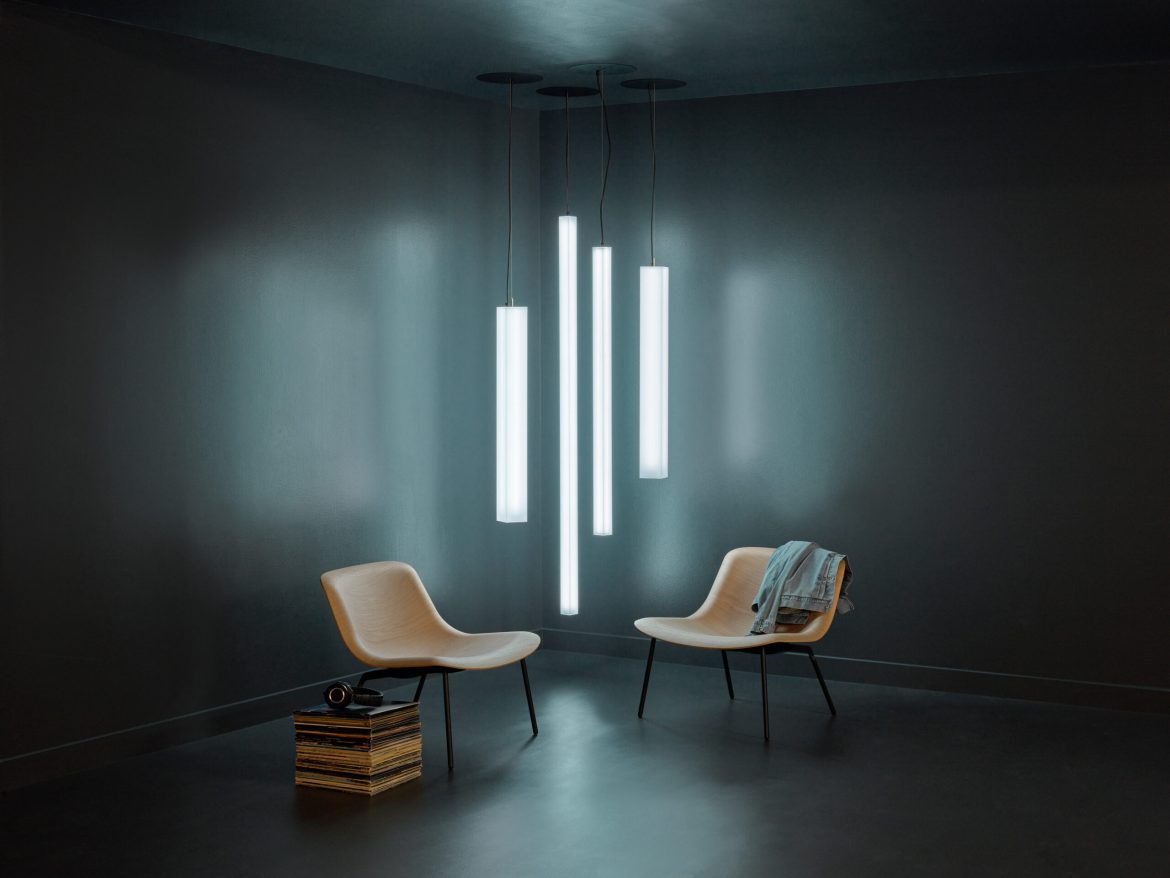
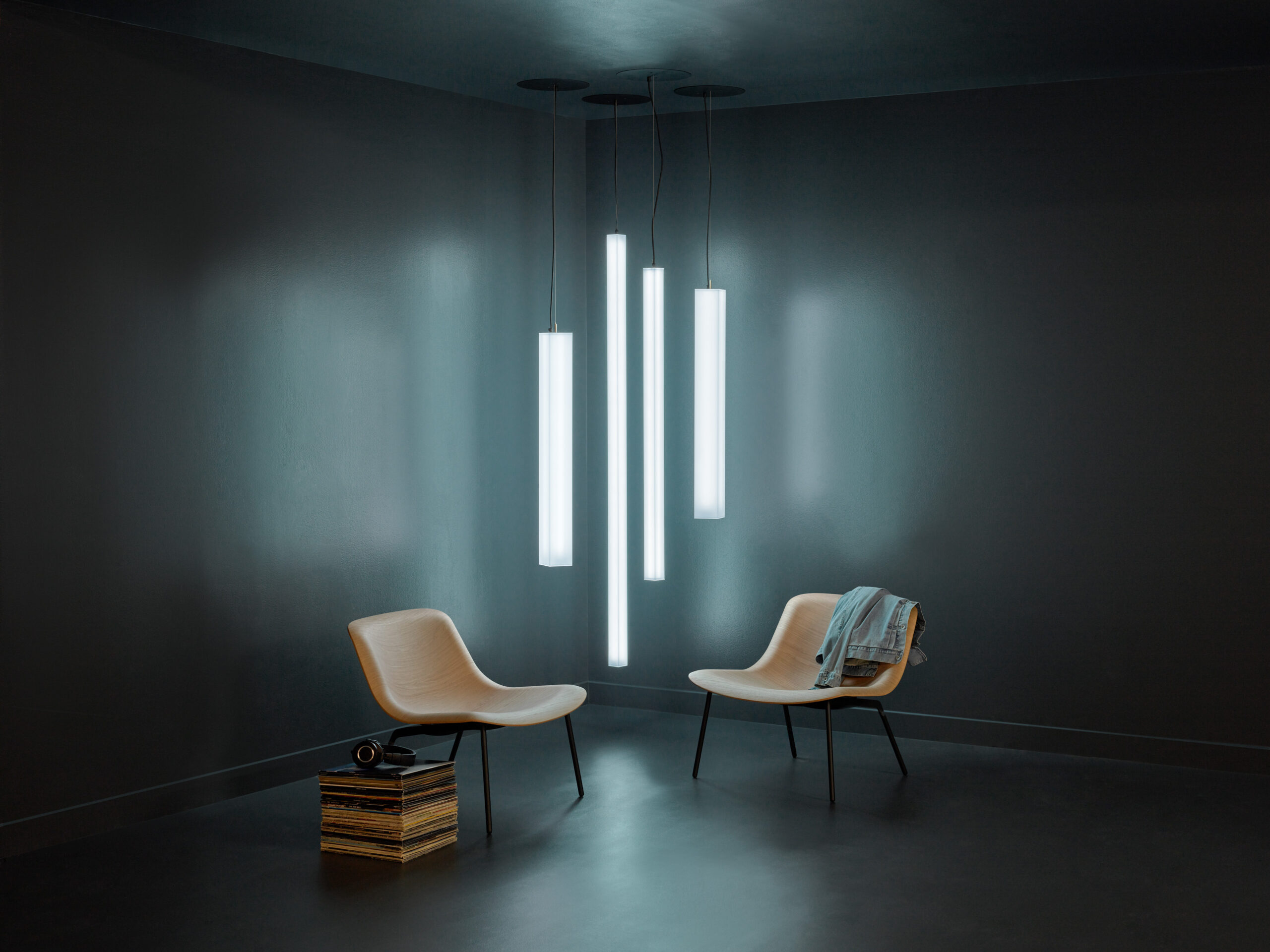
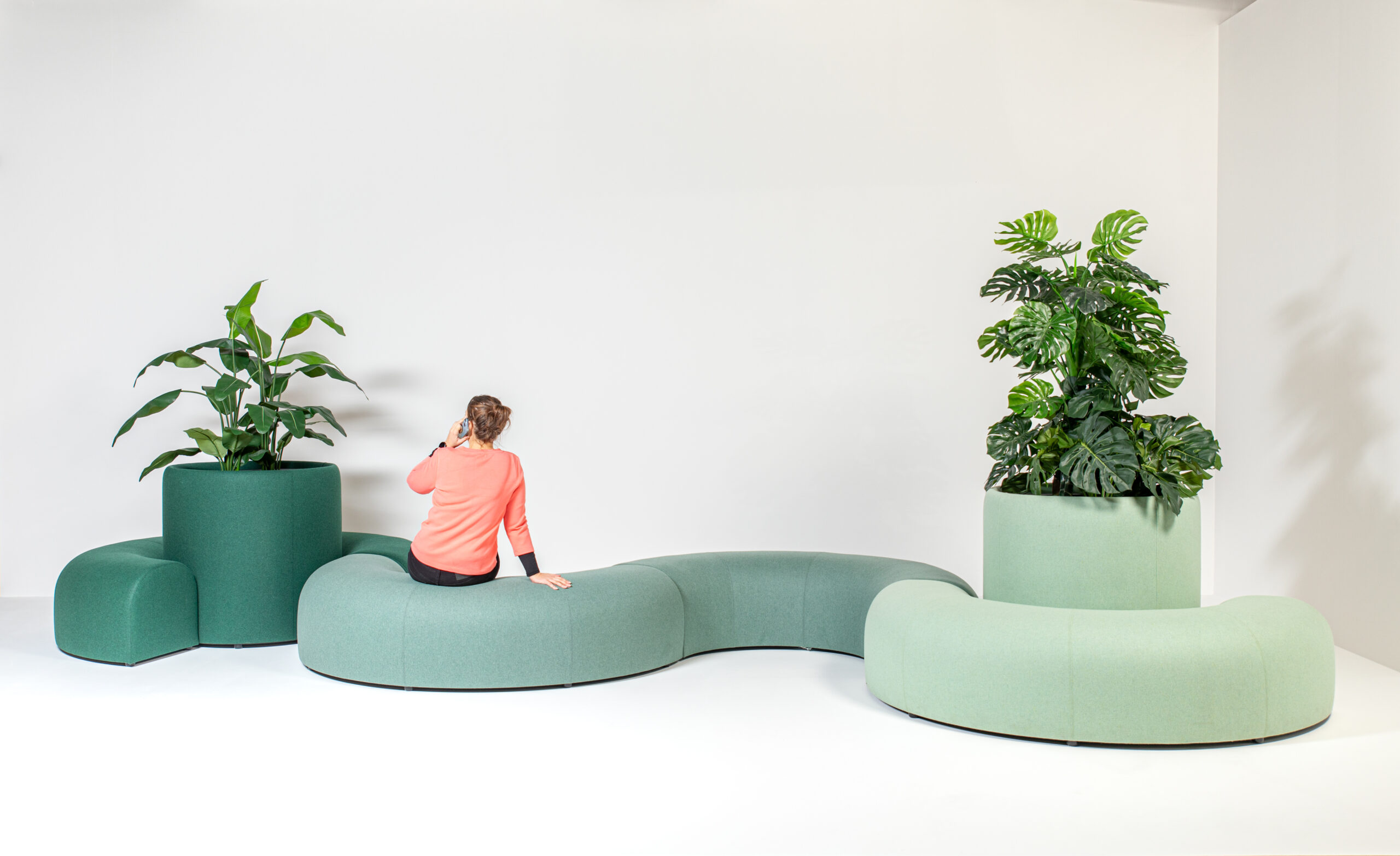
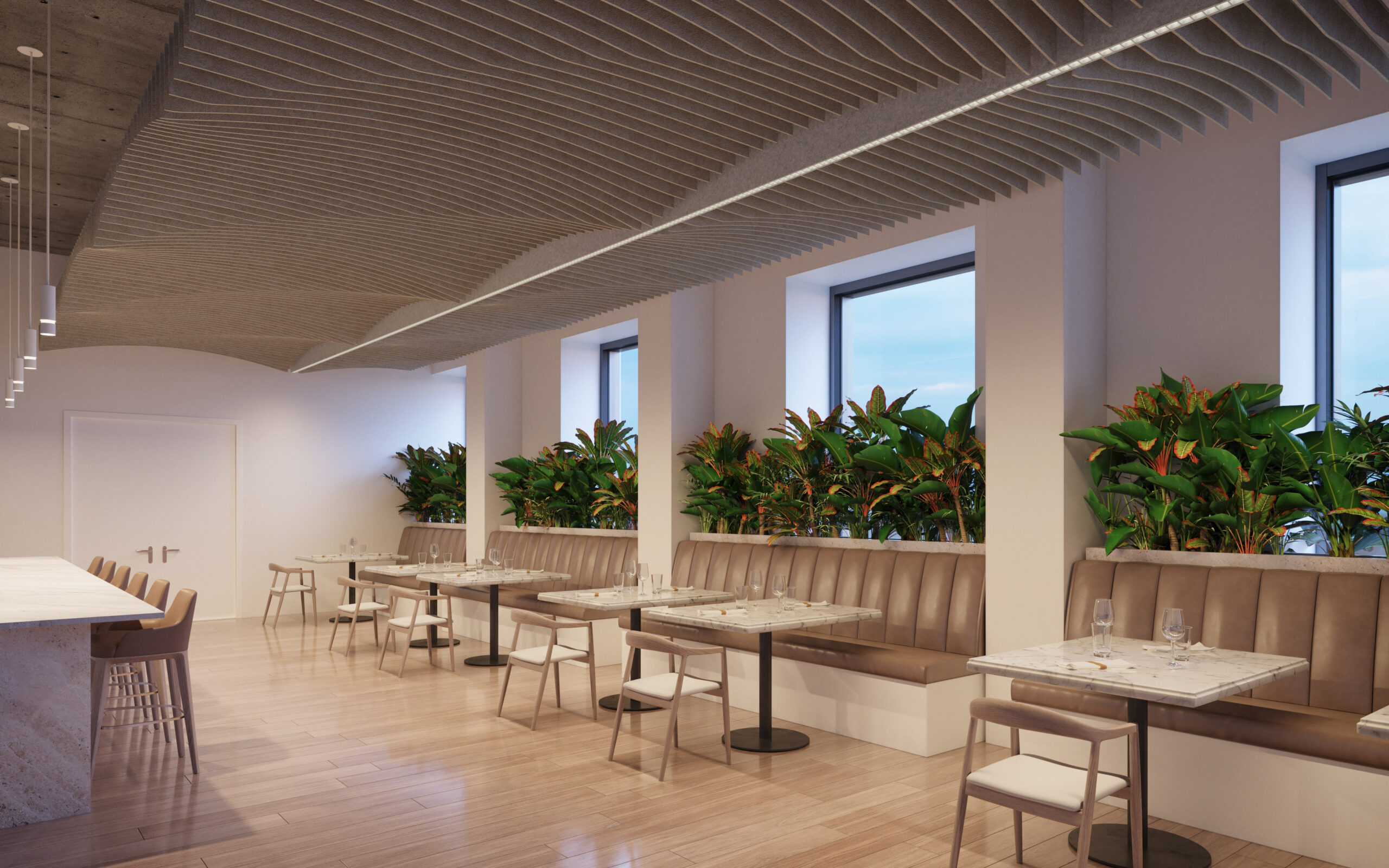
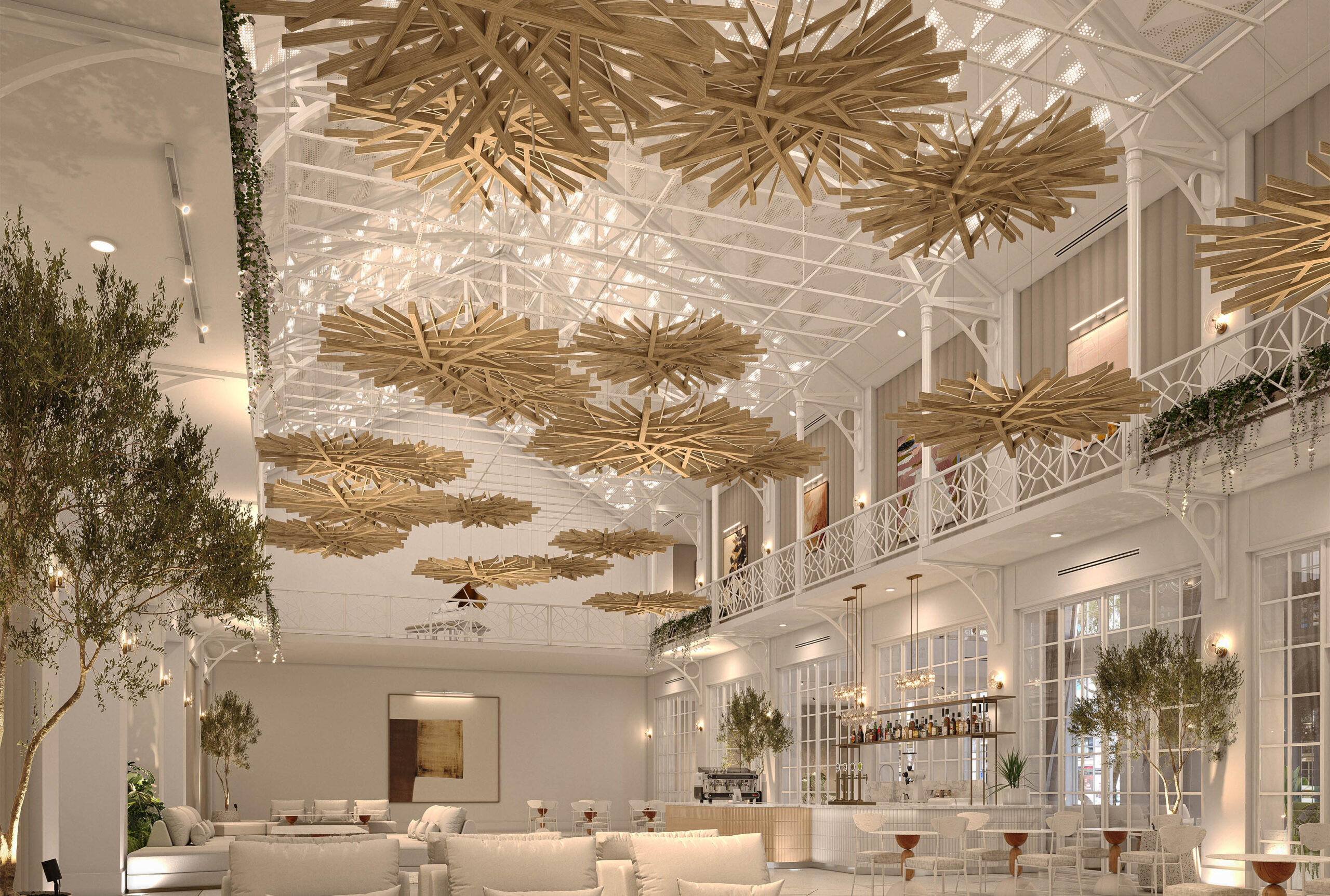
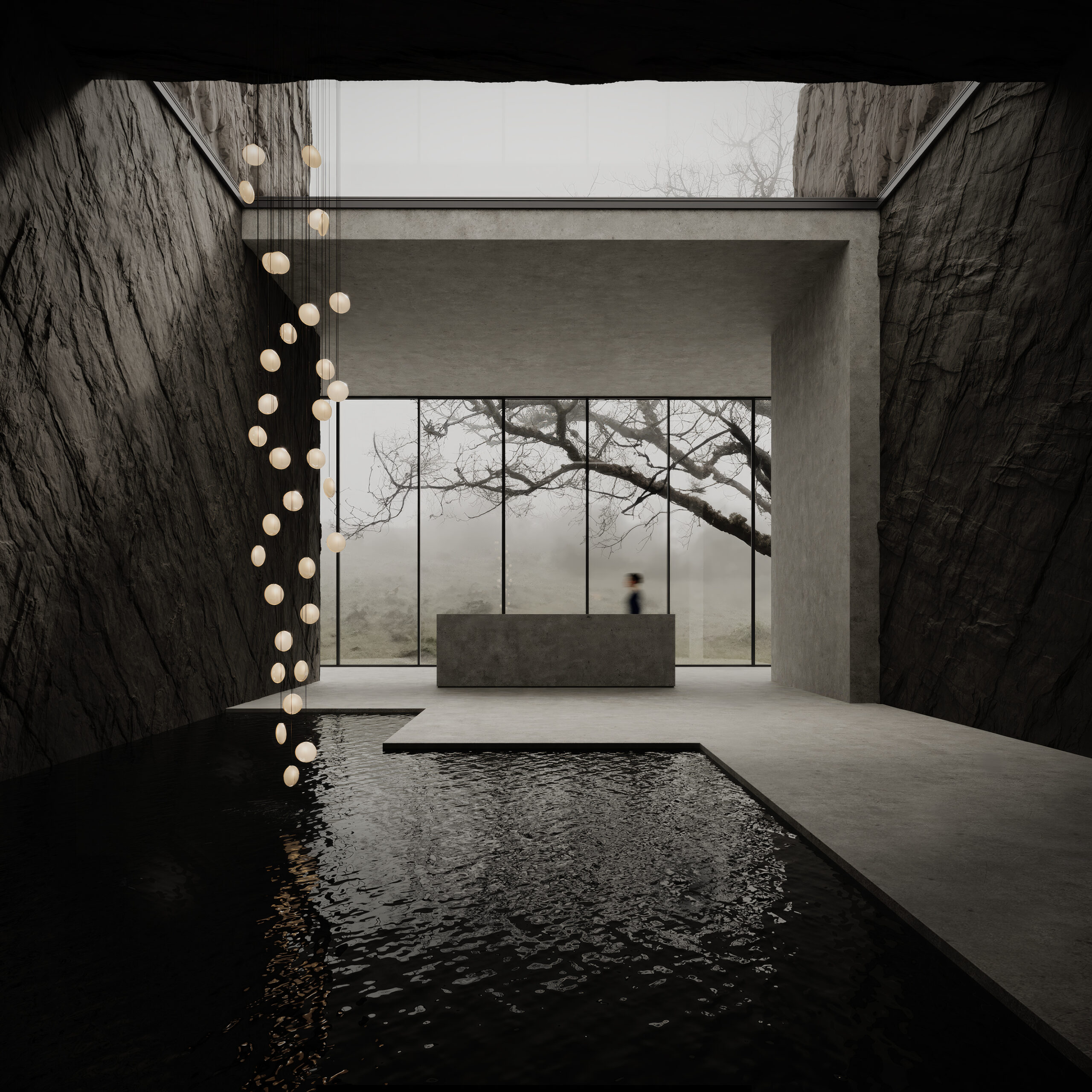
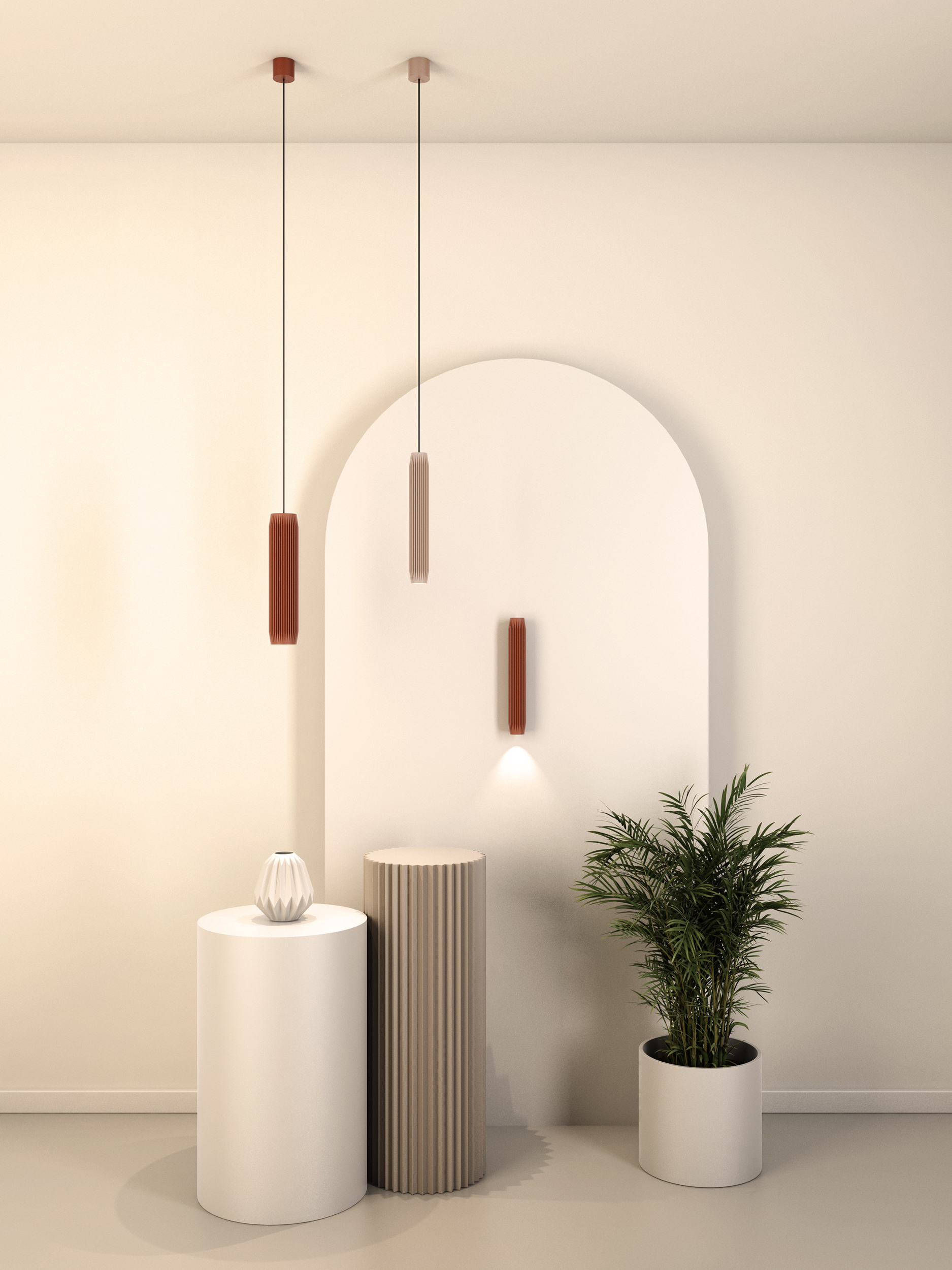
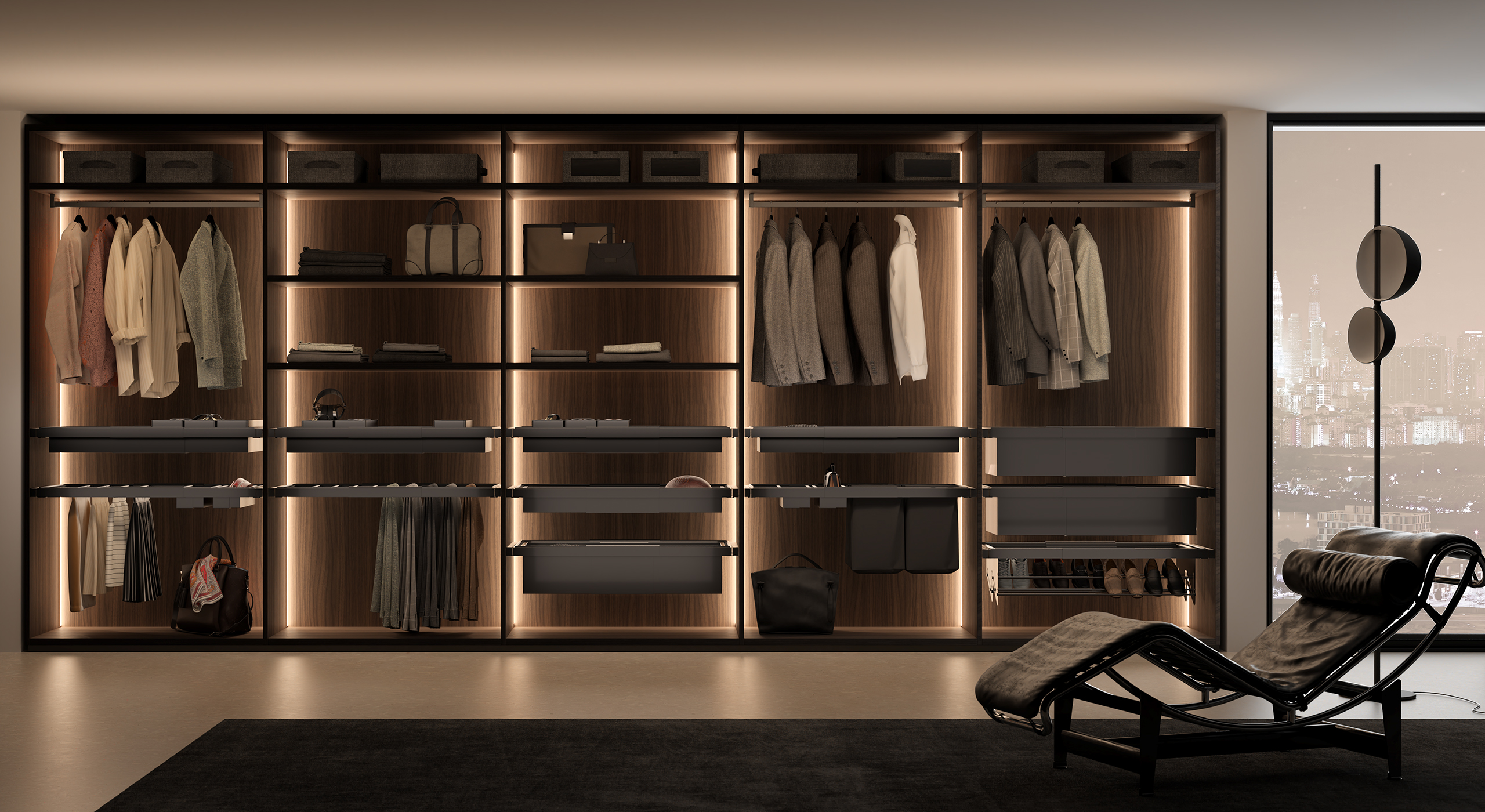
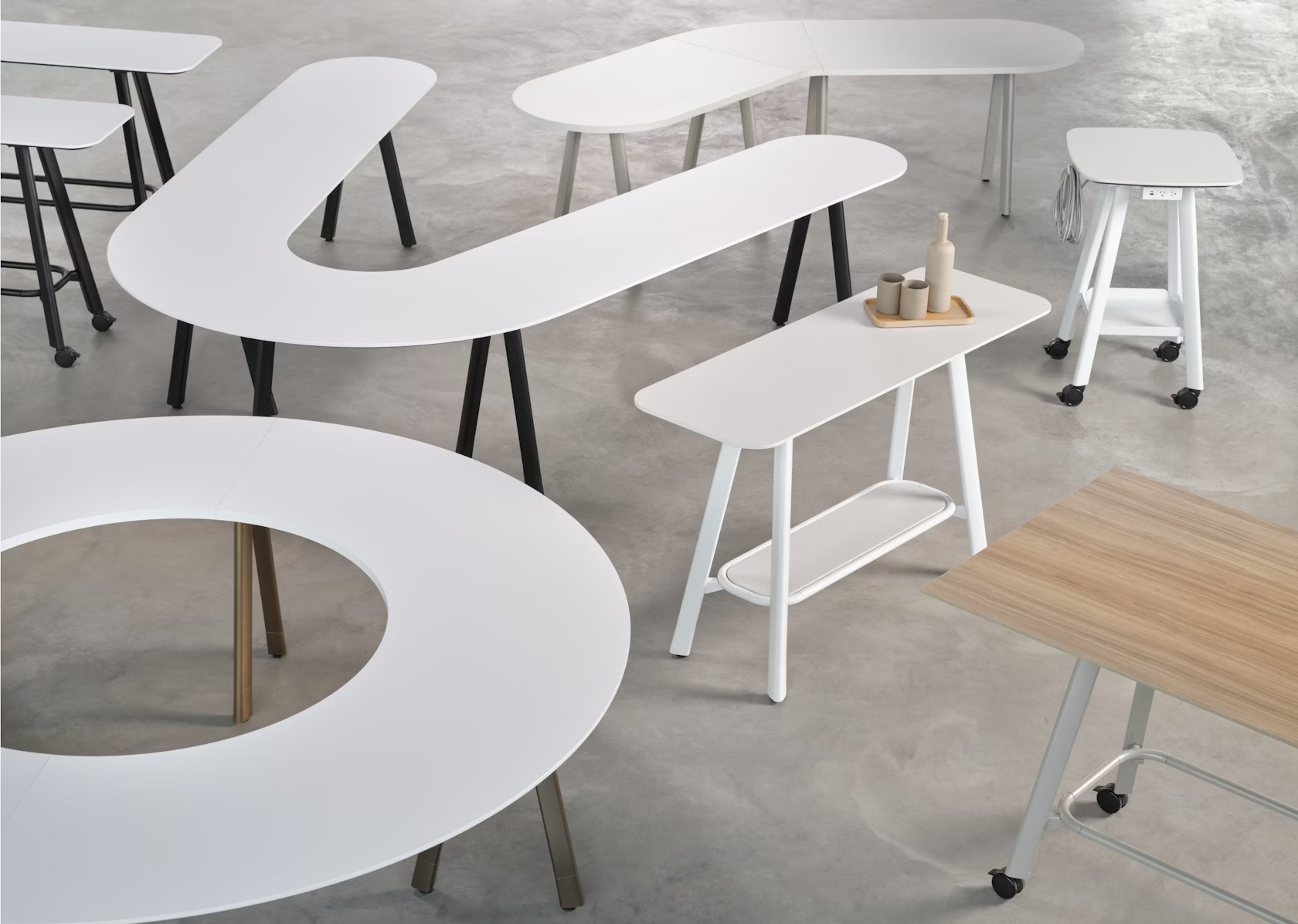
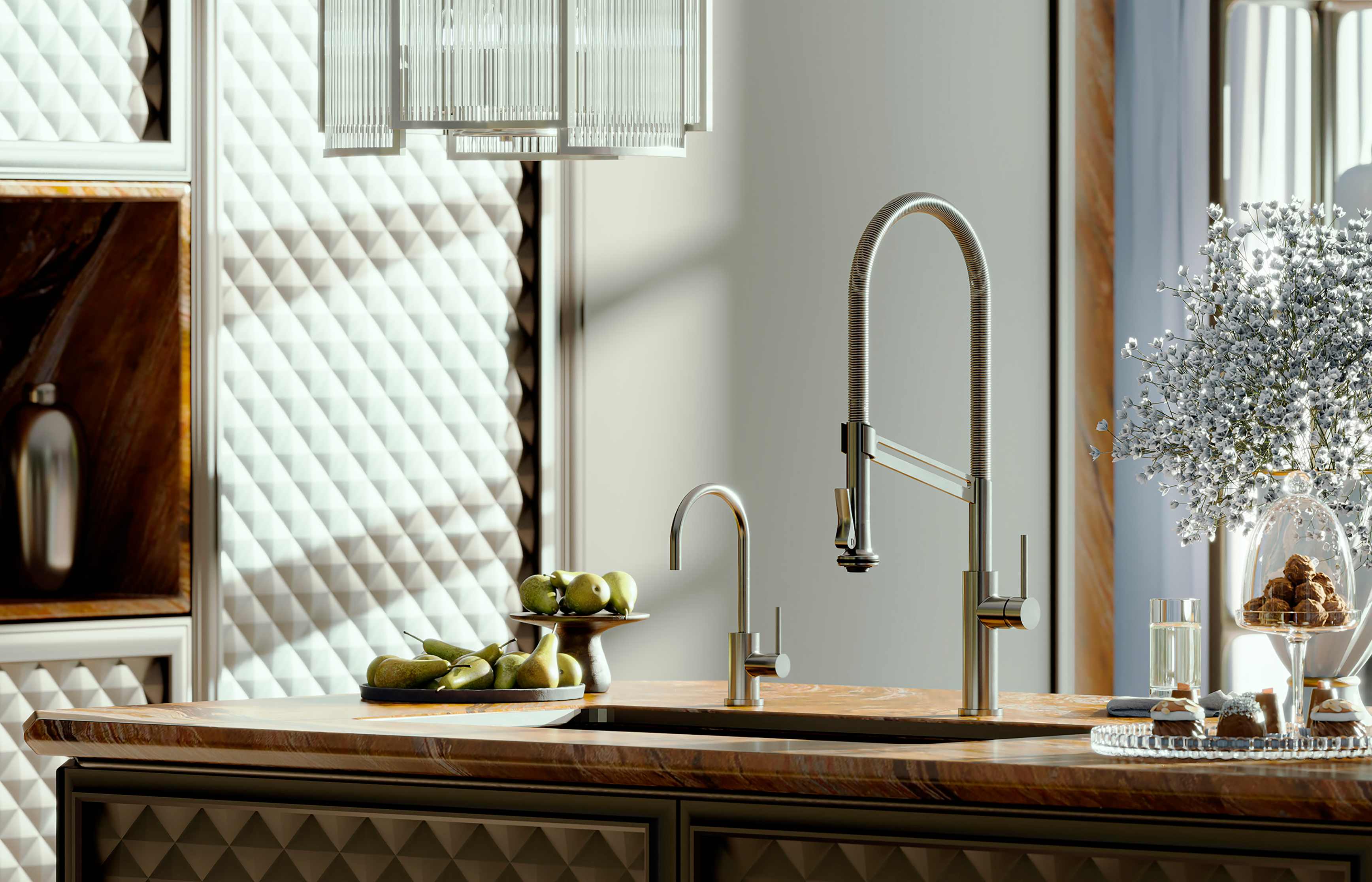
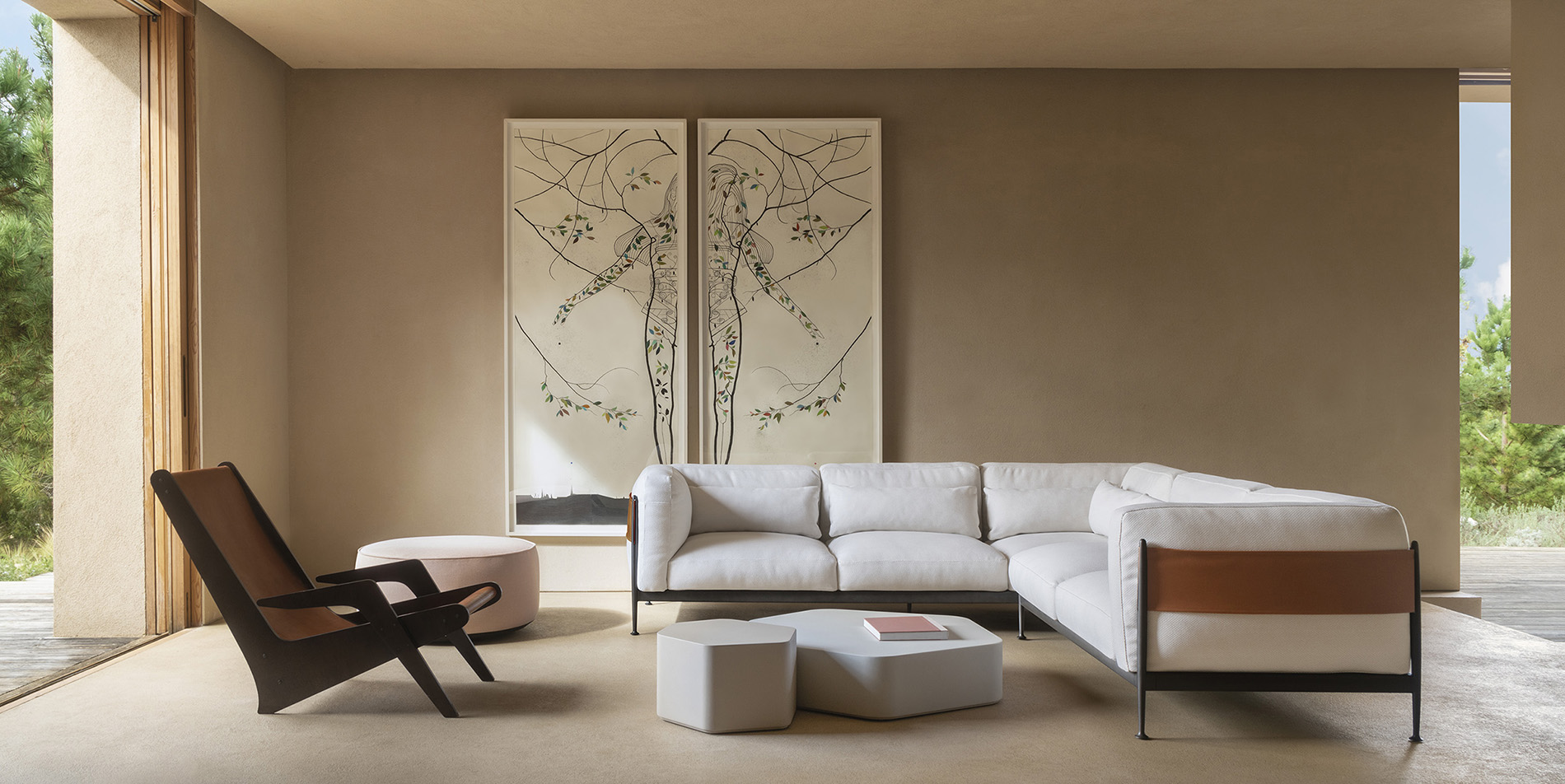

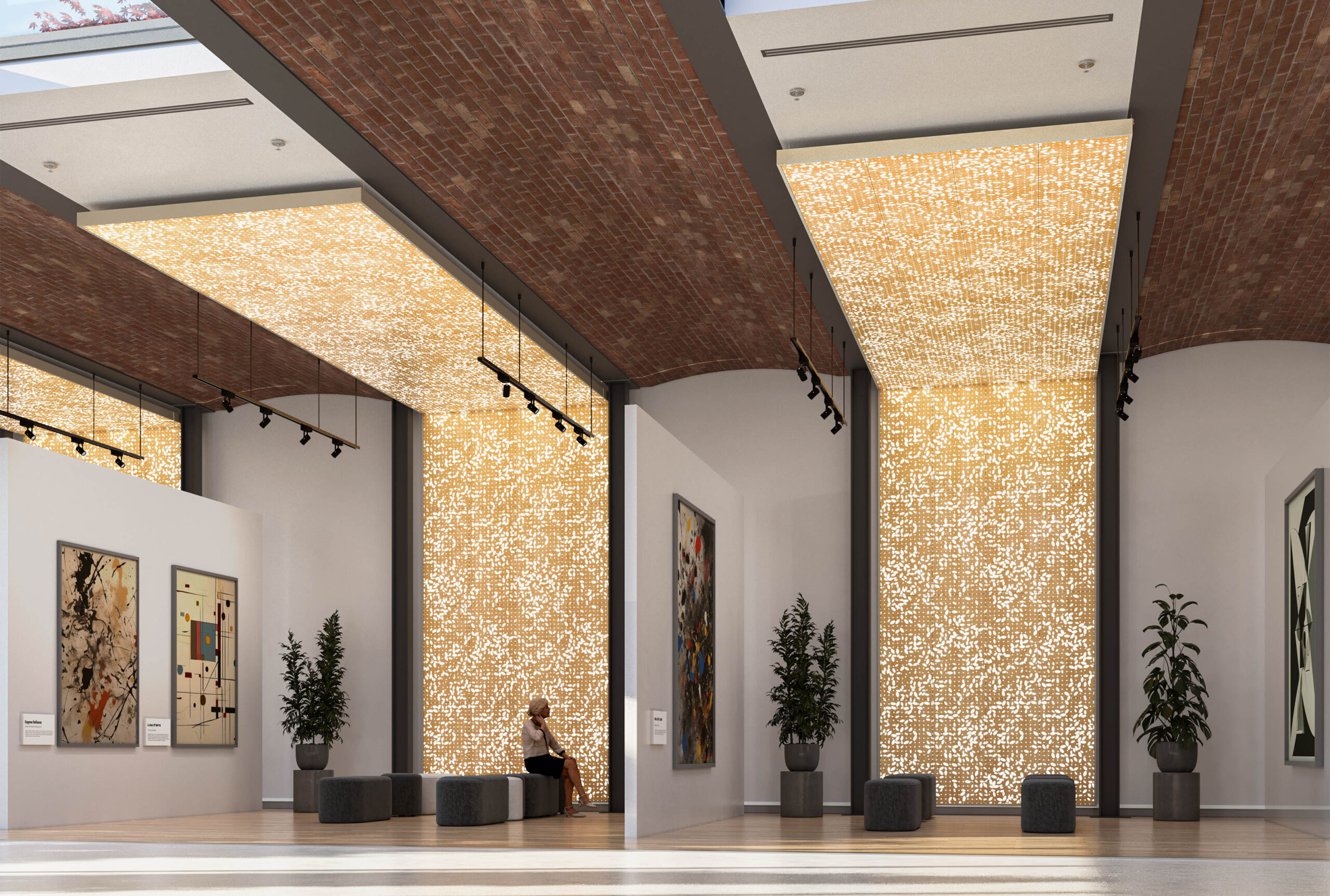
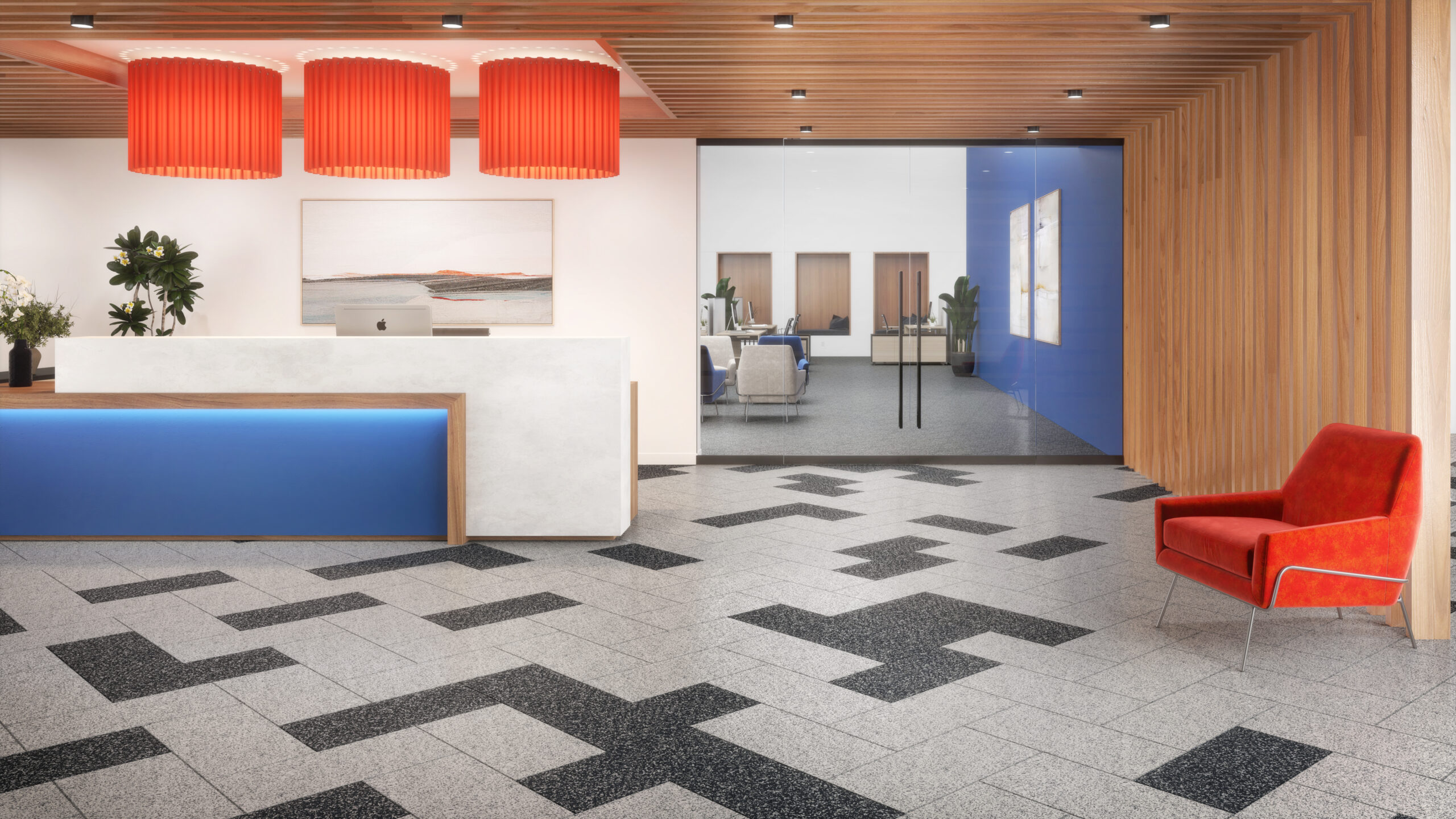
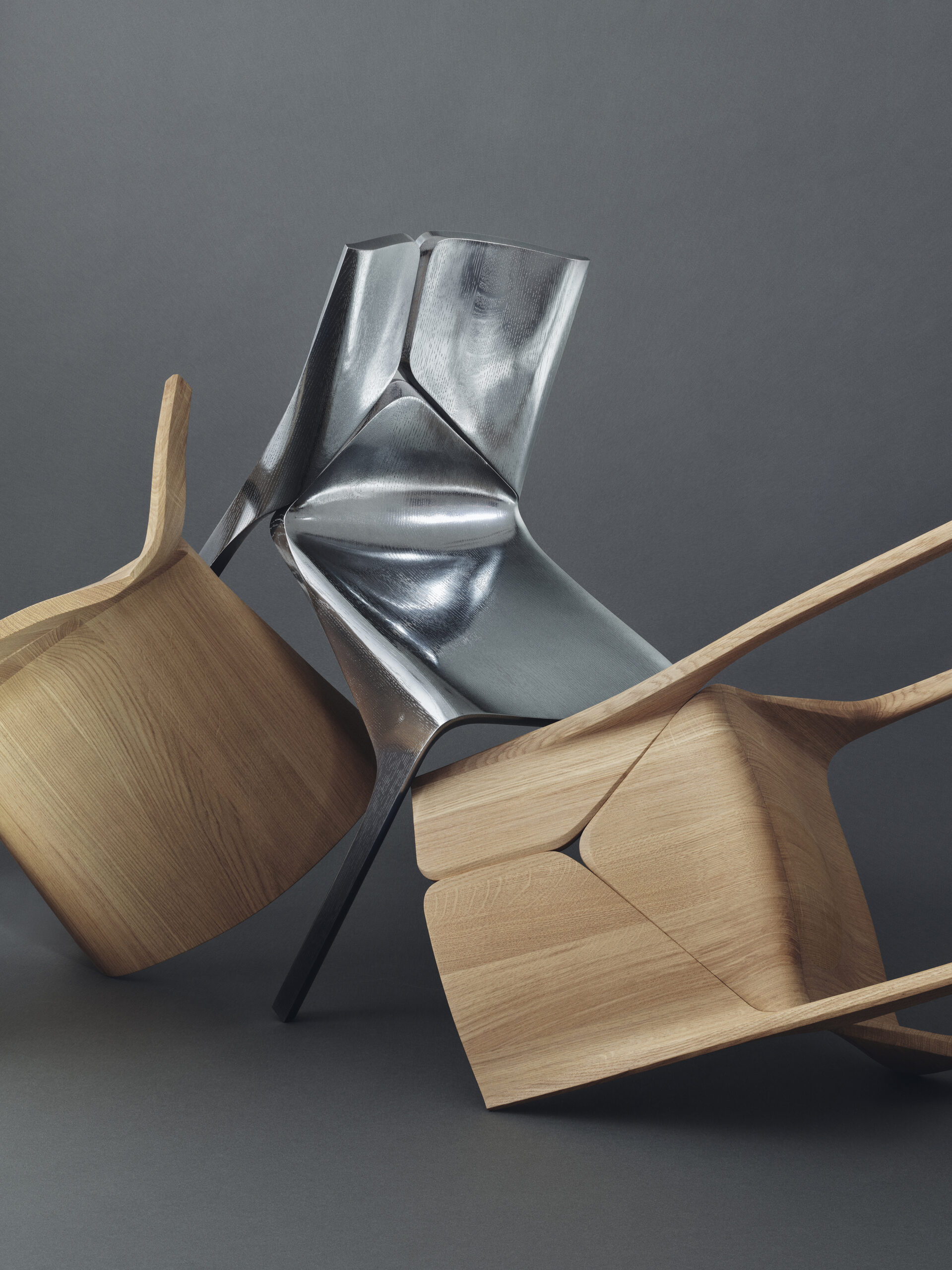

 The Garden on the Wall® Storytelling Gardens turns plants into stories and living artworks. At 105 feet long, Garden on the Wall’s most ambitious installation at Nashville International Airport connects travelers to the local landscape with layers of preserved greenery depicting rivers and bridges. Its maintenance-free design offers architects a no-compromise solution for bringing nature and culture into any urban environment, utilizing unused surfaces in a way that benefits in more than one way.
The Garden on the Wall® Storytelling Gardens turns plants into stories and living artworks. At 105 feet long, Garden on the Wall’s most ambitious installation at Nashville International Airport connects travelers to the local landscape with layers of preserved greenery depicting rivers and bridges. Its maintenance-free design offers architects a no-compromise solution for bringing nature and culture into any urban environment, utilizing unused surfaces in a way that benefits in more than one way.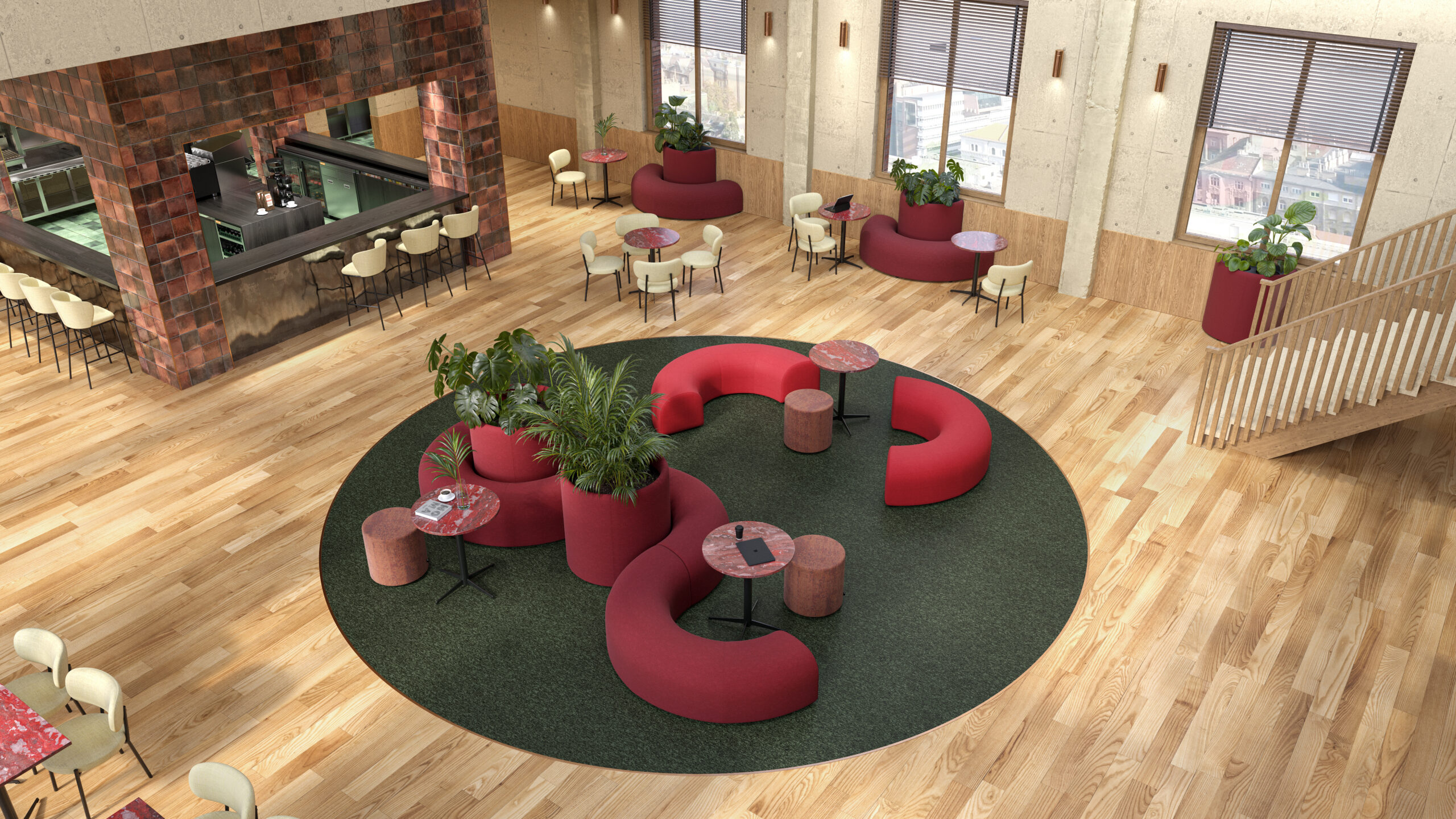 The BuzziCee acoustic seating system curves into playful forms that help to quiet communal spaces, while the BuzziPlanter integrates greenery without demanding additional floor area. Together, they solve two urban challenges: too much noise and too little nature. Made from recycled materials, the modular seating solution proves sustainability doesn’t have to come at the expense of comfort or personality.
The BuzziCee acoustic seating system curves into playful forms that help to quiet communal spaces, while the BuzziPlanter integrates greenery without demanding additional floor area. Together, they solve two urban challenges: too much noise and too little nature. Made from recycled materials, the modular seating solution proves sustainability doesn’t have to come at the expense of comfort or personality.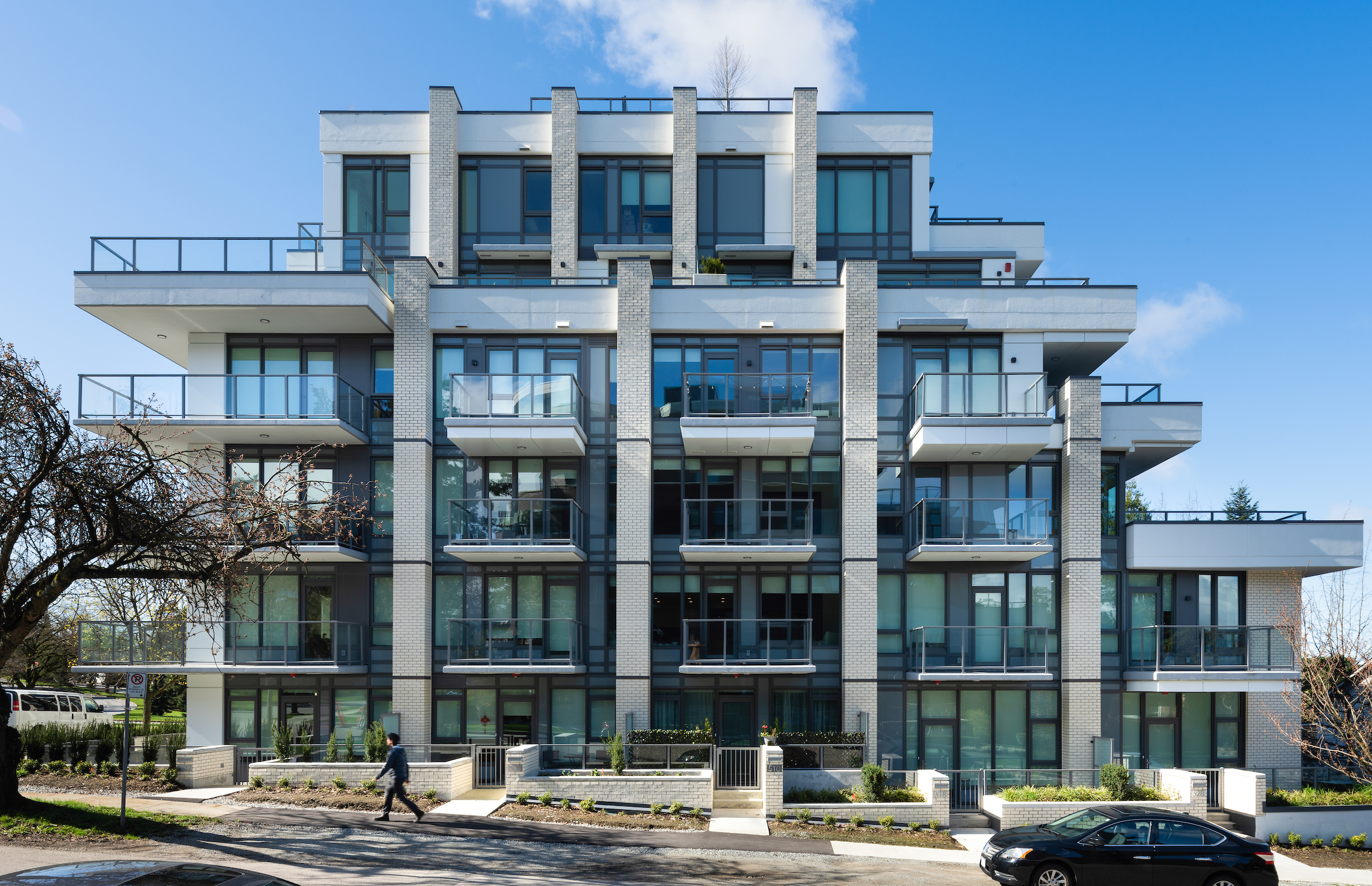 The Universal Series™ Window Wall has a thermally superior fiberglass frame that supports expansive glazing without sacrificing energy efficiency. Its double and triple-glazing options, plus Passive House certification, make it ideal for architects seeking to balance light, insulation and serenity in the heart of the city.
The Universal Series™ Window Wall has a thermally superior fiberglass frame that supports expansive glazing without sacrificing energy efficiency. Its double and triple-glazing options, plus Passive House certification, make it ideal for architects seeking to balance light, insulation and serenity in the heart of the city. Using advanced algorithms to mimic natural light and drifting clouds, the IRIS Luminous SkyCeiling can be used to turn even the darkest interiors into serene escapes. By aligning its daylight cycles with the body’s circadian rhythms, it offers a creative solution for spaces like hospitals, offices or retail environments where access to natural light is limited, but calm is critical.
Using advanced algorithms to mimic natural light and drifting clouds, the IRIS Luminous SkyCeiling can be used to turn even the darkest interiors into serene escapes. By aligning its daylight cycles with the body’s circadian rhythms, it offers a creative solution for spaces like hospitals, offices or retail environments where access to natural light is limited, but calm is critical.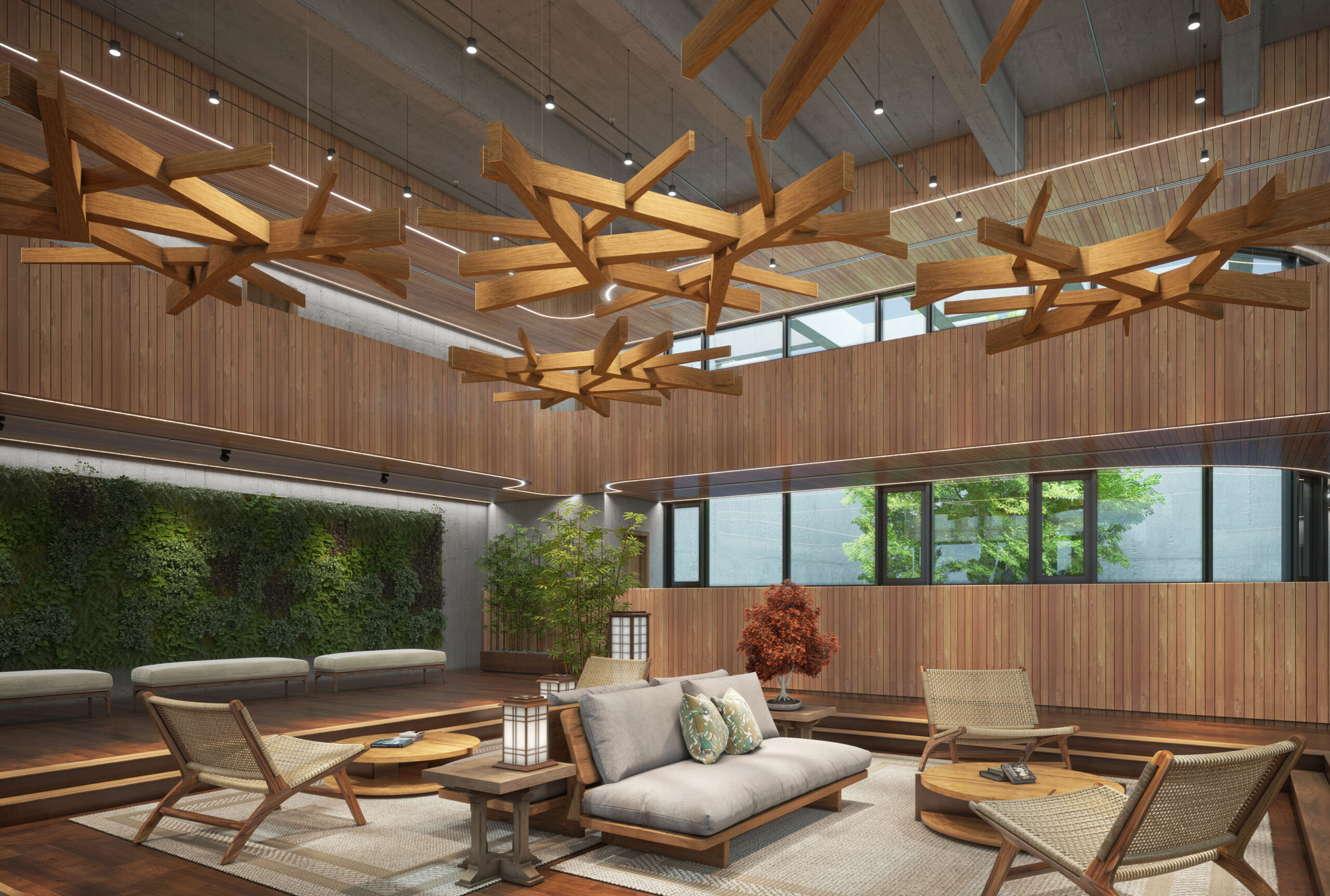 The design of the Arborisa™ acoustic ceiling is inspired by nature and, more specifically, tree canopies. Its intersecting baffles soften sound while introducing organic forms into shared spaces. With a range of modular designs and customizable finishes, the sculptural product is a versatile tool for creating unique interiors where noise is an issue.
The design of the Arborisa™ acoustic ceiling is inspired by nature and, more specifically, tree canopies. Its intersecting baffles soften sound while introducing organic forms into shared spaces. With a range of modular designs and customizable finishes, the sculptural product is a versatile tool for creating unique interiors where noise is an issue.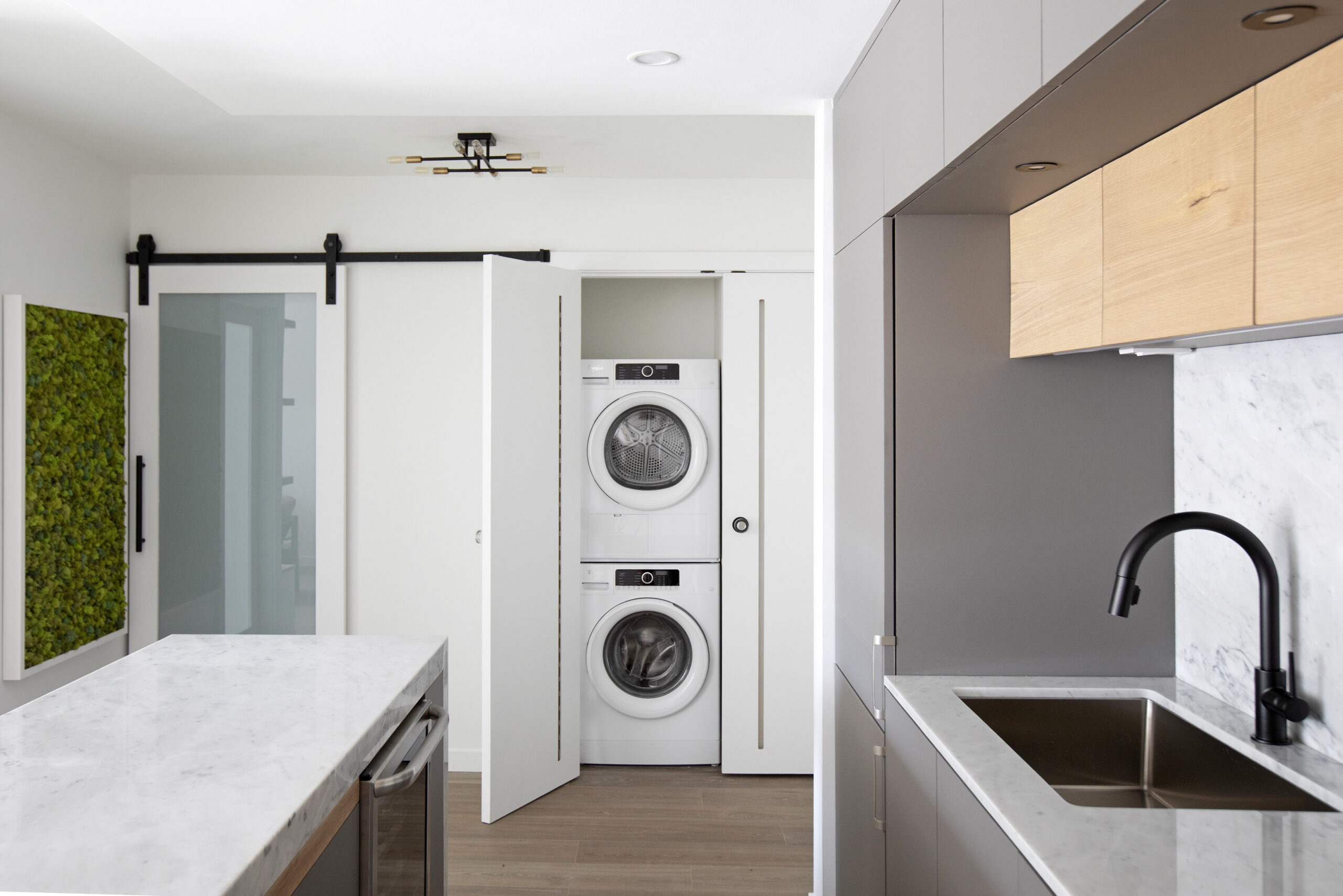 The VanAir Door solves a modern urban dilemma: air circulation without compromise. Its staggered slots improve ventilation and balance humidity while maintaining acoustic privacy with an impressive STC rating of 26. For apartments, offices or multi-use spaces, it’s a quiet innovation that makes urban living healthier.
The VanAir Door solves a modern urban dilemma: air circulation without compromise. Its staggered slots improve ventilation and balance humidity while maintaining acoustic privacy with an impressive STC rating of 26. For apartments, offices or multi-use spaces, it’s a quiet innovation that makes urban living healthier.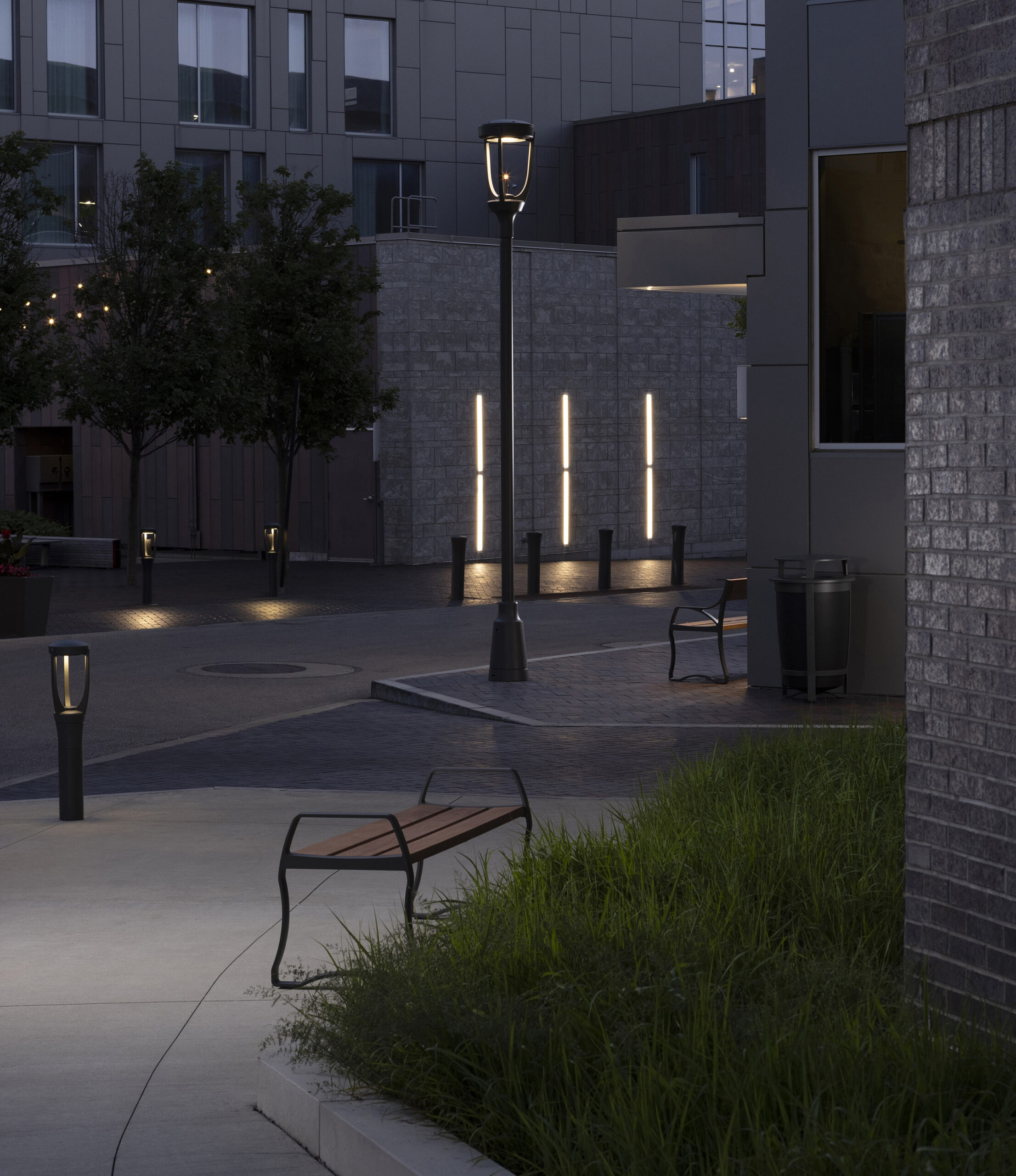 The Northport Lighting collection is a reinterpretation of historical acorn street lamps, layering nostalgia with modern functionality. An optional LED flame creates a gentle flicker, softening streetscapes, parks, or promenades into places that invite pause and reintroduce some historical beauty to our urban environments.
The Northport Lighting collection is a reinterpretation of historical acorn street lamps, layering nostalgia with modern functionality. An optional LED flame creates a gentle flicker, softening streetscapes, parks, or promenades into places that invite pause and reintroduce some historical beauty to our urban environments.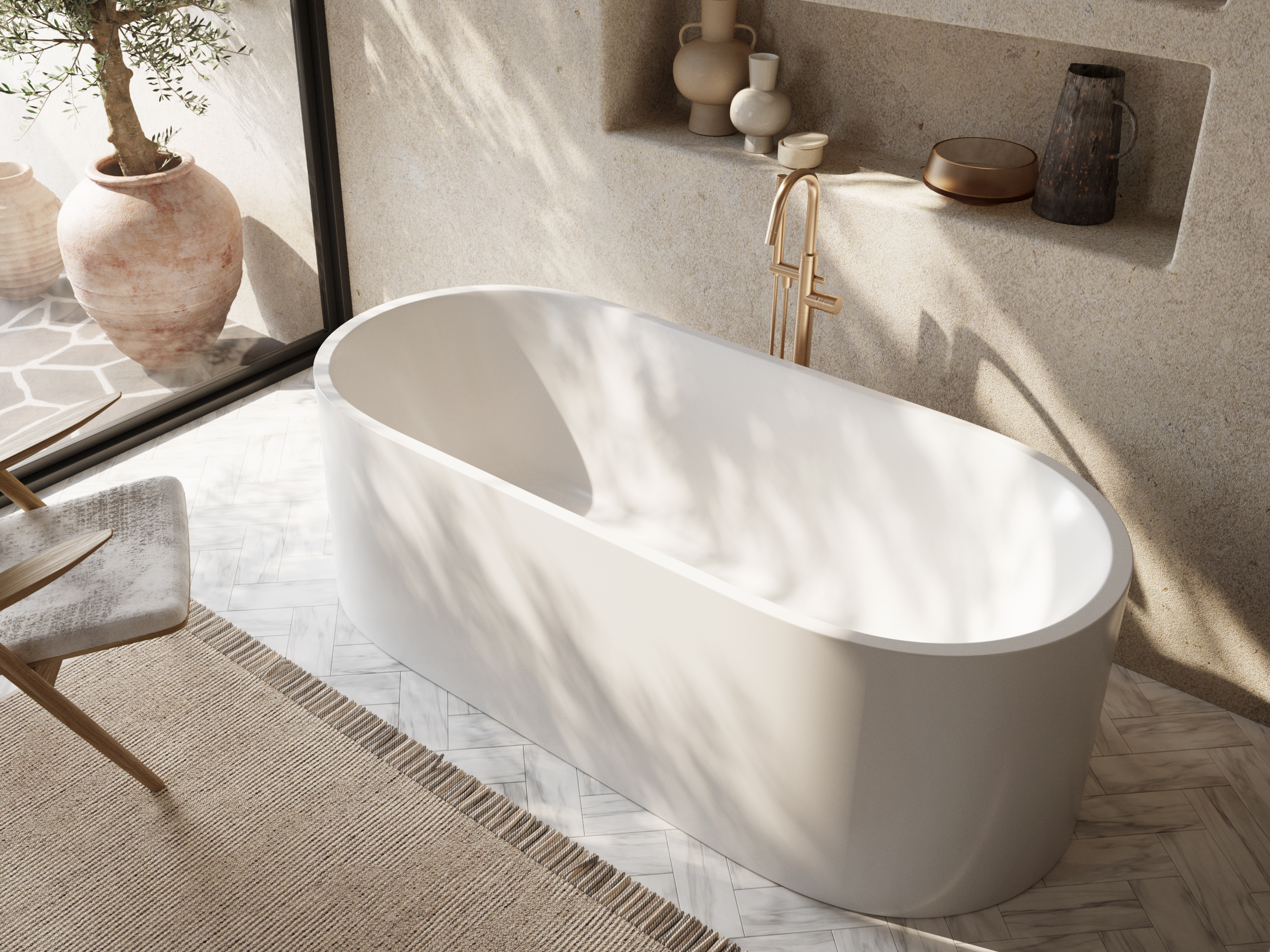 The Lido Freestanding Bathtub channels Miami modernism into a piece designed to be admired. Its ergonomic curves, crafted from HydroLuxeSS™, combine with hydrotherapy options like Cold Plunge to transform private bathrooms into personal retreats. Available in 15 colors, it is brimming with sculptural elegance while providing therapeutic calm.
The Lido Freestanding Bathtub channels Miami modernism into a piece designed to be admired. Its ergonomic curves, crafted from HydroLuxeSS™, combine with hydrotherapy options like Cold Plunge to transform private bathrooms into personal retreats. Available in 15 colors, it is brimming with sculptural elegance while providing therapeutic calm.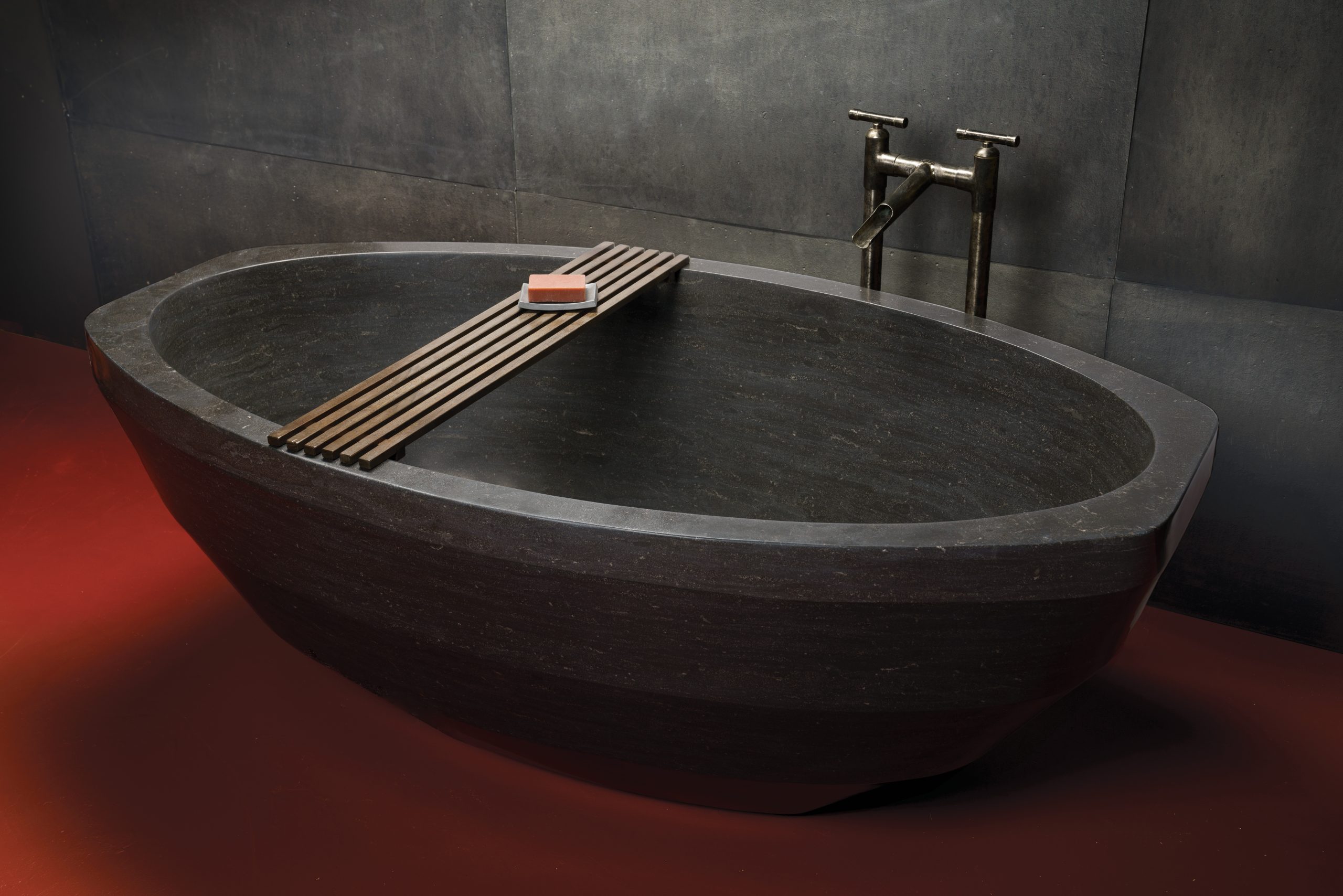 Balancing precision and materiality, the Facet bathtub stone exterior plays with the surrounding light to become a visual delight while its smooth, ergonomic interior is perfectly designed. Carved from Antique Gray Limestone or Noce Basalt, the bath is a grounding focal point for bathrooms where form and function meet in equal measure.
Balancing precision and materiality, the Facet bathtub stone exterior plays with the surrounding light to become a visual delight while its smooth, ergonomic interior is perfectly designed. Carved from Antique Gray Limestone or Noce Basalt, the bath is a grounding focal point for bathrooms where form and function meet in equal measure.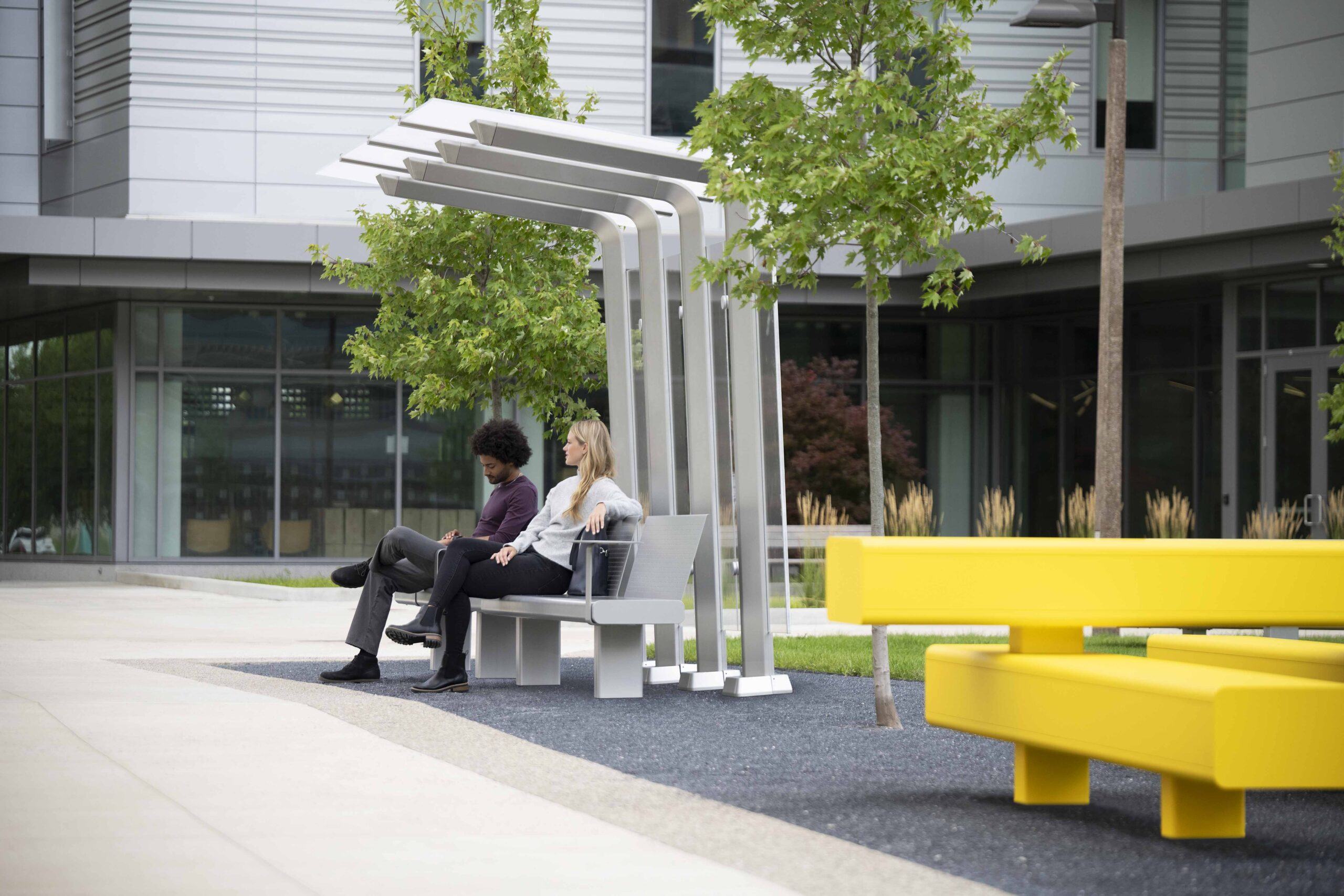 The Theory collection reshapes transitional zones into places of interaction and connection. Its modular system of beams, shelters and seating can be adapted to evolve with the surrounding cityscape by turning functional spaces into intentional environments that support well-being throughout everyday city life.
The Theory collection reshapes transitional zones into places of interaction and connection. Its modular system of beams, shelters and seating can be adapted to evolve with the surrounding cityscape by turning functional spaces into intentional environments that support well-being throughout everyday city life.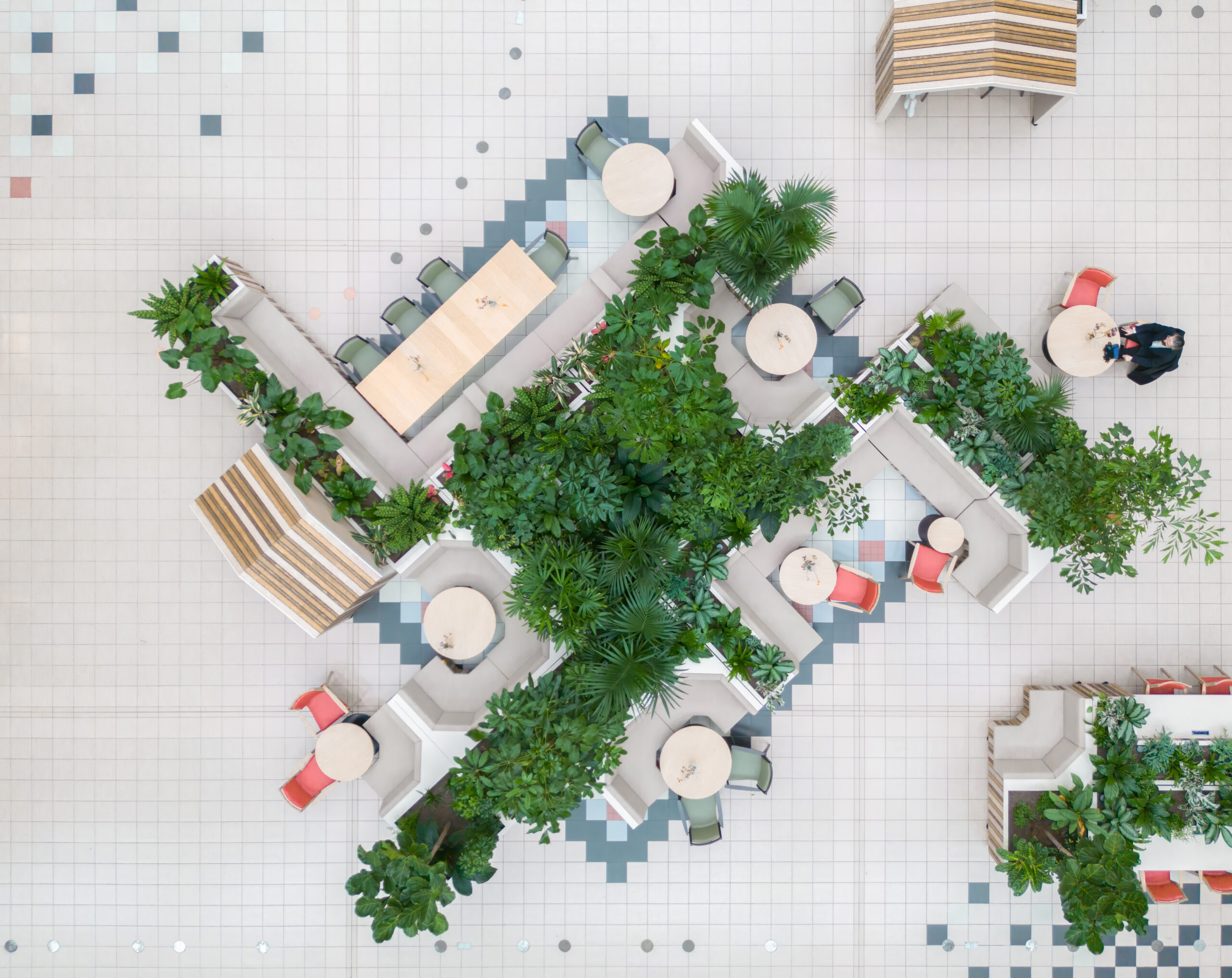 Moving Islands is a perfectly practical and adaptable solution. Designed to create indoor gardens or flexible seating zones, its modular forms are crafted from repurposed materials. In nursing homes, atriums, or event venues, it introduces nature where it’s most needed.
Moving Islands is a perfectly practical and adaptable solution. Designed to create indoor gardens or flexible seating zones, its modular forms are crafted from repurposed materials. In nursing homes, atriums, or event venues, it introduces nature where it’s most needed.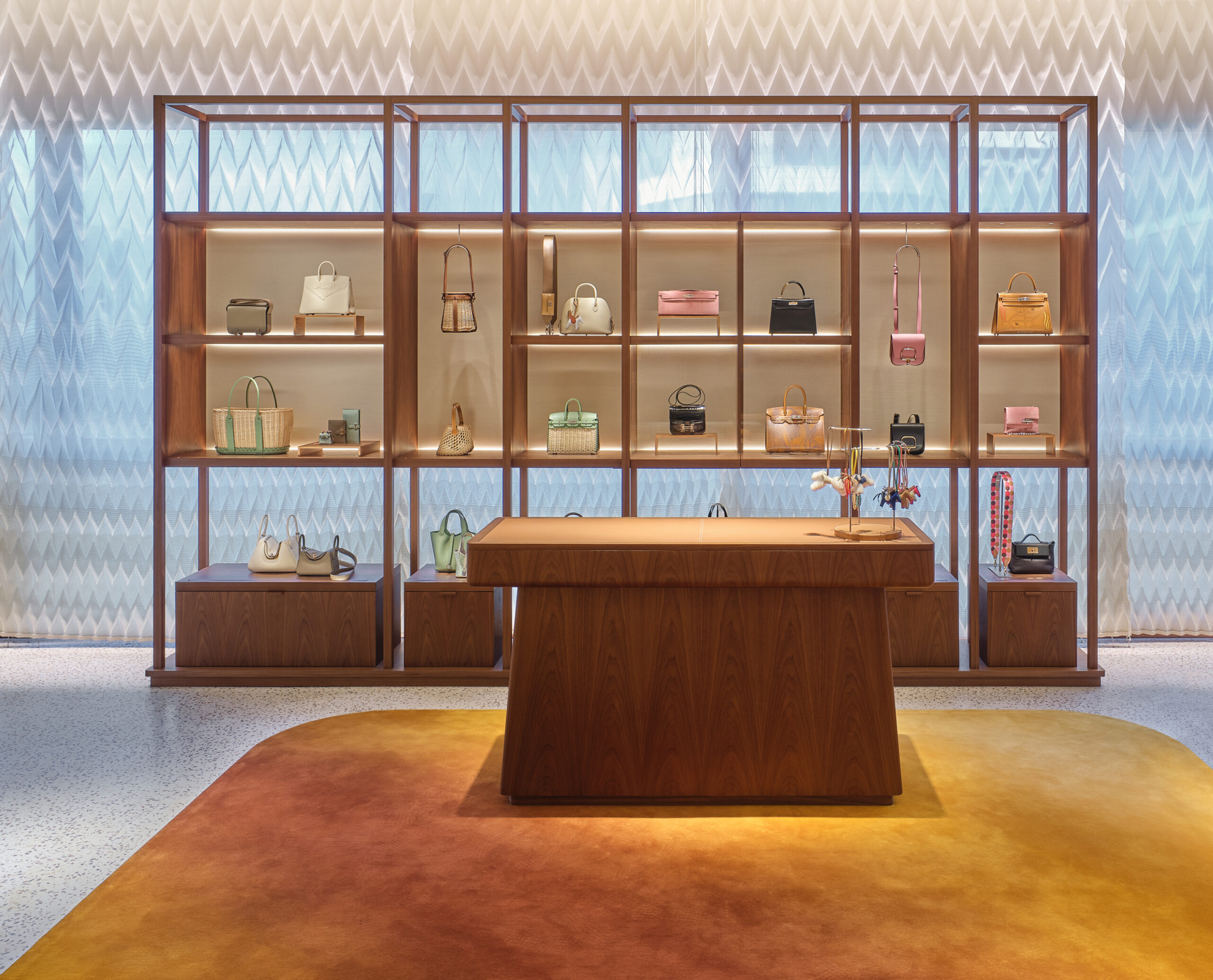 Originally designed for Hermes, the Archi Folds 3D Textile Façade is an elegant solution for softening interiors. Its origami-inspired folds balance daylight, privacy, and acoustics. Crafted from recycled yarns, it offers architects a way to create textured, layered environments while controlling privacy and light saturation.
Originally designed for Hermes, the Archi Folds 3D Textile Façade is an elegant solution for softening interiors. Its origami-inspired folds balance daylight, privacy, and acoustics. Crafted from recycled yarns, it offers architects a way to create textured, layered environments while controlling privacy and light saturation.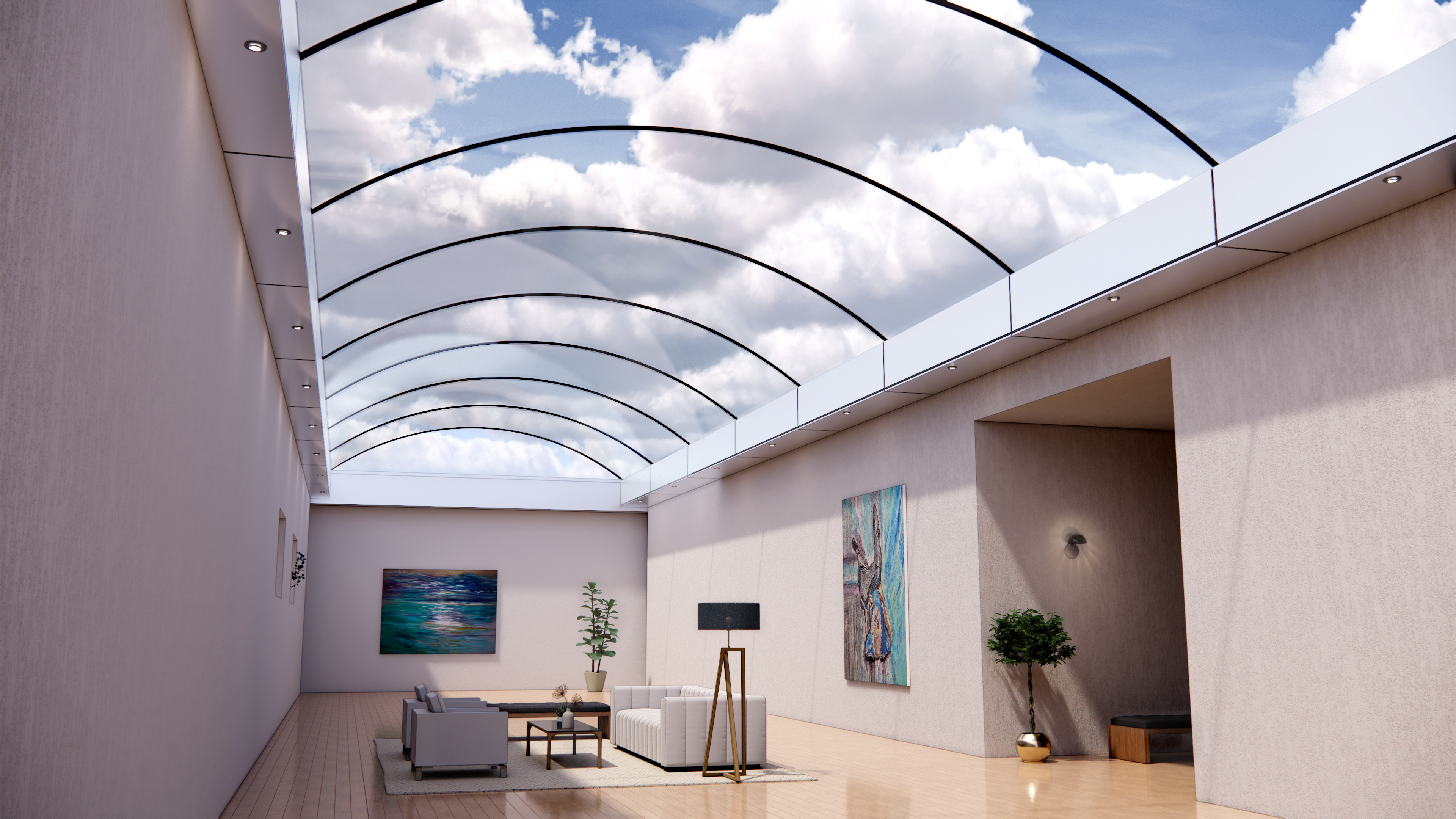 Spanning up to 26 feet, the VetraSky skylight system floods dense spaces with natural light while meeting the rigorous structural demands of curved glass. A transformative tool for architects seeking to bring openness and airiness to the urban core.
Spanning up to 26 feet, the VetraSky skylight system floods dense spaces with natural light while meeting the rigorous structural demands of curved glass. A transformative tool for architects seeking to bring openness and airiness to the urban core.